MODEL
MX-FX13
FACSIMILE EXPANSION KIT
Be sure to become thoroughly familiar with this manual to gain the maximum benefit from the product.
Before installing this product, be sure to read the cautions sections of the Start Guide.
Be sure to keep all operation guides handy for reference including this manual, the Start Guide and Operation Guide for any optional equipment which has been installed.
Telecommunication Line Cable:
Use only the line cable that was provided with the machine.
Notice for Users in Europe
Hereby, SHARP Electronics (Europe) GmbH declares that this Facsimile Expansion Kit MX-FX13 is in compliance with the essential requirements and other relevant provisions of Directive 1999/5/EC.
Par la pr??sente, SHARP Electronics (Europe) GmbH d??clare que l???appareil Facsimile Expansion Kit MX-FX13 est conforme aux exigences essentielles et aux autres dispositions pertinentes de la directive 1999/5/CE.
Hiermit erkl??rt SHARP Electronics (Europe) GmbH, dass sich das Ger??t Facsimile Expansion Kit MX-FX13 in ??bereinstimmung mit den grundlegenden Anforderungen und den ??brigen einschl??gigen Bestimmungen der Richtlinie 1999/5/EG befindet.
?? ???????????????????? SHARP Electronics (Europe) GmbH ??????????????????, ???? Facsimile Expansion Kit MX-FX13 ???????????????? ???? ???????????????????????? ???????????????????? ?? ?????????????? ?????????????????? ???????????????????? ???? ?????????????????? 1999/5/????.
SHARP Electronics (Europe) GmbH t??mto prohla??uje, ??e Facsimile Expansion Kit MX-FX13 spl??uje z??kladn?? po??adavky a v??echna p????slu??n?? ustanoveni Sm??rnice 1999/5/ES.
Undertegnede SHARP Electronics (Europe) GmbH erkl??rer herved, at f??lgende udstyr Facsimile Expansion Kit MX-FX13 overholder de v??sentlige krav og ??vrige relevante krav i direktiv 1999/5/EF.
K??esolevaga kinnitab SHARP Electronics (Europe) GmbH seadme Facsimile Expansion Kit MX-FX13 vastavust direktiivi 1999/5/E?? p??hin??uetele ja nimetatud direktiivist tulenevatele teistele asjakohastele s??tetele.
???? ?????? ?????????????? SHARP Electronics (Europe) GmbH ???????????????? ?????? Facsimile Expansion Kit MX-FX13
??????????????????????????? ???????? ?????? ???????????????????? ???????????????????? ?????? ?????? ???????????? ???????????????? ??????????????????? ?????? ??????????????? 1999/5/????.
Por la presente, SHARP Electronics (Europe) GmbH, declara que este Facsimile Expansion Kit MX-FX13 cumple con los requisitos esenciales y otras exigencias relevantes de la Directiva 1999/5/EC.
SHARP Electronics (Europe) GmbH vakuuttaa t??ten ett?? Facsimile Expansion Kit MX-FX13 tyyppinen laite on direktiivin 1999/5/EY oleellisten vaatimusten ja sit?? koskevien direktiivin muiden ehtojen mukainen.
Con la presente SHARP Electronics (Europe) GmbH dichiara che questo Facsimile Expansion Kit MX-FX13 ?? con-forme ai requisiti essenziali ed alle altre disposizioni pertinenti stabilite dalla direttiva 1999/5/CE.
Alul??rott, SHARP Electronics (Europe) GmbH nyilatkozom, hogy a Facsimile Expansion Kit MX-FX13 megfelel a vonatkoz?? alapvet?? k??vetelm??nyeknek ??s az 1999/5/EC ir??nyelv egy??b el????r??sainak.
Ar ??o SHARP Electronics (Europe) GmbH deklar??, ka Facsimile Expansion Kit MX-FX13 atbilst Direkt??vas 1999/5/EK b??tiskaj??m pras??b??m un citiem ar to saist??tajiem noteikumiem.
??iuo SHARP Electronics (Europe) GmbH deklaruoja, kad ??is Facsimile Expansion Kit MX-FX13 atitinka esminius reikalavimus ir kitas 1999/5/EB Direktyvos nuostatas.
Hierbij verklaart SHARP Electronics (Europe) GmbH dat het toestel Facsimile Expansion Kit MX-FX13 in overeenstemming is met de essenti??le eisen en de andere relevante bepalingen van richtlijn 1999/5/EG.
Niniejszym SHARP Electronics (Europe) GmbH deklaruje ??e Facsimile Expansion Kit MX-FX13 jest zgodny z zasadniczymi wymaganiami i innymi w??a??ciwymi postanowieniami Dyrektywy 1999/5/EC.
Prin prezenta, SHARP Electronics (Europe) GmbH, declar?? c?? aparatul Facsimile Expansion Kit MX-FX13 este ??n conformitate cu cerin??ele esen??iale ??i cu alte prevederi pertinente ale Directivei 1999/5/CE.
SHARP Electronics (Europe) GmbH t??mto vyhlasuje, ??e Facsimile Expansion Kit MX-FX13 sp????a z??kladn?? po??iadavky a v??etky pr??slu??n?? ustanovenia Smernice 1999/5/ES.
SHARP Electronics (Europe) GmbH izjavlja, da je ta Facsimile Expansion Kit MX-FX13 v skladu z bistvenimi zahtevami in drugimi relevantnimi dolo??ili direktive 1999/5/ES.
H??rmed intygar SHARP Electronics (Europe) GmbH att denna Facsimile Expansion Kit MX-FX13 st??r I ??verensst??mmelse med de v??sentliga egenskapskrav och ??vriga relevanta best??mmelser som framg??r av direktiv 1999/5/EG.
SHARP Electronics (Europe) GmbH erkl??rer herved at utstyret Facsimile Expansion Kit MX-FX13 er i samsvar med de grunnleggende krav og ??vrige relevante krav i direktiv 1999/5/EF.
This equipment has been designed to work on the British analogue public switched telephone network. This equipment has been tested according to the pan-European ES 203 021 regulation.
It will operate on all analogue telephone networks which comply with the ES 203 021.
Please contact your dealer or network operator, if you are not sure whether your network operates according to ES 203 021.

INTRODUCTION
Thank you for purchasing this product. This manual only explains the facsimile functions of the product. For safety precautions and general information on using the machine such as loading paper, clearing misfeeds, and handling peripheral units, see the Operation Guide for the machine.
For other functions, see the following manuals as appropriate:
Copier function/Printer function: See the Operation Guide.
Network printer function/Network scanner function: See the "Operation Guide(for Network Expansion kit)" (if the Network Expansion kit option is installed).
The explanations in this manual assume that certain optional peripheral units are installed.
This manual refers to the Reversing single pass feeder as the "RSPF" and the single pass feeder as the "SPF". Unless specific mention is made, both the RSPF and the SPF are referred to simply as "SPF".
The fax function is not available in some countries and regions.
CONNECTING AN EXTENSION PHONE
You can connect a telephone to the machine and use it as an extension phone to place and receive calls like any normal phone. Fax reception can also be activated from an extension phone connected to the machine. (remote operation)
??? You can place calls from the phone even during a power failure.
CONNECTING AN EXTENSION PHONE
1 Insert the end of the extension phone cord into the extension phone jack on the left side of the machine.
TO USE THIS PRODUCT CORRECTLY AS
A FACSIMILE
Several points must be kept in mind when using this product as a facsimile.
Please note the following.
Line connection
For Australia
For New Zealand
Power switch
Keep the machine power switch turned on at all times. Do not turn off the power. If the power is turned off, the fax function cannot be used.
When the power is off, the machine cannot receive faxes. Before turning off the power, make sure the machine is idle. If the power is turned off while the machine is in operation, a paper jam may occur. If settings are being configured, the settings will be cancelled.
Power switch
Setting the date and time and programming your sender's name and number
Before using the fax function, you must set the date and time and program your sender's name and number in the machine. This procedure is explained in "POINTS TO CHECK AND PROGRAM AFTER INSTALLATION" on page 6 of this manual.
TO USE THIS PRODUCT CORRECTLY AS A FACSIMILE
Lithium battery
A lithium battery in the machine is used to retain settings and programmed information such as auto-dial numbers (page 66).
???When the battery dies, settings and programmed information will be lost, so please keep a record of this information. (See "PRINTING LISTS OF PROGRAMMED INFORMATION, SETTINGS, AND COMMUNICATION ACTIVITY" on page 85.)
???The life of the battery is approximately 5 years when the power switch is kept continuously off.
???When the battery dies, please contact your local Sharp dealer or authorised service representative for assistance in disposing of this battery. The machine will not operate once the battery dies.
Please note
In the event of a thunderstorm, remove the power cord from the power outlet to ensure safety. Information will be retained in memory even if the power cord is unplugged.

This chapter contains basic information about using the fax function of the machine. Please read this chapter before using the fax function.
POINTS TO CHECK AND PROGRAM
AFTER INSTALLATION
After installing the machine and before using it as a fax machine, check the following points and program the required information.
Set the date and time
The machine has an internal clock. It is important to set the correct date and time because they are used for such features as Timer Transmission (page 33).
The date and time are set in the system settings. (Page 104)
The date and time appear in the display. Make sure the correct date and time appear. If the date and time are wrong, please correct them.
Program the sender's name and sender's number
The name and fax number of the user of the machine is programmed in "OWN PASSCODE SET" (page 101) in the system settings. (Only one name and number can be programmed.)
The programmed name and number are printed at the top of each transmitted fax page. The sender's number is also used as an identification number when you use the Polling function to request transmission from another fax machine (see "USING THE POLLING FUNCTION" on page 36).
You can check your programmed name and number by printing out the "Administrator Settings List" in the system
Paper sizes that can be used for fax mode
The machine can use A3, B4, A4, A4R, B5, B5R, A5, 11" x 17", 8-1/2" x 14", 8-1/2" x 11", 8-1/2" x 11"R, and 5-1/2" x 8-1/2"* size paper; however, 11" x 17", 8-1/2" x 14" and 5-1/2" x 8-1/2" size paper cannot be used in fax mode. (Among INCH sizes, only 8-1/2" x 11" and 8-1/2" x 11"R can be used.) (If your machine uses inch-based paper sizes, A3, B4, B5, B5R, and A5 size paper cannot be used in fax mode. (Among AB sizes, only A4 and A4R can be used.)) For this reason, if only paper sizes that can be used in other modes but not in fax mode are loaded in the machine, received faxes cannot be printed. (For other points regarding fax reception, see "RECEIVING FAXES" page 27.)
*A5 (5-1/2" x 8-1/2") size paper can only be loaded in tray 1, regardless of the mode. A5 (5-1/2" x 8-1/2") paper cannot be loaded in tray 2 or in the optional 250-sheet paper feed unit or 2 x 250-sheet paper feed unit.
BEFORE USING THE FAX FUNCTION
GHI JKL MNO
BACK OK
PQRS TUV WXYZ
@.-_
(13)[MODE SELECT] keys (step 1 on page 17)
These are used these keys to change modes.
(14)[SPECIAL FUNCTION] key
This key is used to select a special transmission or reception function, configure function settings, and to store auto-dial numbers.
(15)[PROGRAM] key (page 44)
Press this key to use a program.
(16)[RESOLUTION] key (page 14)
This key is used to select resolution and exposure settings.
(17)[ADDRESS] key (page 20)
This key is used to search for a fax destination that has been stored as an auto-dial number in the address book.
(18)[BROADCAST] key (page 31)
This is used to perform a broadcast transmission.
(19)[ORIGINAL SIZE] key (page 13)
This is used to set the size of the original to be faxed.
(20)[DUPLEX SCAN] key (page 21)
Press this key to use the duplex scan function. (Only on models with a RSPF installed.)
(21)Arrow keys (


 )
)
These are used to select items and move through pages.
(22)[CA] key
This is used to cancel a transmission or programming operation. When pressed during an operation, the operation is cancelled and the display returns to the base screen described on page 9. This key is also used to cancel a resolution, paper size, or special function setting that was selected when sending a fax.
(23)[START] key (  )
)
This is used at the following times:
(1)When starting transmission
(2)When scanning an original
(3)When starting manual reception
(4)When configuring and storing settings
??? When the auto power shut-off function is Note activated, all indicators except the
[START] key indicator go off. For the information on the auto power shut-off function, see the Operation Guide for the machine.
???For information on the keys and lights which are used for the copy function and other functions, see "Operation Panel" in the manual for each function.
BEFORE USING THE FAX FUNCTION
FAX MODE (BASE SCREEN)
The base screen of fax mode is displayed by pressing the [FAX] key when the print mode, copy mode, or scan mode screen appears.
The base screen of fax mode
The following functions operate even when copy mode is selected:
Note ??? Automatic reception (including F-code confidential reception)
???Timer Transmission
???Memory polled function
???Transmission of stored memory transmission jobs
???Voice calls (voice calls can be answered but not placed).
???Remote reception
???Manual reception
???Relay station function for F-code relay broadcast transmission
BEFORE USING THE FAX FUNCTION
AUDITING MODE
Accounts that can transmit faxes (up to 50) can be established and transmission time and other information can be tracked for each account. The Acc. Usage List (page 99) can be printed out which shows the time used for transmission and pages transmitted by each account.
??? This function is enabled using "ACCOUNT CONTROL" and "ACCOUNT # SET" in the system settings. (Page 103)
Using auditing mode
When auditing mode is turned on, the account number entry screen is displayed. Enter your account number (five-digit identification number) as explained below before performing a fax operation.
Enter your account number.
ACCOUNT #:-----
1 Enter your account number (five digits) with the numeric keys.
???As the account number is entered, the hyphens "-" change to asterisks "  ". If you enter an incorrect digit, press the [C] key and re-enter the correct digit.
". If you enter an incorrect digit, press the [C] key and re-enter the correct digit.
???After you enter your account number, the base screen of fax mode appears. (Page 9)
??? If you enter an account number for copy Note mode has also been programmed for fax mode, you can change to fax mode after
completing the copy operation and continue with the fax operation without re-entering your account number.
If you enter an account number for copy mode that has not been programmed for fax mode, enter your account number for fax mode after you press the [FAX] key to change to fax mode.
???When "ACC. # SECURITY" in the system settings (see the "System settings guide" in the Operation Guide for the machine.) is enabled, the message "Please see your administrator for assistance." will appear for one minute in the event that you enter an incorrect or invalid account number three times in a row. During that time operation of the machine will not be possible.
2 When you have completed the fax operation, press the [ACC.#-C] key ( ).
).
@.-_
ORIGINALS
ORIGINALS THAT CAN BE FAXED
Original sizes
??? Originals that are not a standard size (A5, A4, A4R, B4, A3, 8-1/2" x 11", 8-1/2" x 11"R (5-1/2" x 8-1/2", 5-1/2" Note x 8-1/2"R, 8-1/2" x 11", 8-1/2" x 11"R, 8-1/2" x 14", 11" x 17", A4, A4R if the machine uses inch-based paper
sizes)) can also be faxed.
???There are restrictions on originals that can be scanned using the SPF/RSPF. For more information, see "NORMAL COPYING" in the Operation Guide for the machine.
*Long originals
Depending on the resolution setting and the width of the original, there may not be sufficient space in memory to hold a long original. When a long original cannot be entirely scanned, select a lower resolution setting and/or shorten the original.
Scanning area of original
When faxing an original, note that the edges of the original cannot be scanned.
Width of edges that cannot be scanned:
5 mm from top and bottom edges, 6 mm (or less) from left and right edges
 5 mm
5 mm
 5 mm
5 mm
 Total of 6 mm or
Total of 6 mm or  less
less
Automatic reduction of faxed document
If the size (width) of the faxed document is greater than the receiving machine's paper size, the size will be automatically reduced.
You can turn off automatic reduction. In this case, the left and right edges will not be transmitted. (See "AUTO REDUCE TX" on page 105.)
PLACING THE ORIGINAL
An original can be placed in the SPF/RSPF or on the document glass. Use the SPF/RSPF when faxing a large number of sheet originals. Use the document glass to fax originals that cannot be scanned using the SPF/RSPF such as thick or thin sheet originals, or books or other bound originals.
USING THE SPF/RSPF
1 Open the SPF/RSPF, make sure that an original has not been left on the document glass, and then gently close the SPF/RSPF.
2 Adjust the original guides on the document feeder tray to the width of the document.
3 Align the edges of the document pages and then insert the stack in the document feeder tray so that the first page is face up.
??? Insert the originals all the way into the document feeder tray.
??? Make sure the stack does not exceed the indicator line (maximum of 40 sheets, or 30 sheets of 90 g/m2 (24 lbs.) paper, thickness 4 mm (5/32") or less).
may cause misfeeds.
???Use the SPF/RSPF for long originals. The document glass cannot be used.
???When inserting a long original, the original should be in contact with the surface of the document feeder tray. If the original is not in contact with the surface of the document feeder tray, an incorrect original size may be detected.
1 Open the SPF/RSPF, place the original face down on the document glass, and then gently close the SPF/RSPF.
???If auto power shut-off has activated, press the [START] key, wait until the machine has returned to normal operation, and then place the original.
???When transmitting a small original such as a postcard, be sure to press the [ORIGINAL SIZE] key and set the original size. (Page 13)
Regardless of the size of the original, place the original in the far left corner of the document glass. (Align the upper left-hand corner of the original with the tip of the  mark.) Place the original in the appropriate position for its size as shown below.
mark.) Place the original in the appropriate position for its size as shown below.
A5
A4R R
B4
A4A3
The difference between A4 (8-1/2" x 11") and A4R (8-1/2" x 11"R)
This manual uses both A4 (8-1/2" x 11") and A4R (8-1/2" x 11"R) to indicate paper and original sizes. The "R" is used to distinguish the orientation of originals and paper. ("R" is used for this purpose for other sizes as well.)
[Example] Difference between the orientations of A4 (8-1/2" x 11") size and A4R (8-1/2" x 11"R) size
A4 (8-1/2" x 11") indicates an original placed as follows:
A4R (8-1/2" x 11"R) indicates an original placed as follows:
CHECKING THE SIZE OF A PLACED ORIGINAL
When a standard-size* original is placed, the original size is automatically detected (automatic original detection function) and displayed in the original display. Make sure that the size has been detected correctly.
(1)When an original is placed, an icon appears to indicate the original scanning mode.
:One-sided scanning in the SPF.
:Scanning on the document glass
:Two-sided scanning in the RSPF.
(2)Displays the original size.
If a non-standard size original is placed or if you wish to change the scanning size, follow the steps below to manually set the original scanning size.
*Standard sizes
special sizes), the closest standard size may be displayed, or the original size may not appear at all.
In Taiwan, the following standard original sizes are detected by the automatic original detection function: A3, B4, A4, A4R, B5, B5R, A5.
MANUALLY SETTING THE SCANNING SIZE
If you load an original that is not a standard size (such as a long original), or if the size is not detected correctly, be sure to press the [ORIGINAL SIZE] key and set the original size manually.
Perform the following steps after placing the original in the document feeder tray or on the document glass (page 12).
If a size is specified that is different from the actual original size when scanning a two-sided original in the RSPF,
1 Press the [ORIGINAL SIZE] key.
You will return to the base
GHI screen and the selected original  size will appear in the original
size will appear in the original
PQRS display.
2 Select the original size with the [ ] or [
] or [ ] key.
] key.
To select an INCH size, press the [ ] key and go to step 4.
] key and go to step 4.
Selecting an INCH original size
4 Select the original size with the [  ] or [
] or [  ] key.
] key.
ORIGINAL SIZE
INCH
AUTO 812 x11 812 x11R
To return to selection of AB original sizes, press the [ ] key and return to step 2.
] key and return to step 2.
5 Press the [OK] key.
When the [ ] key is pressed, the original size selection screen for INCH sizes appears.
] key is pressed, the original size selection screen for INCH sizes appears.
ORIGINAL SIZE
INCH
AUTO
812 x11
812 x11R
To cancel a manual original scanning size Note setting, press the [CA] key.
If it is not possible to select the actual original size, select a size that is larger than the actual original size. If a smaller size is selected, part of the original will not be transmitted.
SELECTING RESOLUTION AND EXPOSURE SETTINGS
The resolution and exposure can be adjusted to match the size and darkness of text on the original, or for an original such as a photograph. To change the settings, follow the steps below after selecting fax mode and placing the original. (Page 12)
1 Press the [RESOLUTION] key.
 You will return to the base GHI screen and the selected
You will return to the base GHI screen and the selected
 resolution will appear in the PQRS resolution display.
resolution will appear in the PQRS resolution display.
The resolution selection screen will appear.
4 Select the desired exposure with the
2 Select the resolution with the [ ] or [
] or [ ] key.
] key.
[ ] or [ ] key.
RESOLUTION
STANDARD
FINE
SUPER FINE
Use this setting for originals with normal-size text.
Use this setting for originals with small letters or detailed drawings. The original will be scanned at twice the resolution of Standard.
Use this setting for originals with
intricate drawings or diagrams. A higher-quality image will be produced than with the Fine setting.
Use this setting for originals with intricate drawings or diagrams. This setting gives the best image quality. However, transmission will take longer than with the other settings.
Use halftone if your original is a (FINE/HALF photograph or has gradations of
TONE) colour (such as a colour original). (S-FINE/HALF This setting will produce a clearer
TONE) image than "FINE", "SUPER FINE", (U-FINE/HALF or "ULTRA FINE" used alone.
TONE) When halftone is selected, transmission will take longer.
To set the exposure next, press the [ ] or [
] or [ ] key and go to step 4.
] key and go to step 4.
RESOLUTION
STANDARD
FINE
SUPER FINE
When the [ ] or [
] or [ ] key is pressed, the exposure display changes from "AUTO" to a 5-step display.
] key is pressed, the exposure display changes from "AUTO" to a 5-step display.
???Even if you send a fax using a high resolution setting such as "FINE", "SUPER FINE", or "ULTRA FINE", some receiving fax machines may print the fax at a lower resolution.
???To cancel a resolution or exposure selection, press the [CA] key.

CONVENIENT DIALLING METHODS (AUTO-DIALLING)
The fax function includes a convenient auto dial feature (Rapid dialling, speed dialling and group dialling). By programming frequently dialled numbers, you can call and send faxes to these locations by means of a simple dialling operation (page 19). There are three types of auto-dialling: Rapid dialling, speed dialling, and group dialling. To program auto-dial numbers, see page 66.
???Faxes must be sent manually when using on-hook dialling. (Page 23)
???On-hook dialling is not possible using a Rapid key that includes a sub-address and passcode, or a group dial key.
??? A combined total of 50 Rapid dial and group dial keys can be stored, and 300 speed dial destinations can be Note stored.
???Stored Rapid keys, group keys, and Speed dial destinations can be called up using a search name entered when the key or destination was stored. (Page 20)
???To prevent dialling a wrong number and sending a fax to an incorrect destination, check the message display carefully when you store the number. You can also check stored numbers by printing out the programmed information after storing the number (page 85).
This chapter explains the basic procedures for sending and receiving faxes.
There are three basic methods for fax transmission: memory transmission, direct transmission, and manual transmission. When memory transmission is used, the document is temporarily stored in memory before being transmitted. When direct transmission or manual transmission is used, the document is transmitted without being stored in memory, The default transmission setting can be set to "MEMORY TX" or "DIRECT TX" using "SEND MODE" (page 106) in the system settings. To manually switch between "MEMORY TX" and "DIRECT TX", use the [COMM. SETTING] key. (See "Faxing by direct transmission" on page 22.)
The following explanations generally assume that memory transmission is being used.
SENDING A FAX
BASIC PROCEDURE FOR SENDING FAXES
1 Make sure that the machine is in fax mode.
been enabled for the fax function in the system settings, a
message will appear prompting you to enter your account number when you switch to fax mode. Enter your account number (5 digits) with the numeric keys. (See "ACCOUNT CONTROL" on page 103.)
2 Place the original(s) in the document feeder tray or on the document glass.
???Using the SPF/RSPF: page 12
???Using the document glass: page 12
If you are using the document glass to send multiple pages, place the first page first.
You cannot place originals both in the Note SPF/RSPF and on the document glass and
send them in a single fax transmission.
3 Check the original size. If the original is not a standard size or the size was not detected correctly, press the [ORIGINAL SIZE] key.
AUTO
A3
B4
When the [ORIGINAL SIZE] key is pressed, the size selection screen appears. See "MANUALLY SETTING THE SCANNING SIZE" (page 13) to set the original size.
4 If needed, adjust the resolution and exposure settings. (Page 14)
STANDARD
FINE
SUPER FINE
AUTO
5 Dial the fax number.
*The duration of each pause can be changed inthesystem settings. (See "PAUSE TIME" on page 100.)
Group keys cannot be used for chain
Note dialling.

Using the SPF/RSPF
6 Press the [START] key (  ).
).
???Scanning begins.
???If the line is free, the machine will dial the receiving machine and begin transmission as soon as the first page is scanned. (Quick online transmission: page 24)
???If there is a previously stored job or a job is in progress, or if the line is being used, all pages of the original are scanned into memory and stored as a transmission job. (This is called memory transmission: the destination is automatically called and the document transmitted after previously stored jobs are completed.)
Using the document glass
6 Press the [START] key (  ).
).
Scanning begins.
7 If you have another page to scan, change pages and then press the [START] key (  ).
).
[START]:CONTINUE [#]:READ-END
???Repeat this sequence until all pages have been scanned.
???You can change the resolution and exposure settings as needed for each. (page 14)
???If no action is taken for one minute (the [START] key
(  ) is not pressed), scanning automatically ends and the transmission job is stored. (This function can be disabled in the system settings.)
) is not pressed), scanning automatically ends and the transmission job is stored. (This function can be disabled in the system settings.)
8 After the last page is scanned, press the [READ-END] key ( ).
).
Open the SPF/RSPF and remove the original. When the original is removed or any key operation is performed, the display returns to the base screen. (The destination is automatically called and the document transmitted after any previously stored jobs are completed.)
???A job number (3 digits) appears in the display with "READ END" when memory transmission is performed. If you make a note of this number after performing a broadcast transmission, you can use the number to check the results of the transmission in the transaction report or activity report.
???If the power is turned off or a power failure occurs while an original is being scanned in the SPF/RSPF, the machine will stop and an original misfeed will occur. After power is restored, remove the original as explained in "MISFEED IN THE SPF/RSPF" in the Operation Guide for the machine.
BASIC OPERATIONS
TRANSMISSION BY AUTO-DIALLING (RAPID
DIALLING AND GROUP DIALLING)
Fax numbers can be dialled by automatic dialling (Rapid dialling and group dialling) instead of pressing the numeric keys. Follow the steps below to send a fax using an auto dial number. To use an auto dial number, the name and fax number of the destination must first be stored. See page 15 for information on auto-dialling and page 66 for information on programming auto-dial destinations.
1 Perform steps 1 to 4 of "BASIC
PROCEDURE FOR SENDING FAXES" (page 17).
2 Press the Rapid key or group key for the desired destination.
The name programmed for the destination can be displayed by pressing the Rapid key.
PROCEDURE FOR SENDING FAXES" (page 18).
If an original has been placed, scanning of the original will begin automatically without the need to press the [START] key in step 6 on page 18.
SENDING A FAX BY SPEED DIALLING
In addition to Rapid dialling and group dialling, you can also send a fax by pressing the [SPEED] key and entering a 3-digit Speed Dial number. Follow the steps below to send a fax by Speed Dialling. The 3-digit Speed Dial number is entered with the numeric keys when programmed. (See "STORING, EDITING, AND DELETING AUTO DIAL NUMBERS AND PROGRAMS" on page 66.)
3 Enter the 3-digit Speed Dial number with numeric keys.
???If you make a mistake, press the [C] key and then enter the correct number. If you enter a 3-digit number that is not programmed in the machine, press the [C] key and then enter the correct number. If you do not know the Speed Dial number, print out the "SPEED # LIST". (See "PRINTING LISTS OF
PROGRAMMED INFORMATION, SETTINGS, AND COMMUNICATION ACTIVITY" on page 85.)
4 Continue from step 6 of "BASIC
PROCEDURE FOR SENDING FAXES" (page 18).
??? To cancel transmission
Note To cancel transmission while "READING" appears or before the  key is pressed, press the [C] or [CA] key. To cancel a transmission job that is already stored, press the [FAX STATUS] key and cancel the job as explained on (page 25).
key is pressed, press the [C] or [CA] key. To cancel a transmission job that is already stored, press the [FAX STATUS] key and cancel the job as explained on (page 25).
???A job number (3 digits) appears in the display with "READ END" when transmission is performed. If you make a note of this number after performing a broadcast transmission, you can use the number to check the results of the transmission in the transaction report or activity report.
BASIC OPERATIONS
SEARCHING FOR A PROGRAMMED DESTINATION
(USING THE [ADDRESS] KEY)
At the time of dialling, you can enter letters to search for a destination stored in a Rapid key, Speed Dial number, or Group key.
1 Perform steps 1 to 4 of "BASIC
PROCEDURE FOR SENDING FAXES" (page 17).
2 Press the [ADDRESS] key.
ABC
The search letter entry screen appears.
5 Select the desired destination with the [ ] or [
] or [ ] key.
] key.
???The search results appear in the following order: upper case letters, lower case letters, special characters, and numbers.
???If not all letters of the destination name appear, press the  key to display the full name. Press the
key to display the full name. Press the  key once again to return to the original screen.
key once again to return to the original screen.
3 Enter the search letters with the letter entry keys (page palette) (you can also skip entry of search letters and go directly to the next step to display the first destination in the address list).
Up to 10 of the following types of characters can be entered.
Upper case letters, lower case letters, numbers, special characters (See "ENTERING CHARACTERS" on page 86.)
Enter numbers with the numeric keys.
4 Press the [OK] key.
6 Press the [OK] key.
7 Continue from step 6 of "BASIC
PROCEDURE FOR SENDING FAXES" (page 18).
press the [C] or [CA] key. To cancel a transmission job that is already stored, press the [FAX STATUS] key and cancel the job as explained on page 25.
???A job number (3 digits) appears in the display with "READ END" when transmission is performed. If you make a note of this number after performing a broadcast transmission, you can use the number to check the results of the transmission in the transaction report or activity report.
BASIC OPERATIONS
FAXING A TWO-SIDED ORIGINAL (MX-M182D/MX-M202D/MX-M232D)
Follow the steps below to automatically transmit both sides of a two-sided original. (This is only possible on models that have an RSPF installed.)
Do not use an original that is not a standard size (A3, B4, A4, A4R, A5, 8-1/2" x 11", 8-1/2" x 11"R (11" x 17", Note 8-1/2" x 14", 8-1/2" x 11", 8-1/2" x 11"R, A4, A4R if the machine uses inch-based paper sizes)).
Otherwise a scanning error or cut-off image may result.
1 Make sure that the machine is in fax mode.
G
has been enabled for the fax function in the system settings, a message will appear prompting
you to enter your account number when you switch to fax mode. Enter your account number (five digits) with the numeric keys. (See "ACCOUNT CONTROL" on page 103.)
2 Place the original(s) in the document feeder tray. (See "USING THE
SPF/RSPF" on page 12.)
3 Check the original size.
AUTO
A3
B4
When the [ORIGINAL SIZE] key is pressed, the size selection screen appears. If the original size was not correctly detected, see "MANUALLY SETTING THE SCANNING SIZE" (page 13) and set the correct original size.
4 Press the [DUPLEX SCAN] key.
CAST ORIGINAL SIZE DUPLEX SCAN
1-SIDED
2-SIDED
The duplex mode selection screen appears.
5 Select "2-SIDED" with the [ ] or [
] or [ ] key.
] key.
PQRS
7 Select book or tablet for the duplex original type with the [ ] or [
] or [ ] key.
] key.
DUPLEX SCAN
BOOKLET
8 Press the [OK] key.
You will return to the base screen and the duplex scanning mode icon will appear.
9 Continue from step 4 of "BASIC
PROCEDURE FOR SENDING FAXES" (page 17).
???Duplex scanning is cancelled when the transmission is completed, or when the [CA] key is pressed.
???Duplex scanning of two-sided originals is only possible when an RSPF is used. Automatic scanning of both sides of an original is not possible when the document glass is used.
???Automatic scanning of both sides of an original longer than A3 (11" x 17") is not possible.
???The image of the back side of the original is rotated 180 degrees if needed at the time of transmission, and thus there is no need to change the orientation at the receiving machine.
???To cancel duplex scanning, select "1-SIDED" in step 5 and then press the [OK] key.
???When duplex scanning is enabled, dual page scan (page 42) cannot be enabled.

Transmission settings (memory transmission mode and direct transmission mode)
Transmission modes include memory transmission, where the original is temporarily scanned into memory before transmission, and direct transmission, where the original is transmitted directly without being scanned into memory. There are two types of memory transmission: "Storing a transmission" (page 23), where all pages of the original are scanned into memory before transmission begins, and "Quick online transmission" (page 24), where the destination is dialled after the first page is scanned and the remaining pages are transmitted as they are scanned.
During a memory transmission, it may happen that the memory becomes full while the originals are being scanned. (See "If the memory becomes full during transmission of a stored transmission job" on page 23 and "If the memory becomes full during a quick online transmission" on page 24.) The number of pages that can be stored in memory varies depending on the content of the pages, the transmission settings, and whether memory has been added.
If there are too many pages and memory transmission is not possible, you can press the [COMM. SETTING] key to switch from memory transmission to direct transmission. When direct transmission is used, transmission begins after the current job is completed, allowing you to give priority to a transmission job. As such, direct transmission is a convenient means of performing an interrupt transmission when there are a large number of stored transmission jobs. To switch between memory transmission and direct transmission, see the following "Faxing by direct transmission".
When transmission is performed manually using an extension phone connected to the machine or using on-hook
Faxing by direct transmission
1 Perform steps 1 to 4 of "BASIC
PROCEDURE FOR SENDING FAXES" (page 17).
2 Press the [COMM.SETTING] key
The communication settings screen can Note also be displayed from the function selection
screen.
Press the [SPECIAL FUNCTION] key to display the special function selection screen, select "COMM. SETTING" with the [  ] or [
] or [  ] key, and press the [OK] key.
] key, and press the [OK] key.
3 Select "TX" with the [ ] or [
] or [ ] key.
] key.
4 Press the [OK] key.
GHI
BACK OK
PQRS
5 Select "DIRECT TX" with the [ ] or [
] or [ ] key.
] key.
SELECT SENDING
MEMORY TX
DIRECT TX
6 Press the [OK] key.
OK
7 Dial the fax number.
Faxing by manual transmission (using the [SPEAKER] key)
1 Perform steps 1 to 4 of "BASIC
PROCEDURE FOR SENDING FAXES" (page 17).
2 Press the [SPEAKER] key
When this key is pressed, a message regarding volume adjustment will appear briefly followed by the dial entry screen. You can adjust the speaker volume (high, middle, or low) by pressing the [  ] or [
] or [  ] key. Note that this will not change the volume setting in the system settings. Ringing will be heard from the speaker on the left side of the machine (toward the back) when the [SPEAKER] key is used for dialling.
] key. Note that this will not change the volume setting in the system settings. Ringing will be heard from the speaker on the left side of the machine (toward the back) when the [SPEAKER] key is used for dialling.
3 Perform steps 7 and 8 of "Faxing by direct transmission" (page 22 to 23).
press the [SPEAKER] key once again.
???As the original is not stored in memory when direct transmission and manual transmission are used, the following functions cannot be used.
Broadcast transmission (page 31), timer transmission (page 33), F-code relay broadcast transmission (page 63), redial (page 107), image rotation (page 105), duplex scanning, dual pages, and others.
???When a fax is sent by direct transmission or manual transmission, the fax is sent after the connection with the receiving machine is established.
Storing transmission jobs (memory transmission)
When the line is in use, the transmission job is temporarily stored in memory. When the current job and any previously stored jobs are completed, transmission begins automatically. (This is called memory transmission.) This means that transmission jobs can be stored in memory by performing a transmission operation while the machine is occupied with another transmission/reception operation. Up to 50 jobs can be stored in memory at once. After transmission, the scanned document data is cleared from memory. You can check transmission jobs stored in memory in the fax job status screen. (Page 26) Note that depending on the number of pages stored in memory and the transmission settings, it may not be possible to store 50 jobs in memory.
???The procedure for storing a transmission job is the same as the procedure in "BASIC PROCEDURE FOR SENDING FAXES" on page 17.
???If you have not yet pressed the [START] key (  ), you can cancel a transmission job by pressing the [C] key.
), you can cancel a transmission job by pressing the [C] key.
???If you have already pressed the [START] key (  ), see "Cancelling a stored transmission job" (page 26). If the original is still being scanned after the [START] key (
), see "Cancelling a stored transmission job" (page 26). If the original is still being scanned after the [START] key (  ) is pressed, you can press the [C] key to cancel the transmission.
) is pressed, you can press the [C] key to cancel the transmission.
???If you store a transmission job in direct transmission mode, you will not be able to store any further transmission jobs.
After transmission, the scanned document data is cleared from memory. You can check transmission jobs stored in memory in the fax job status screen. (Page 26)
If the memory becomes full during transmission of a stored transmission job
If the memory becomes full while scanning the first page of a document, the transmission job is automatically cancelled. If the memory becomes full while scanning the second page or a following page, scanning stops. In this case, you can either press the [C] key to cancel the transmission, or press the [OK] key to transmit only those pages which were completely scanned.

Quick On-line
When you use the SPF/RSPF to send a multi-page document and there are no previously stored jobs waiting or in progress (and the line is not being used), the machine dials the destination after the first page is scanned and begins transmitting scanned pages while the remaining pages are being scanned. This transmission method is called Quick On-line. When a quick online transmission is being performed, the message display shows "READING" - "DIALLING" - "COMM." - "SENDING" in that order until scanning of the remaining pages is completed. When all pages have been scanned, "READ END" appears before the above messages appear.
If the receiving party is busy, the quick online transmission will change into a stored transmission job (memory transmission). (See "Storing transmission jobs (memory transmission)" on page 23.)
If the memory becomes full during a quick online transmission
If the memory becomes full while scanning the first page of a document, the transmission job is automatically cancelled. If the memory becomes full while scanning the second page or a following page, those pages which were completely scanned will be transmitted.
The machine is initially set (factory setting) to perform Quick On-line transmission. If desired, you can disable this Note function in the system settings. (See "QUICK ON LINE TX" on page 106.) When an original is transmitted using
the following methods, the job will be stored in memory. (Quick On-line transmission will not be performed.)
???Sending a fax from the document glass.
???Broadcast transmission (page 31)
???Timer transmission (page 33)
???F-code transmission (page 52 in Chapter 4)
If the receiving party is busy
If the receiving party is busy, the transmission is temporarily cancelled and then automatically re-attempted after a brief interval. (Two attempts are made at an interval of 3 minutes.*1 *3)
If you do not want the machine to re-attempt the transmission, press the [FAX STATUS] key and cancel the job. (Page 26)
*1 The settings can be changed in the system settings. (See "RECALL SETTING (BUSY)" on page 106.) *3 Varies depending on country and region.
If a transmission error occurs
If an error occurs that prevents transmission or the receiving machine does not answer the call within 45 seconds*2 *3, the transmission is stopped and then automatically re-attempted later. One attempt is made at an interval of 1 minute.*2) If you do not want the machine to re-attempt the transmission, press the [FAX STATUS] key and cancel the job. (Page 26) This machine also supports error correction mode (ECM) and is set to automatically resend any part of a fax that is distorted due to noise on the line.
*2 The settings can be changed in the system settings. (See "RING TIMEOUT IN AUTO TX" (page 107) and "RECALL SET (ERR)" (page 107).)
*3 Varies depending on country and region.
Image rotation
The machine is initially set to rotate a vertically-placed ( ) document 90?? so that it is oriented horizontally (
) document 90?? so that it is oriented horizontally ( ) before transmission (A4 (8-1/2" x 11") originals are rotated to A4R (8-1/2" x 11"R) and A5R originals are rotated to A5). A4R (8-1/2" x 11"R) originals and A5 originals are not rotated. In Taiwan, B5R originals are also rotated to B5 (however, B5 originals are not rotated). If desired, you can disable the rotation function in the system settings as explained on "ROTATE TX" (page 105).
) before transmission (A4 (8-1/2" x 11") originals are rotated to A4R (8-1/2" x 11"R) and A5R originals are rotated to A5). A4R (8-1/2" x 11"R) originals and A5 originals are not rotated. In Taiwan, B5R originals are also rotated to B5 (however, B5 originals are not rotated). If desired, you can disable the rotation function in the system settings as explained on "ROTATE TX" (page 105).
Place A5 size originals so that they are oriented vertically ( ). If oriented horizontally, (
). If oriented horizontally, ( A5R orientation), press Note the [ORIGINAL SIZE] key and specify the correct original size (select "A5R") (See "MANUALLY SETTING THE
A5R orientation), press Note the [ORIGINAL SIZE] key and specify the correct original size (select "A5R") (See "MANUALLY SETTING THE
SCANNING SIZE" on page 13.)
BASIC OPERATIONS
CANCELLING A FAX TRANSMISSION
To cancel a transmission that is in progress or a stored transmission job, follow the steps below. A transmission in progress or a stored transmission job is cancelled from the fax status screen. (Printing of a received fax cannot be cancelled.)
To cancel a transmission while the original is being scanned ("READING" appears in the message display) or Note before the  key is pressed ([READ-END] key (
key is pressed ([READ-END] key ( ) when scanning the original from the document glass), the
) when scanning the original from the document glass), the
[C] or [CA] key can be pressed.
Cancelling a fax transmission
1 Press the [FAX STATUS] key.
???When a transmission is in progress, the job being transmitted is displayed.
???If the displayed job is not the job that you wish to cancel, it is likely that the job to be cancelled is a stored job waiting for transmission. Press the [BACK] key to display the fax status selection screen and then follow the procedure in "Cancelling a stored transmission job" on page 26 to cancel the job.
FAX STATUS
TX/RX JOBS
TX/RX RESERVE
TX/RX COMPLETED
2 Press the [C] key.
Job cancelled.
NO
MNO
A screen asking you to confirm cancellation of the transmission appears.
BACK OK
 Note
Note
???If you do not wish to cancel the transmission, press the [  ] key in the screen of step 2, select "NO", and press the [OK] key.
] key in the screen of step 2, select "NO", and press the [OK] key.
???You can check cancelled operations in the Activity Report. "CANCEL" will appear in the "TYPE/NOTE" column of the report.
Additional information on the display during transmission
COMM.
(A)
 0123456789
0123456789
(B)
 MEMORY TX
MEMORY TX
(A)Destination name
The name of the destination appears if programmed.
(B)Transmission method name
In the case of a timer transmission, the timer icon " " appears at the beginning of the transmission method name.
" appears at the beginning of the transmission method name.
(C)Number of pages currently transmitted Appears during sending.
(D)Document number
The document number assigned at the time of scanning in memory transmission mode appears.
Cancelling a stored transmission job
If you do not wish to cancel a stored transmission job and only wish to check its status, press the [BACK] key instead of the [C] key in step 4 to exit.
1 Press the [FAX STATUS] key.
The fax job status screen is displayed.
When a transmission is in progress, the job Note being transmitted is displayed. Press the [BACK]
key to display the fax status selection screen.
COMM.
 0123456789
0123456789
 SERIAL POLL MODE
SERIAL POLL MODE
 /XXX
/XXX
2 Select "TX/RX RESERVE" with the [ ] or [
] or [ ] key.
] key.
transmission job appears.
Press the [  ] or [
] or [  ] key until the transmission job that you wish to cancel appears.
] key until the transmission job that you wish to cancel appears.
4 Press the [C] key.
Job cancelled.
The transmission cancel confirmation screen appears.
5 Select "YES" with the [ ] or [
] or [ ] key.
] key.
Job cancelled.
YES
NO
6 Press the [OK] key.
If you wish to cancel another transmission job, repeat steps 1 through 6.
You can check cancelled recall mode jobs in Note the Activity Report. "CANCEL" will appear in
the "TYPE/NOTE" column of the report.
Contents of the stored job screen (screen of step 3)
(B)
 01234
01234
(C)
 TX
TX
(F)
 XX:XX
XX:XX
(A)Current status
"WAITING" will appear next to stored transmission jobs and timer transmission jobs. "RECALL" will appear next to recall mode jobs.
(B)Destination
The name of the destination appears if programmed.
(C)Transmission method name
In the case of a timer transmission, the timer icon " " appears at the beginning of the transmission method name.
" appears at the beginning of the transmission method name.
(D)Number of pages stored
In the case of a stored transmission job, the document number assigned at the time of scanning appears.
(E)In the case of a timer transmission, the timer job number appears.
(F)In the case of a timer transmission, the timer job number appears. "Prepared" will appear for a stored transmission job.
Status of completed jobs
To check the status of completed jobs, select "TX/RX COMPLETED" in step 2 and press the [OK] key in step 3.

RECEIVING FAXES
When another fax machine sends a fax to your machine, your machine will ring*, automatically receive the fax, and begin printing. (This is called automatic reception.)
If you do not wish to have received faxes printed immediately, use the print hold function to hold received faxes in memory for printing at your convenience (all received faxes will be printed at once). To enable this function and print received faxes, see "FAX PRINT HOLD FUNCTION" on page 29.
???To print received fax pages on both sides of the paper, enable "DUPLEX RECEPTION" (page 109) in the system settings.
???If a extension phone is not connected to the machine, use automatic reception.
???In order to receive faxes, paper must be loaded in the paper tray. See "LOADING PAPER" in the Operation
Guide for the machine to load appropriate paper. Incoming faxes will be automatically adjusted to the orientation of the printing paper, so there is no need to load both horizontally ( ) and vertically (
) and vertically ( ) oriented paper. However, when a fax smaller than A4 (8-1/2" x 11") is received, the size of paper used to print the fax will differ depending on the orientation (horizontal or vertical) of the original in the sending machine.
) oriented paper. However, when a fax smaller than A4 (8-1/2" x 11") is received, the size of paper used to print the fax will differ depending on the orientation (horizontal or vertical) of the original in the sending machine.
Earlier output of received data
If a fax cannot be printed because the machine is out of the appropriate paper and another fax is subsequently received that can be printed, the subsequently received fax will be printed before the fax that cannot be printed. This also happens when there are several faxes in memory that cannot be printed.
This function can be disabled in the system settings. (See "EARLIER OUTPUT" on page 110.)

F-code confidential fax reception
When a fax has been received by F-code confidential fax reception, an icon ( ) will appear in the base screen of fax mode (message display (1) on page 9). The icon also appears in front of the box in the F-code confidential box name screen in the display. (Step 6 on page 61) Print the received fax as explained in "PRINTING A DOCUMENT RECEIVED TO AN F-CODE CONFIDENTIAL MEMORY BOX" (page 61).
) will appear in the base screen of fax mode (message display (1) on page 9). The icon also appears in front of the box in the F-code confidential box name screen in the display. (Step 6 on page 61) Print the received fax as explained in "PRINTING A DOCUMENT RECEIVED TO AN F-CODE CONFIDENTIAL MEMORY BOX" (page 61).
If received data cannot be printed
If the machine runs out of paper or toner, or a paper misfeed occurs, or if the machine is printing a print or copy job, received faxes will be held in memory until printing becomes possible. The received faxes are automatically printed when printing is possible. When received faxes are held in memory, the DATA indicator at the upper right of the [FAX] key blinks. You can also use the forwarding function to have another fax machine print the received faxes. (See "FORWARDING FUNCTION" on page 49.)
In order to receive faxes, paper must be loaded in the paper tray. Load appropriate paper as explained in Note "LOADING PAPER" in the Operation Guide for the machine. The difference between vertically and horizontally
oriented A4 and A4R paper (8-1/2" x 11" and 8-1/2" x 11"R paper), is automatically adjusted at the time of reception, so there is no need to load paper in both orientations. However, when a fax smaller than A4 (8-1/2" x 11") is received, the size of paper used to print the fax will differ depending on the orientation (horizontal or vertical) of the original in the sending machine.
???If you wish to use A5 (5-1/2" x 8-1/2") paper to receive faxes, load A5 (5-1/2" x 8-1/2") paper in tray 1 of the machine and set the paper size to A5 (5-1/2" x 8-1/2"). Only tray 1 can be set to A5 (5-1/2" x 8-1/2") size.
???If you receive a fax that is larger than the loaded paper, the system setting uses "RECEIVED DATA PRINT CONDITION" on page 109 to print it out in the following manner:
If "REDUCTION" is set up, the image is automatically reduced before printing.*1
If "DIVISION" is set up, the image is split onto multiple sheets of paper and printed on them at actual size.*1 If "ACTUAL SIZE" is set up, the image is printed at actual size without being split.*2
*1 If the loaded paper is of the B5 size or less, the received image may not be printed depending upon the width and length of the image data.
*2 The received image won't be printed until you load the paper larger than the actual size.
???In fax mode, printing is not possible on 11" x 17", 8-1/2" x 14", 5-1/2" x 8-1/2" sizes. (Among INCH sizes, only 8-1/2" x 11" and 8-1/2" x 11"R can be used for printing.) (If your machine uses inch-based paper sizes, A3, B4, B5, B5R, and A5 size paper cannot be used in fax mode. (Among AB sizes, only A4 and A4R can be used for printing.))
???If the paper runs out while a fax is being printed, printing will automatically continue using the closest size of paper in another tray.
???If you change the size of paper loaded in a tray, change the tray's paper size setting.
???Faxes cannot be printed correctly if the actual paper size is different from the paper size setting. Be sure to set the tray's paper size setting to the same paper size as the paper loaded in the tray. For example, if you receive an A3 (11" x 17") size fax when B4 (8-1/2" x 14") paper is loaded in the tray and the tray's paper size setting is A3 (11" x 17"), the fax will be printed on B4 (8-1/2" x 14") paper and part of the image may be cut off If the paper loaded in the tray is larger than the paper size setting, paper larger than the recognized fax size will be used. (A message prompting you to check the tray's paper size setting will appear.)
???Received faxes cannot be printed on paper inserted in the bypass tray.
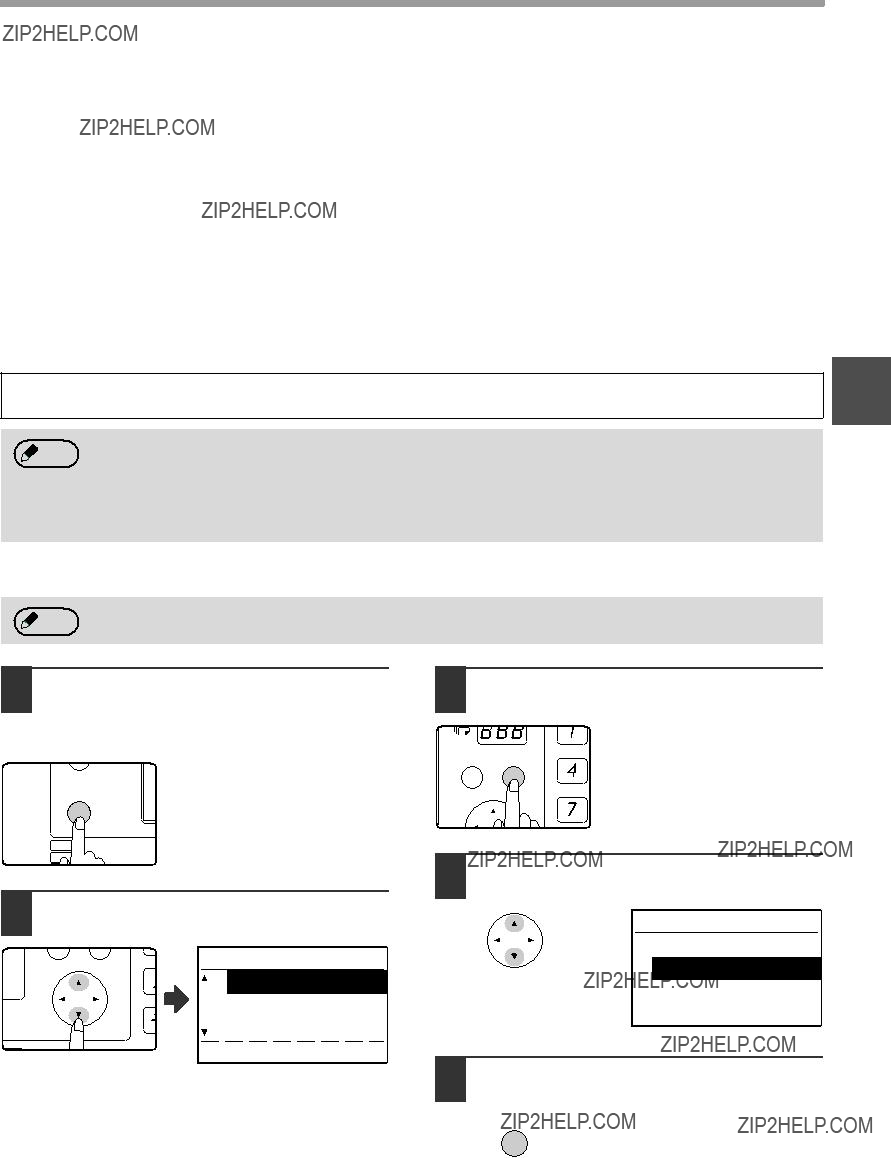
BASIC OPERATIONS
FAX PRINT HOLD FUNCTION
Faxes are normally printed as soon as they are received.
This function is used to hold received faxes in memory rather than printing them as they are received. Faxes held in memory are printed manually all at once.
Settings required for fax print hold
If a fax is received when auto power shut-off mode has activated ("POWER ON AND OFF" in the Operation Guide for the machine), the machine returns to normal operation in order to print the fax. For this reason, if faxes are received at regular intervals, auto power shut-off will repeatedly activate and deactivate and less power will be conserved.
If you wish to maximize the benefit of auto power shut-off at night and other times when printing of received faxes is not immediately necessary, enable fax print hold. When fax print hold is enabled, receiving faxes when auto power shut-off has activated will not cause auto power shut-off to deactivate.
??? When fax print hold is enabled and received faxes are held in memory, the DATA indicator above the [FAX] key Note on the operation panel blinks and a message appears in the display. (When the received faxes are printed, the
indicator stops blinking and the message no longer appears.)
???If the remaining free memory reaches 0%, fax reception will no longer be possible. For this reason, it is important to constantly make sure that sufficient free memory remains and frequently print received faxes. The percentage of free memory remaining appears in the base screen of fax mode. (Page 9)
Enabling fax print hold
If fax print hold is prohibited using "DISABLE FAX PRINT HOLD" (page 104) in the system settings, it will not be
1 In Fax mode, press the [SPECIAL FUNCTION] key.
Begin the following procedure from the base screen of Fax mode.
2 Select "FAX PRINT HOLD" with the [ ] or [
] or [ ] key.
] key.
3 Press the [OK] key.
GHI
BACK OK
PQRS
4 Select "SETTING" with the [ ] or [
] or [ ] key.
] key.
FAX PRINT HOLD
PRINT HOLD DATA
SETTING
5 Press the [OK] key.
OK
To disable fax print hold, select "OFF".
Printing received faxes held in memory
To print received faxes that are held in memory when fax print hold is enabled, follow the steps below.
1 In Fax mode, press the [SPECIAL FUNCTION] key.
Begin the following procedure from the base screen of Fax mode.
4 Select "PRINT HOLD DATA" with the [ ] or [
] or [ ] key.
] key.
FAX PRINT HOLD
PRINT HOLD DATA
SETTING
2 Select "FAX PRINT HOLD" with the [ ] or [
] or [ ] key.
] key.
3 Press the [OK] key.
GHI
BACK OK
PQRS
5 Press the [OK] key.
OK
6 Select "PRINT" with the [ ] or [
] or [ ] key.
] key.
FAX PRINT HOLD
PRINT
CANCEL
7 Press the [OK] key.

3 ADVANCED TRANSMISSION
METHODS
This chapter explains advanced features that are designed for specific purposes and circumstances. Please read those sections that are of interest to you.
SENDING THE SAME DOCUMENT TO
MULTIPLE DESTINATIONS IN A SINGLE
OPERATION (BROADCAST TRANSMISSION)
This feature is used to send a fax to multiple destinations in a single operation. The original to be transmitted is scanned into memory and then successively transmitted to the selected destinations. This feature is convenient for such purposes as distributing a report to company branches. Up to 200 destinations can be selected. When transmission to all destinations has been completed, the document is automatically cleared from memory.
??? If you frequently use broadcasting to send faxes to the same group of destinations, it is convenient to program Note those destinations into a group key. Group key dialling is an automatic dialling function whereby multiple
destinations (Rapid keys, Speed Dial numbers, and full fax numbers entered with the numeric keys) are programmed into a Rapid key. The procedure for programming group keys is explained on page 66.
???When a group key is used to send a fax, the fax is broadcast (transmitted) to the destinations programmed in the group key. For example, if five destinations are programmed in a group key and the key is pressed for a broadcast transmission, the broadcast transmission will have five destinations.
Beep
Destination A
(recipient)
Sender
Reception
Successive Beep transmission
Destination B
(recipient)
Destination C
(recipient)
Reception
BACK OK
ADVANCED TRANSMISSION METHODS
USING BROADCAST TRANSMISSION
1 Perform steps 1 to 4 of "BASIC
PROCEDURE FOR SENDING FAXES" (page 17).
2 Press the [BROADCAST] key.
 :
:
The destination selection screen appears.
3 Enter a full fax number with the numeric keys or press an auto-dial key (Rapid key, Speed Dial number, or group key) to select the first destination. (Page 19)
A destination selected with a Rapid key, Speed Dial number, or group key is indicated by an icon and a number. To clear an entry, press the [C] key.
4 Press the [OK] key and then select the next destination by entering a full fax number or pressing an auto-dial key.
 After entering a full number with GHI the numeric keys, press the
After entering a full number with GHI the numeric keys, press the
 [OK] key to complete the entry. PQRS If you pressed an auto-dial key
[OK] key to complete the entry. PQRS If you pressed an auto-dial key  in step 3, it is not necessary to
in step 3, it is not necessary to

 press the [OK] key. You can immediately press another auto-dial key for the next destination. Repeat steps 3 and 4 to select the remaining destinations.
press the [OK] key. You can immediately press another auto-dial key for the next destination. Repeat steps 3 and 4 to select the remaining destinations.
???If the selected destinations exceed the display range of the message screen, press the [ ] or [
] or [ ] key to scroll through and check the destinations.
] key to scroll through and check the destinations.
???Destinations can also be selected using the address directory and the [REDIAL] key. Note, however, that the [REDIAL] key can only be used to select the first destination (it must be used before any other destinations are selected).
???If you use two group keys that have 50 stations each, the total number of destinations entered will be 100.
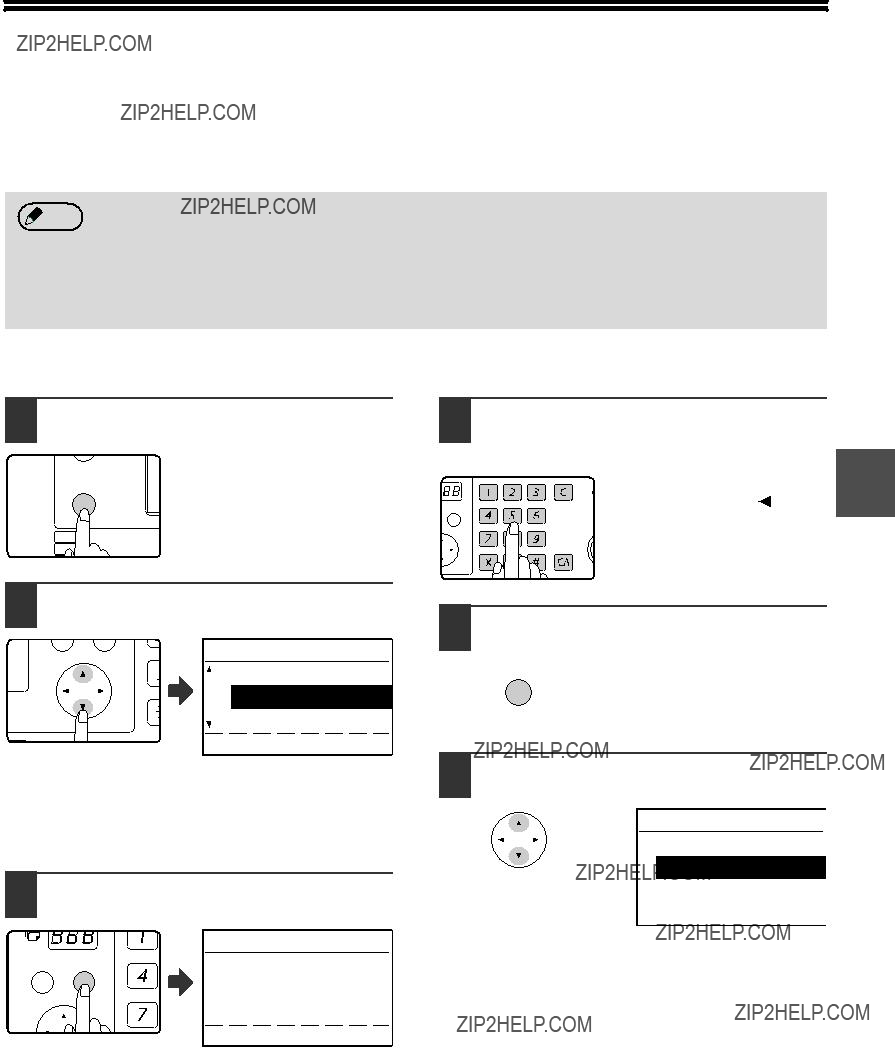
AUTOMATIC TRANSMISSION AT A
SPECIFIED TIME (TIMER TRANSMISSION)
This feature enables you to set up a transmission or polling operation to be performed automatically at a specified time up to a week in advance. This is convenient when you will be out of the office or for transmission at off-peak nighttime rates. A combined total of 50 timer transmission and memory transmission jobs can be stored.
??? After a timer transmission is performed, the information (image, destination, etc.) is automatically cleared from Note memory.
???To perform a timer transmission, the original must be scanned into memory. It is not possible to leave the original in the SPF/RSPF or on the document glass and have it scanned at the specified time of transmission.
???The date and time is set in the machine using the system settings. (See "DATE & TIME SET" on page 104.)
???Only one polling timer operation can be set up at a time. If you wish to set up multiple timer polling operations, combine the machines to be polled into one serial polling operation with a timer setting (see "Serial polling" on page 37).
SETTING UP A TIMER TRANSMISSION
1 In Fax mode, press the [SPECIAL
Use the numeric keys to select the time at which you want the operation to take place.
2 Select "TIMER MODE" with the [ ] or [
] or [ ] key.
] key.
If a time has been specified, a checkmark appears in front of "TIMER MODE". To cancel a specified time, press the [ ] key in the above display with "TIMER MODE" highlighted.
] key in the above display with "TIMER MODE" highlighted.
3 Press the [OK] key.
The current time appears in the screen. If the current time is not correct, press the [CA] key to cancel the operation and see "DATE & TIME SET" (page 104) to correct the time setting.
5 Press the [OK] key.
6 Select the day of the week with the [ ] or [
] or [ ] key.
] key.
SELECT DAY
NO SELECT DAYS
MONDAY
TUESDAY
WEDNESDAY
The selected day is highlighted. If you select "NO SELECT DAYS", the transmission will be performed as soon as the specified time arrives. To return to the [TIME SETTING] display, press the [BACK] key.
ADVANCED TRANSMISSION METHODS
The steps that follow will depend on the type of operation.
The following operations can be performed as a timer operation:
???Normal transmission (page 17)
???Broadcast transmission (page 31)
???Polling (page 35)
???Serial polling (page 37)
???F-code polling (page 57)
???F-code confidential transmission (page 59)
???F-code relay request transmission (page 63)
???A timer job number is automatically assigned to the operation. This number can be used to cancel a stored job. (See the note "Contents of the stored job screen (screen of step 3)" on page 26.)
???Other operations can be performed after a timer operation is set up. If another operation is in progress when the specified time arrives, the timer transmission will begin when the job in progress is completed.
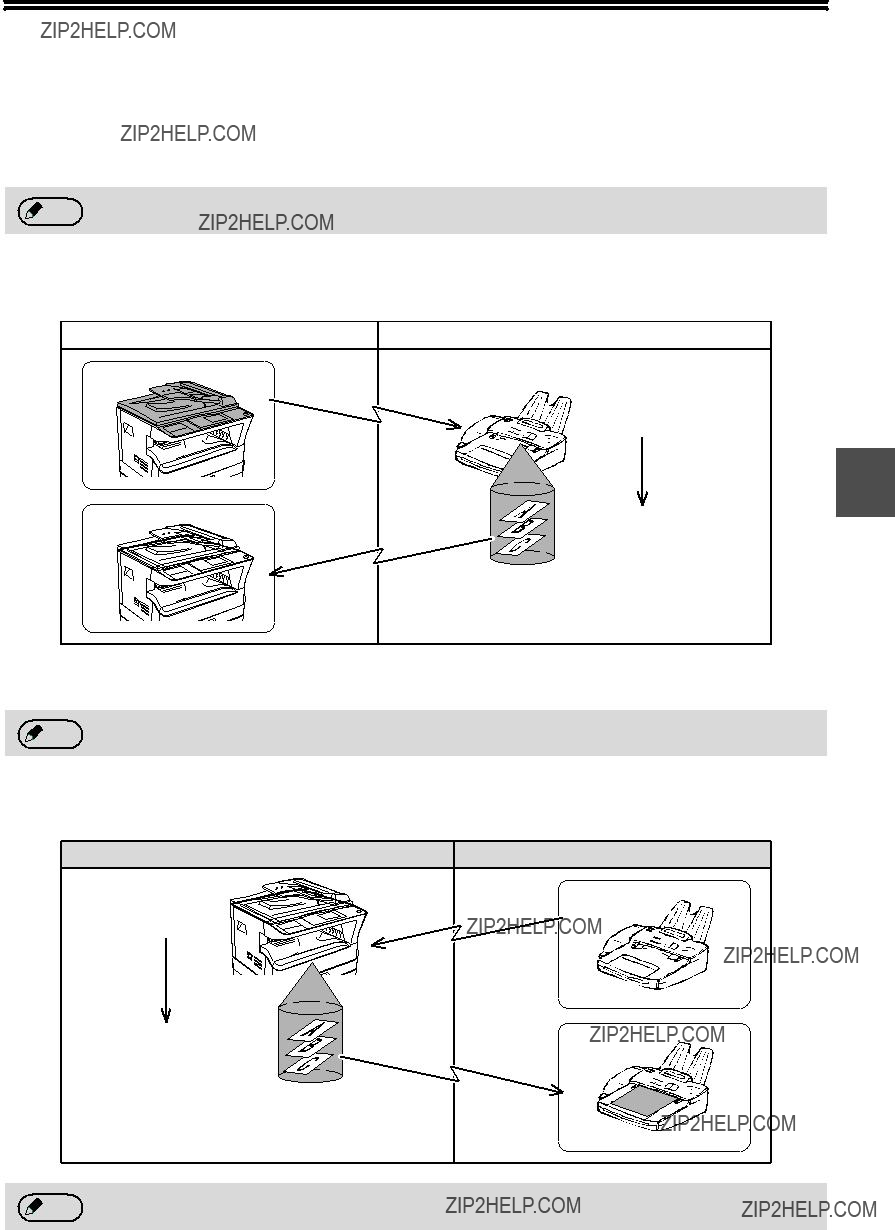
TRANSMISSION AND RECEPTION USING THE POLLING FUNCTION
The polling function allows your machine to call a fax machine that has a document ready for transmission and initiate reception of the document. You can also perform the reverse operation: scan a document into the memory of your machine so that another machine can call your machine and initiate reception of the document.
Calling the sending machine and asking the sending machine to fax a document is called "polling". Scanning a document into memory and automatically sending it when the receiving machine calls and "polls" your machine is called "polling memory". This function can only be used if the other machine is a Super G3 or G3 machine and supports the polling function.
For information on polling and polling memory using F-codes, see "HOW F-CODE POLLING MEMORY WORKS"
Polling
This function allows your machine to call another fax machine and initiate reception of a document in that machine. A timer setting can also be specified to have the operation take place at night or at another specified time. (See "TIMER TRANSMISSION" on page 33.)
Group keys and the broadcast transmission function (page 31) can be used to successively poll multiple fax machines in a single operation (this is called "serial polling"). Up to 200 machines can be polled.
In this case, the sequence of operations in the above diagram is successively repeated for each sending machine selected.
Polling memory
This feature allows your machine to automatically send a document previously scanned into memory when another machine calls and polls your machine.
Your machine
2) Permits polling of.
3) Document data previously scanned into memory
The other machine
1) Polling
(request transmission)
4) Document data is automatically sent to other machine
ADVANCED TRANSMISSION METHODS
USING THE POLLING FUNCTION
When used in conjunction with the timer transmission function (page 33), only one polling job can be stored.
If the other machine is using polling security (see "Restricting polling access (polling security)" on page 40), your Note fax number (sender's number) must be programmed in the system settings (see "OWN PASSCODE SET" on
page 101) and your number must also be programmed in the other machine.
1 In Fax mode, press the [SPECIAL
2 Select "SENDING OPTIONS" with the [ ] or [
] or [ ] key.
] key.
5 Press the [OK] key.
OK
6 Enter the fax number of the other machine with the numeric keys, press a Rapid key, or specify a Speed Dial number (a group key cannot be used).
3 Press the [OK] key.
GHI
BACK OK
PQRS
4 Select "POLLING" with the [ ] or [
] or [ ] key.
] key.
A destination selected with a Rapid key or Speed Dial number is indicated by an icon and a number. To clear an entry, press the [C] key.
7 Press the [OK] key.
OK
8 Press the [START] key.
SENDING OPTIONS
POLLING
SERIAL POLLING
SUB ADDRESS TX
"Polling reservation has been set." appears in the screen. After communicating with the other machine, your machine prints the received fax.
ADVANCED TRANSMISSION METHODS
Serial polling
When performing serial polling, an auto-dial key that includes a sub-address or passcode (page 52) cannot be selected.
1 Perform steps 1 to 3 of the polling procedure (page 36).
2 Select "SERIAL POLLING" with the [  ] or [
] or [  ] key.
] key.
PQ
ED COPY
EX SCAN
EX SCAN
ACC
SENDING OPTIONS
POLLING
SERIAL POLLING
SUB ADDRESS TX
About the steps that follow
See steps 5 to 8 of the polling procedure (page 36). Before pressing the [START] key in step 8, repeat
steps 6 and 7 for each machine that you wish to poll.3 When performing serial polling, a group key can also
be used in step 6 on page 36.
ADVANCED TRANSMISSION METHODS
USING POLLING MEMORY
This function sends a document previously scanned into memory to a receiving machine when the receiving machine calls and polls your machine. (If desired, you can restrict polling to fax machines whose fax number you have programmed in your machine. See "Restricting polling access (polling security)" on page 40.) The machine has "memory boxes", which are memory used for the regular polling memory function, F-code polling memory, F-code confidential transmission, and F-code relay transmission (see "BOXES AND SUB-ADDRESSES/PASSCODES REQUIRED FOR F-CODE TRANSMISSION" on page 52) The polling memory function explained here uses a memory box called the "PUBLIC BOX".
When using the polling memory function, do not set the reception mode to MANUAL. (See "SETTING THE
Scanning a document into polling memory (the Public Box)
This section explains how to scan a document into the Public Box. If other documents have already been stored in the Public Box, the new document will be appended to those documents. If the previous documents are no longer needed, they can be replaced.
1 Follow steps 1 to 4 of "BASIC
PROCEDURE FOR SENDING FAXES" (page 17) and then follow the steps below.
2 Press the [SPECIAL FUNCTION] key.
3 Select "ORIGINAL STORE" with the [ ] or [
] or [ ] key.
] key.
5 Select "MEMORY POLLING" with the [ ] or [
] or [ ] key.
] key.
SELECT READING
MEMORY POLLING
S.A.M-POLL ORIG
6 Press the [OK] key.
???If there are no previously stored documents in the Public Box, the above screen appears. If the above screen appears, go to step 7.
(1)If you wish to append the new document, select "ADD" with the [  ] or [
] or [  ] key, press the [OK] key, and then go to step 7.
] key, press the [OK] key, and then go to step 7.
(2)If you wish to replace the previous document with
the new document, select "CHANGE" with the [  ] or [
] or [  ] key, press the [OK] key, and then go to step 7.
] key, press the [OK] key, and then go to step 7.
ADVANCED TRANSMISSION METHODS
7 Select "1 TIME" or "REPEAT" with the [  ] or [
] or [  ] key.
] key.
SELECT SENDING
1 TIME
REPEAT
If you select "1 TIME", the document data is automatically cleared from memory after your machine is polled once. If you select "REPEAT", the document data in memory can be used repeatedly.
If you selected "ADD" or "CHANGE" in step 6, the transmission settings selected when the previous document was scanned into the Public Box will be replaced by the settings that you will select this time.
8 Press the [OK] key.
OK
9 Press the [START] key (  ).
).
10 Make sure that the reception mode is set to auto reception.
Transmission begins when the other machine calls and polls your machine.
To cancel scanning
Printing documents in the Public Box
To check the document that is stored in the public box, follow these steps to print it out.
3 Press the [OK] key.
Printing begins automatically.
GHI
BACK OK
PQRS
ADVANCED TRANSMISSION METHODS
Deleting documents from the Public Box
This procedure is used to delete documents from the Public Box when they are no longer needed.
1 Follow steps 2 to 6 of "Scanning a document into polling memory (the Public Box)" (page 38) and then follow the steps below.
2 Select "DELETE" with the [  ] or [
] or [  ] key.
] key.
3 Press the [OK] key.
A screen appears asking you to confirm the deletion.
4 Select "YES" with the [ ] or [
] or [ ] key.
] key.
DELETE
YES
NO
To cancel the deletion, select "NO".
5 Press the [OK] key.
Restricting polling access (polling security)
If you wish to prevent unauthorised fax machines from polling your machine, enable the polling security function. When this function is enabled, polling permission will only be granted if the fax number of the polling machine (programmed in that machine as the sender's number) matches one of the fax numbers you have programmed in your machine as passcode numbers. Up to 10 fax numbers can be programmed as passcode numbers.
To enable the polling security function and program passcode numbers, see "POLLING PASSCODE # MODE" (page 111) in the system settings.
??? If you do not use the polling security function, the document will be sent to any fax machine that polls you. Note ??? To use polling memory with polling security enabled, the sender's number of the polling machine must be
programmed in that machine and in your machine.
INCLUDING SENDER INFORMATION ON
FAXES
This function prints the date, time, your programmed name, your programmed fax number, and the transmitted page number at the top centre of each page that you fax. All pages that you fax include this information.
Example of fax page printed out by the receiving machine
You can select whether the sender information is added outside the document data or inside the document data in the system settings (see "PRINT STATION # IN RCVD DATA" on page 106). The factory default setting is outside the document data.
use the same size of paper, the printed fax may either be reduced or split up and printed on two pages.
of paper, the printed fax will neither be reduced nor split up and printed on two pages.
FAXING A DIVIDED ORIGINAL (DUAL PAGE SCAN)
When faxing a book or other bound document, you can use this function to divide the two open pages of the book into two separate fax pages.
This function can only be used when the original is A3, B4, or A4R size (11" x 17" or 8-1/2" x 11"R size if the machine uses inch-based paper sizes) is scanned using the document glass.
Selecting Dual Page Scan
Follow the steps below and then send the fax.
1 Make sure that the machine is in fax mode
2 Press the [SPECIAL FUNCTION] key.
3 Select "DUAL PAGES" with the [  ] or [
] or [  ] key.
] key.
Dual Page Scan is selected when a checkmark appears in the "DUAL PAGES" checkbox. To cancel the selection when a checkmark appears, press the [OK] key in the next step so that a checkmark does not appear.
4 Press the [OK] key.
GHI
BACK OK
PQRS
5 Place the original on the document glass (page 12) and perform the transmission operation.
If you have more originals to scan after pressing the [START] key (  ) and scanning the first original, change originals and press the [START] key (
) and scanning the first original, change originals and press the [START] key (  ). Repeat until all originals have been scanned. Press the
). Repeat until all originals have been scanned. Press the  key. (See steps 6 to 8 of "Using the document glass" on page 18.)
key. (See steps 6 to 8 of "Using the document glass" on page 18.)
ADDING A COVER SHEET/MESSAGE TO
A FAX TRANSMISSION
This function automatically attaches an A4 (8-1/2" x 11") cover sheet to your fax transmissions. The cover sheet shows the date and time, the destination name, the sender's name and fax number, and the number of pages in the transmission. A message can also be added to a transmission. One of the following messages can be selected: "CONFIDENTIAL", "PLEASE DISTRIBUTE", "URGENT", "PLEASE CALL BACK", "IMPORTANT".
???Before adding a cover sheet, make sure that your sender's name and number have been programmed. (See "OWN PASSCODE SET" on page 101.)
???This function cannot be used when performing a manual transmission, or when using memory polling (page 38), F-code memory polling (page 54), F-code confidential transmission (page 59), or F-code relay request transmission (page 63).
???You can also enable a setting in the system settings to always add a cover sheet to transmissions (see "AUTO COVER SHEET" on page 108).
Selecting a cover sheet / message
1 In Fax mode, press the [SPECIAL FUNCTION] key.
2 Select "SENDING MENU" with the [ ] or [
] or [ ] key.
] key.
EX SCAN
3 Press the [OK] key.
4 To add a cover sheet, select "COVER SHEET" with the [ ] or [
] or [ ] key. To add a message, select the desired message with the [
] key. To add a message, select the desired message with the [ ] or [
] or [ ] key.
] key.
SENDING MENU
NO MESSAGE
CONFIDENTIAL
PLEASE DISTRIBUTE
 COVER SHEET
COVER SHEET 
If you do not wish to add a cover sheet, select "NO CVR. SHEET".
If you do not wish to add a message, select "NO MESSAGE".
5 Press the [OK] key.

USING SETTINGS STORED AS A PROGRAM
This function allows you to store the steps of an operation, including the destination and scanning settings, into a program. This function is convenient when you frequently send documents, such as a daily report, to the same destination. Up to nine programs can be stored.
When storing a program, a name (maximum 36 letters) can be assigned to the program.
For information on storing, editing, and deleting programs, see "STORING, EDITING AND DELETING PROGRAMS" on page 76.
The following settings can be stored in a program:
(1)Transmission method
Normal transmission (page 17), broadcast transmission (page 31), polling (page 35), serial polling (page 37), F-code transmission (page 59), F-code polling (page 57)
(2)Cover sheet / message (page 43)
(3)Resolution and exposure (page 14)
(4)Dual page scan (page 42)
(5)Transmission settings (page 22)
When storing a broadcast transmission or serial polling operation in a program, up to 200 destination fax numbers can be stored.
??? A program differs from a timer transmission (page 33) in that it is not cleared from memory after transmission Note takes place. A program thus allows you to repeatedly perform the same type of transmission. Note, however,
that programs do not allow you to establish a timer setting for transmission.
???A setting that can be stored in a program cannot be changed at the time that a program is used for a transmission even if the setting is not stored in the program.
???The only settings that can be selected when using a program are the original size, duplex scanning, and a timer setting.
USING A PROGRAM
1 In fax mode, place the original. (Page
12)
(To select fax mode, see step 1 on page 17.)
2 Press the [PROGRAM] key.
4 Press the [OK] key.
5 If needed, select the original size and other settings, and then press the [START] key (  ).
).
NO
XYZ
@.-_
D-END
Transmission takes place according to the program.
Select settings that cannot be stored in a Note program before you press the [START] key
(  ) in step 5. These settings include the
) in step 5. These settings include the
The program selection screen appears.
3 Select the program that you wish to use with the [ ] or [
] or [ ] key.
] key.
If not all letters of the program name appear, press the  key to display all letters. Press the
key to display all letters. Press the  key once
key once
again to return to the original screen.
FORWARDING RECEIVED DATA TO A
NETWORK ADDRESS (INBOUND
ROUTING SETTINGS)
The received fax data can be automatically forwarded to a specified e-mail address. When this function is enabled, you can forward the received data to a specified address without printing it.
All Inbound Routing settings are configured in the Web page.
The following explanation assumes that the Web page has been accessed with administrator rights. To activate Inbound Routing, configure the basic settings before specifying the destination.
CONFIGURING THE BASIC SETTINGS
Configure the basic settings of Inbound Routing.
Changing the print style of received data
2 Select a print style in [Print Style Setting].
ADVANCED TRANSMISSION METHODS
Set a file name for forwarding received data
Select the checkboxes of items used for the file name.
Items Serial Number, Sender Name, Date & Time, Session Page Counter, Unique Identifier, and Characters are assigned to the file name in this order.
To add a desired text string, select the "Characters" checkbox and enter the string in "Preset of Character" using up to 64 characters.
2 Select the item to be used as the file name in "File Name Setting".
Setting whether to print the transaction report
Select whether to print the transaction report when forwarding received data.
2 Specify the print condition in "Transaction Report Print Select Setting".
ADVANCED TRANSMISSION METHODS
SETTINGS THE DESTINATION
Specify a sending source of received data and forwarding destination e-mail addresses to configure a forwarding table.
Up to 10 forwarding tables can be configured.
For each forwarding table, set the following items:
???Forward Condition (enabling/disabling forwarding, and the conditions to determine forwarding)
???Sender number (fax number)
???Forwarding destinations (e-mail addresses)
Viewing the destination list
Settings the destination
1 In the menu frame, click [Inbound Routing Settings].
2 Click [Destination].
The destination list appears.
3 Click the destination number to be set.
The "Forwarding Destination" screen appears.
4 Select [Enable] in "Forward
Condition".
5 In "Forward Condition", select the determining condition for forwarding.
Select [Forward (All)] or [Forward (Sender)].
6 If you wish to forward received data from a specific sender, enter the sender's fax number in "Sender Number".
Enter the fax number using up to 20 digits.
To enter the fax number from the fax addresses stored in the machine, click the [Select from Address Book] button. The "Fax Destination" screen appears, and you can select the sender's number from the fax address list.
ADVANCED TRANSMISSION METHODS
7 Enter the destination e-mail address in "Forward Destination (Max.5)".
Up to five e-mail addresses can be specified as the destination.
Three types of methods are available for entering the destination. The set e-mail addresses are displayed in "Forwarding Destination Settings".
???Entering an e-mail address directly
Click the [Direct Entry] button. When the "Forwarding Destination Settings (Direct Entry)" appears, enter an e-mail address and click the [Submit] button. The e-mail address can include up to 64 single-byte characters.
???Selecting an e-mail address from the global address book
Click the [Global Address Search] button. The "Global Address Search" screen appears.
You can select an e-mail address from the global address book.
???Selecting an e-mail address from the address book Click the [Select From Address Book] button. The "Destination List" screen appears, and you can select an e-mail address from the e-mail address list.
To delete a set e-mail address, select the Note checkbox at the left of the e-mail address
you wish to delete, and then click the [Delete] button.
8 Click the [Submit] button.
This stores the setting.
Forward Condition
Sender Number
Forward Destination (Max. 5)
FORWARDING RECEIVED FAXES TO
ANOTHER MACHINE WHEN PRINTING IS
NOT POSSIBLE (FORWARDING FUNCTION)
When printing is not possible because of a paper, toner, or other problem, you can forward received faxes to another fax machine if that machine has been appropriately programmed in your machine. This function can be conveniently used in an office or other workplace where there is another fax machine connected to a different phone line. When a fax has been received to memory, the DATA indicator above the [FAX] key (see "If received data cannot be printed" on page 28) to blinks.
2)Printing not possible because of paper or toner problem
3) "Transfer" instruction
1) Fax transmission to your machine
4) Automatic dialling and transmission to programmed transfer destination
1 Make sure that the machine is in fax mode.
When the machine is in fax mode, the FAX indicator is lit. If the light is not on, press the [FAX] key.
2 Press the [SPECIAL FUNCTION] key.
ADVANCED TRANSMISSION METHODS
3 Select "RX DATA TRANSFER" with the [  ] or [
] or [  ] key.
] key.
4 Press the [OK] key.
GHI
BACK OK
PQRS
5 Select "TRANSFER" with the [ ] or [
] or [ ] key.
] key.
RX DATA TRANSFER
 :12345678901234 12345678901234 123456789012
:12345678901234 12345678901234 123456789012
TRANSFER
To cancel forwarding, select "NO TRANSFER".
6 Press the [OK] key.
settings and begins forwarding the fax or faxes.
cancel forwarding in the same way as a regular fax transmission. (See
"CANCELLING A FAX TRANSMISSION" on page 25.) The fax(es) that was going to be forwarded will return to print standby status in your machine.
???If forwarding is not possible because the other machine is busy or a transmission error occurs, recall attempts will be made according to the recall times setting. If forwarding is still not successful after the set number of recall attempts are made, the fax(es) will return to print standby status in your machine.
???When forwarding is performed, all faxes that have been received in memory to that point are forwarded. The page that was being printed when the problem occurred and all following pages will be forwarded.
???After a fax is forwarded, the fax data is automatically cleared from memory.
SENDING A FAX DIRECTLY FROM A
COMPUTER (PC-Fax)
A document in a computer can be transmitted via the machine as a fax. Faxes are sent using the PC-Fax function in the same way as documents are printed. Select the PC-Fax driver as the printer driver on your computer and then select the Print command in the software application. Image data for transmission will be created and sent as a fax.
Fax transmission
For more information on using the PC-Fax function, see the "Operation Guide" that is installed along with the PC-Fax driver.
???This function can only be used on a Windows?? computer.
???This function can only be used for transmission. Faxes cannot be received to your computer.
ADVANCED TRANSMISSION METHODS
INSTALLING THE PC-FAX DRIVER (THAT ACCOMPANIES THE MACHINE)
1 Insert the "Software CD-ROM" that accompanies the machine into your computer's CD-ROM drive.
2 Click the "Start" button, click "Computer", and then double-click the CD-ROM icon (  ).
).
???In Windows XP, click the "start" button, click "My Computer", and then double-click the CD-ROM icon.
???In Windows 2000, double-click "My Computer", and then double-click the CD-ROM icon.
3 Double-click the [Setup] icon (  ).
).
If the language selection screen appears Note after you double click the [Setup] icon, select
the language that you wish to use and click the [Next] button. (Normally the correct language is selected automatically.)
4 The "SOFTWARE LICENSE" window will appear. Make sure that you understand the contents of the license agreement and then click the [Yes] button.
5 Read the message in the "Welcome" window and then click the [Next] button.
6 Click the [Custom] button.
When MX-NB12 is installed
3
Standard
7 Click the [Utility Software] button.
8 Click the [PC-Fax Driver] button.
In the port selection screen that appears when the PC-Fax driver is being installed, select the same port as the Printer driver that is already installed.
9 When installing is finished, click the "Close" button.
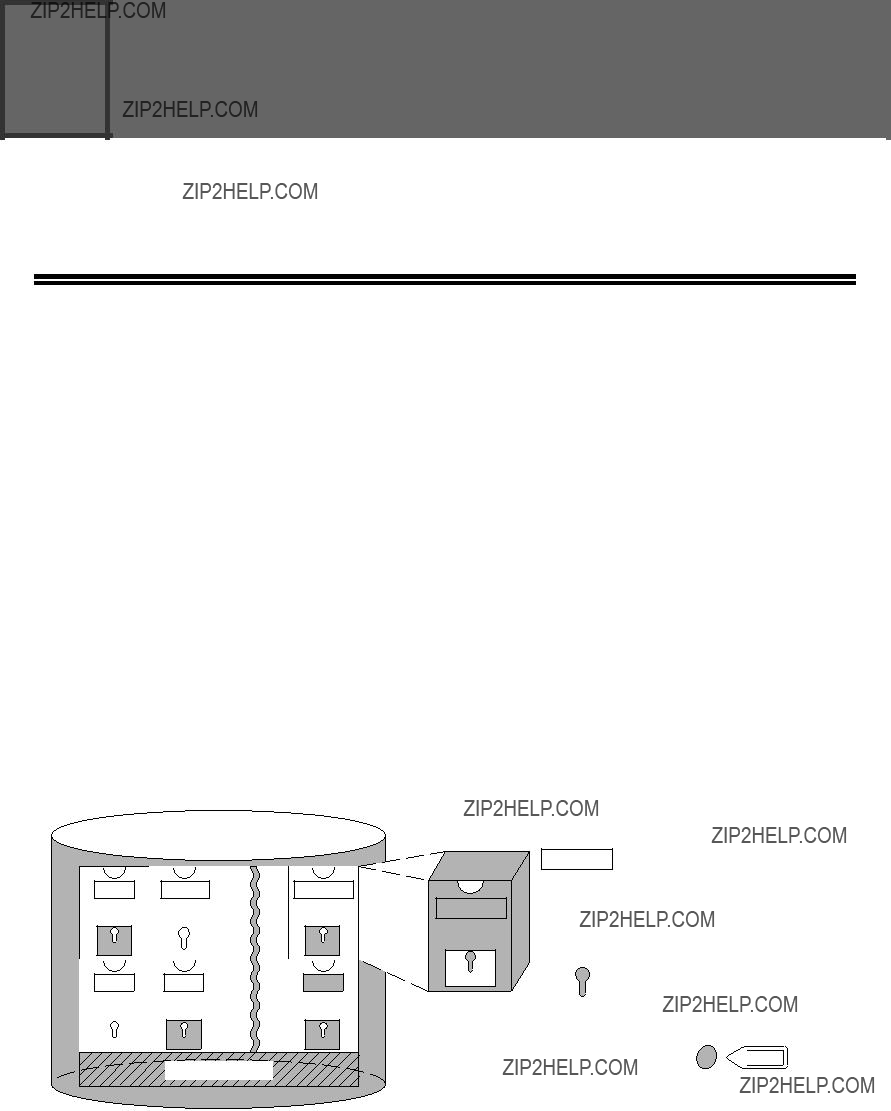
4 TRANSMISSION USING
F-CODES
This chapter explains F-code transmission, which gives you a convenient means of performing advanced operations such as relay broadcast transmission and confidential transmission. Please read those sections that are of interest to you.
COMMUNICATION BETWEEN MACHINES
SUPPORTING F-CODES
This machine supports the "F-code" standard as established by the ITU-T*.
Operations such as relay broadcast transmission and confidential transmission previously could only be performed with another Sharp fax machine; however, F-Code communication makes it possible to perform these operations with fax machines of other manufacturers that support F-Code communication.
Before using the functions explained in this chapter, make sure that the other fax machine supports F-Code communication and has the same functions as your machine. (Note that the other machine may use different names for some functions.)
*The ITU-T is a United Nations organization that establishes communications standards. It is a department of the International Telecommunication Union (ITU), which coordinates global telecommunications networks and services.
BOXES AND SUB-ADDRESSES/PASSCODES
REQUIRED FOR F-CODE TRANSMISSION
"Boxes" can be created in the memory of fax machines that support F-Code communication. These boxes are used to store faxes received from other machines and documents to be transmitted when a polling request is received. Up to 30 boxes can be created for a variety of purposes, and a name can be assigned to each box. A "sub-address" that indicates the box's location in memory must be programmed, and if desired, a passcode can also be programmed to control access to the box. (A sub-address must be programmed, however, a passcode can be omitted.)
Sub-address (location in memory)
Select any number up to 20 digits.
Box name (used to manage boxes in your machine)
Select a name of up to 36 characters.
Passcode (key)
Select any number up to 20 digits. (Not required)





 1115
1115

TRANSMISSION USING F-CODES
When communication occurs involving a box, the communication will only take place if the sub-address and passcode that the other machine sends match the sub-address and passcode programmed in your machine for that box. Therefore, to allow communication, you must inform the other party of the sub-address and passcode of the box. Likewise, to send a fax to a box in another machine or use polling to retrieve a document from a box, you must know the sub-address and passcode of that box. (Note that assigning names simply makes it easier to manage boxes; you do not need to inform the other party of a box name.) However, you must inform the other party of the sub-address and passcode for a box.
This machine uses the term "sub-address" for the location of the memory box and the term "passcode" for the password that allows communication; however, other fax machines of other manufacturers may use different terms. When asking the other party for a sub-address and passcode, you may find it useful to refer to the 3-character alphabetical terminology used by the ITU-T.
CREATING A BOX FOR F-CODE TRANSMISSION
F-code operations that use boxes include F-code polling memory (page 54), F-code confidential transmission (page 59), and F-code relay broadcast transmission (page 62).
A box is created by programming a name for the box, and up to 10 boxes for each operation type can be created.
The information programmed in each box varies slightly depending on the type of operation. For
information on programming, editing, and deleting boxes, see "PROGRAMMING, EDITING, AND DELETING 4 F-CODE MEMORY BOXES" on page 78.
After you have programmed a box, inform the other party of the box's sub-address and passcode.
If you attempt to create a box when 10 boxes have already been created for that operation type, a Note message will appear and you will not be able to create the box. Delete any unused boxes and then
create the new box. (See "PROGRAMMING, EDITING, AND DELETING F-CODE MEMORY BOXES" on page 78.)
F-CODE POLLING MEMORY
F-code polling memory allows one fax machine to call another fax machine and initiate reception of a document that has been scanned into the other machine's F-code polling memory box. Calling another machine and initiating reception is called F-code polling, and scanning a document into a memory box for another machine to retrieve by polling is called F-code polling memory. This function is approximately the same as regular polling (page 35); however, it uses an F-code polling memory box and is always protected by means of the sub-address and passcode.
HOW F-CODE POLLING MEMORY WORKS
Your machine
2) Check sub-address and passcode
3)Polling memory box opens
Product Planning
4) Automatic transmission of document data
to other machine
F-code polling (page 57) is when your machine calls another machine and retrieves a document that was scanned into the polling memory box of that machine (the reverse of the above diagram).
???Unlike regular polling, the other machine's fax number is not used as a passcode for F-code polling memory. The sub-address and passcode of the polling memory box are always used for polling security.
???The receiving machine bears the expense (phone charges) of the transmission.
PQ
ED COPY
LEX SCAN
LEX SCAN
ACC
SELECT READING
MEMORY POLLING
S.A.M-POLL ORIG
4
3 Press the [OK] key.
GHI
BACK OK
PQRS
4 Select the name of the polling memory box with the [ ] or [
] or [ ] key.
] key.
SEL S.A. POLL BX

 Document Plan
Document Plan
Document Tech
- - - - - -
[#]:LIST DETAIL
If not all letters of the programmed name appear, press the  key to display all letters. Press the
key to display all letters. Press the  key again to return to the previous display.
key again to return to the previous display.
About the steps that follow
See steps 6 through 10 in "Scanning a document into polling memory (the Public Box)" (pages 38 to 39). Where "public box" (page 38) appears in the procedure, substitute "F-code polling memory box".
TRANSMISSION USING F-CODES
6 Select "PRINT" or "DELETE" with the [ ] or [
] or [ ] key.
] key.
ORIGINAL
ADD
CHANGE
DELETE
PRINT
If you selected "PRINT", press the [OK] key to begin printing.
If you selected "DELETE", go to step 7.
3 Press the [OK] key.
GHI
BACK OK
PQRS
4 Select the name of the F-code memory polling box with the [ ] or [
] or [ ] key.
] key.
SEL S.A. POLL BX

 Document Plan
Document Plan
Document Tech
- - - - - -
[#]:LIST DETAIL
A checkmark appears next to the box name of boxes that have document data.
If not all letters of the programmed name appear, press the  key to display all letters. Press the
key to display all letters. Press the  key again to return to the previous display.
key again to return to the previous display.
7 Press the [OK] key.
A screen appears asking you to confirm the deletion.
8 Select "YES" with the [ ] or [
] or [ ] key.
] key.
DELETE
YES
NO
To cancel the deletion, select "NO".
9 Press the [OK] key.
The documents are deleted from the F-code polling memory box.
Deletion is not possible while the box is
TRANSMISSION USING F-CODES
PROCEDURE FOR F-CODE POLLING
Make sure that a document has not been placed in the document feeder tray or on the document glass, and then follow the steps below.
??? You must know the sub-address (SEP) and passcode (PWD) of the other machine's F-code polling memory
Note box.
???Serial polling (selecting multiple fax machines to be polled using a group key, Rapid keys, and Speed Dial numbers) is not possible when using F-code polling.
1 In Fax mode, press the [SPECIAL FUNCTION] key.
2 Select "SENDING OPTIONS" with the [ ] or [
] or [ ] key.
] key.
6 Enter the fax number of the other machine with the numeric keys, or press a Rapid key, or dial a Speed Dial number (a group key cannot be used).
A destination selected with a Rapid key or Speed Dial number is indicated by an icon and a number. To clear an entry, press the [C] key.
GHI
BACK OK
PQRS
4 Select "SUB ADD POLLING" with the [ ] or [
] or [ ] key.
] key.
SENDING OPTIONS
SERIAL POLLING
SUB ADDRESS TX
SUB ADD POLLING
5 Press the [OK] key.
OK
8 Enter the sub-address (up to 20 digits) with the numeric keys.
WXYZ
???Characters that can be entered are numbers, "#", and spaces. However, the initial character cannot be a space.
???If you make a mistake, press the [C] key and re-enter the correct digit(s).
???If you specified a Rapid key or Speed Dial number in step 6 that has a sub-address programmed, the sub-address will appear. Go to the next step without entering a sub-address.
9 Press the [OK] key.
OK
TRANSMISSION USING F-CODES
10 Enter a passcode (maximum 20 digits) with the numeric keys.
WXYZ
???Characters that can be entered are numbers, "#", and spaces. However, the initial character cannot be a space.
???If you make a mistake, press the [C] key and re-enter the correct digit(s).
???If the other machine has not programmed a passcode, omit the passcode and go to the next step.
???If you specified a Rapid key or Speed Dial number in step 6 that has a passcode programmed, the passcode will appear. Go to the next step without entering the passcode.
11 Press the [OK] key.
OK
12 Press the [START] key (  ).
).
F-CODE CONFIDENTIAL TRANSMISSION
F-Code confidential transmission provides a secure means of faxing confidential documents. The sub-address and passcode programmed in the box restrict the recipients of the fax, and once received in the box, the fax can only be printed by someone who knows the print passcode.
This function is convenient when sending important documents that you only want a specific person to see, or when multiple departments share a single fax machine.
2) Check sub-address and passcode
Passcode
3) The fax is received to the F-code confidential box (reception is permitted)
???See pages 78 through 82 for the procedures for creating, editing, and deleting F-code confidential memory boxes.
???Take care not to forget the print passcode that is programmed in the F-code confidential box. If you forget the passcode, consult your Sharp dealer.
F-CODE TRANSMISSION (F-CODE CONFIDENTIAL
TRANSMISSION)
To perform F-code confidential transmission, you must enter the sub-address (SUB) and passcode (SID) after the fax number of the receiving machine. (Omit the passcode if the other machine does not use a passcode.
To receive a fax sent by F-code confidential transmission (this is called F-code confidential reception), you must inform the sending party of the sub-address (SUB) and passcode (SID) of your confidential box. (Omit the passcode if a passcode is not programmed in the box.)
An F-code confidential transmission can be used in combination with the broadcast transmission function (page
TRANSMISSION USING F-CODES
F-code confidential transmission
1 Follow steps 1 to 4 of "BASIC
PROCEDURE FOR SENDING FAXES" (page 17) and then follow the steps below.
2 Press the [SPECIAL FUNCTION] key.
3 Select "SENDING OPTIONS" with the [  ] or [
] or [  ] key.
] key.
SENDING OPTIONS
SERIAL POLLING
SUB ADDRESS TX
SUB ADD POLLING
8 Press the [OK] key.
9 Enter the sub-address (maximum 20 digits) with the numeric keys.
WXYZ
???Characters that can be entered are numbers, "#", and spaces. However, the initial character cannot be a space.
???If you make a mistake, press the [C] key and re-enter the correct digit(s).
???If you specified a Rapid key or Speed Dial number in step 7 that has a sub-address programmed, the sub-address will appear. Go to the next step without entering a sub-address.
10 Press the [OK] key.
11 Enter the passcode (maximum 20 digits) with the numeric keys.
WXYZ
???Characters that can be entered are numbers, "#", and spaces. However, the initial character cannot be a space.
???If you make a mistake, press the [C] key and re-enter the correct digit(s).
???If you specified a Rapid key or Speed Dial number in step 7 that has a passcode programmed, the passcode will appear. Go to the next step without entering the passcode.
6 Press the [OK] key.
7 Enter the fax number of the other machine with the numeric keys, or press a Rapid key, or dial a Speed Dial number (a group key cannot be used).
A destination selected with a Rapid key or Speed Dial number is indicated by an icon and a number. To clear an entry, press the [C] key.
12 Press the [OK] key.
13 Press the [START] key (  ).
).
NO
XYZ
@.-_
D-END
???Scanning begins.
???If you are scanning from the document glass and have another page to scan, change pages and press
the [START] key (  ). Repeat until all pages have been scanned and then press the
). Repeat until all pages have been scanned and then press the  key.
key.
TRANSMISSION USING F-CODES
PRINTING A DOCUMENT RECEIVED TO AN F-CODE
CONFIDENTIAL MEMORY BOX
Faxes received in an F-code confidential memory box are printed out by entering the 4-digit print passcode (0000 to 9999) that was programmed when the box was created.
??? Make sure that a Transaction Report is set to print out in the system settings so that you will be informed when Note a confidential document is received. (See "PRINT SELECTION (CONF. RECEPTION)" in "LIST SETTING" on
page 99.)
???Faxes received to an F-code confidential memory box are automatically cleared after printing.
???When a new fax is received to an F-code confidential box while a previously received fax is still stored in the box, the new fax is appended after the previous fax.
1 In fax mode, press the [SPECIAL FUNCTION] key.
2 Select "PRINT" with the [ ] or [
] or [ ] key.
] key.
3 Press the [OK] key.
GHI
BACK OK
PQRS
4 Select "CONF. RX DATA" with the [  ] or [
] or [ ] key.
] key.
PRINT
REPORT
CONF. RX DATA
5 Press the [OK] key.
OK
6 Select the name of the F-code confidential box with the [ ] or [
] or [ ] key.
] key.
An icon ( ) appears next to each box that is holding a received fax.
) appears next to each box that is holding a received fax.
7 Press the [OK] key.
8 Enter the 4-digit passcode with the numeric keys.
 Note If received faxes remain in an F-code confidential memory box, the box cannot be deleted.
Note If received faxes remain in an F-code confidential memory box, the box cannot be deleted.
F-CODE RELAY BROADCAST
TRANSMISSION
The F-Code relay broadcast function allows the machine to act as a relay machine for a broadcast transmission. The end receiving machines are stored in the machine's F-Code relay memory box, and when the machine receives a relay request from another F-Code machine, it will relay the fax to all of the stored end receiving machines.
The relay machine and the originating machine that requests the relay transmission must both support F-codes; however, the end receiving machines programmed in the F-code relay broadcast memory box do not need to support F-codes.
Relay request machine (sends document)
1) Document is sent from
machine requesting Sub-address relay transmission
Passcode
Relay machine (your machine)
2) Check sub-address and passcode
3) Document data is
S.F. read into relay broadcast memory box
(reception is permitted).
4) Document is automatically transmitted to end receiving machines programmed in the relay broadcast memory box.
The machine that originally sends the document is called the relay request machine, and the machine that has a memory box containing the end receiving machines and which relays the received document to those machines is called the relay machine.
The relay machine also prints the document sent by the relay request machine.
For example, corporate headquarters in Seattle wants to send the same document to branch offices in San Francisco, Oakland, Berkeley, and San Jose. If the San Francisco office creates a relay broadcast memory box and programs the Oakland, Berkeley, and San Jose offices as end receiving destinations, the overall phone charges will be lower than if the Seattle office uses the regular broadcast transmission function (page 31). If used together with a timer setting (page 33) to take advantage of off-peak rates, the cost of transmission can be further reduced.
Transmission by the relay machine is called "F-code relay broadcast transmission", and transmission from the relay request machine to the relay machine is called "relay request transmission".
???Up to 10 F-code relay groups (boxes) can be programmed. A name (up to 36 characters long) and the end receiving machines are programmed in each box. A combined total of 120 end receiving machines can be programmed in all F-code relay groups (boxes). (If 120 end receiving machines are programmed in one F-code relay group, no end receiving machines can be programmed in other F-code relay groups.)
???End receiving machines can be stored using the numeric keys, Rapid keys, Speed Dial numbers, and group keys. Auto-dial destinations that already have a sub-address and passcode programmed cannot be used.
???Only one relay group can be specified when making a relay request. Multiple relay groups cannot be simultaneously selected.
???To create an F-code relay group (box) and store, edit, and delete end receiving machines, see pages 78, 80 and 83. When creating a box, a passcode (SID) can be omitted.
???The relay request machine only bears the expense of sending the document to the relay machine. The relay machine bears the expense of sending the document to each of the end receiving machines.

TRANSMISSION USING F-CODES
USING THE F-CODE RELAY BROADCAST FUNCTION (your machine is the relay machine)
When a document is received from a relay request machine, the F-code relay broadcast function transmits the document to the end receiving machines using a memory box only if the sub-address and passcode sent by the relay request machine are correct.
To create, edit, or delete an F-code relay group (box), see pages 78, 80 and 83.
A document received from a relay request machine is initially stored in the box of your machine. Your machine (the relay machine) also prints the document, thus the document is first stored as a print job and then as transmission jobs to each of the programmed end receiving machines. The document data is automatically cleared after transmission to all end receiving machines is completed.
Transmission to the end receiving machines cannot be stopped or cancelled.
USING THE F-CODE RELAY REQUEST FUNCTION (your machine requests a relay broadcast)
Ask the operator of the other F-code machine (the relay machine) to create an F-code relay group (box) that contains the end receiving machines to which you wish to send a fax, and ask for the sub-address (SUB) and passcode (SID) of that box.
When you dial the relay machine to send the fax, enter the sub-address and passcode after the fax number. The fax will be stored in the relay machine's memory box, and the relay machine will call each of the programmed end receiving machines and relay the fax to those machines. (If a passcode (SID) is not programmed in the box , enter only the sub-address when dialling.)
To dial the relay machine, use the same procedure as in "F-CODE TRANSMISSION (F-CODE CONFIDENTIAL 4 TRANSMISSION)" (page 59).
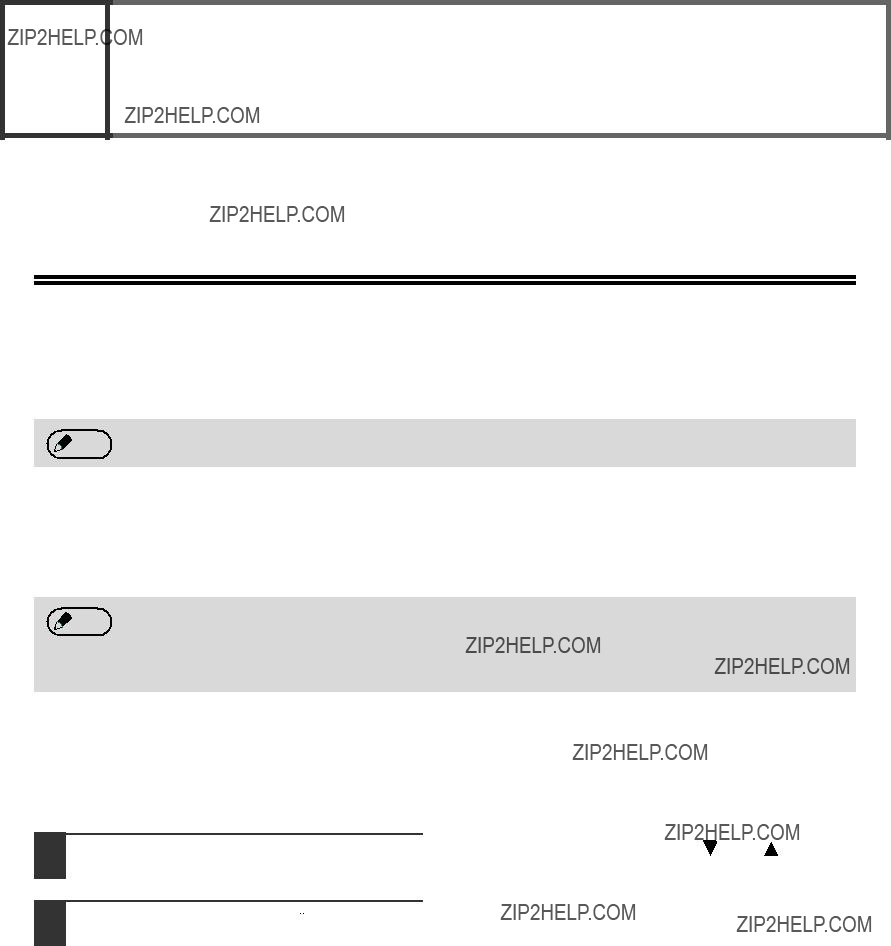
5 CONVENIENT METHODS OF
USE
This chapter explains convenient functions that can be used when sending a fax, connecting an extension phone, and other features that expand the scope of use of the fax machine. Please read those sections that are of interest to you.
CONNECTING AN EXTENSION PHONE
You can connect a telephone to the machine and use it as an extension phone to make and receive calls like any normal phone. Fax reception can also be activated from an extension phone connected to the machine. (Remote operation)
If you connect a combination telephone/answering machine to the machine, you will not be able to use the
USING AN EXTENSION PHONE
Using an extension phone for voice calls
An extension phone connected to the machine can be used to place and receive voice calls just like a normal phone.
??? If the fax reception mode is set to auto reception, you must lift the phone to answer a call before the machine Note automatically begins reception. The machine is initially set to answer calls on two rings. The number of rings can be changed to any number from 0 to 9 in the system settings. (See "#OF RINGS AT. RX" on page 108.)
???If you cannot hear a dial tone when you pick up the extension phone, the machine is sending or receiving a fax. Replace the phone.
Activating fax transmission
Place the original on document glass or in the SPF/RSPF, adjust the original size, resolution, and exposure settings as needed, and then follow the steps below.
1 Lift the extension phone and call the receiving party.
2 Press the [START] key (  ).
).
CONVENIENT METHODS OF USE
SETTING THE RECEPTION MODE
The machine normally receives faxes automatically after ringing; however, when an extension phone is connected, you can set the reception mode to MANUAL. This will allow you to talk to the other party first and then receive a fax. This is convenient when you only have one telephone line and receive more voice calls than faxes. You must answer all calls on the extension phone, and activate fax reception after you verify that a call is a fax transmission.
1 Press the [COMM. SETTING] key in the initial state of Fax mode.
2 Select "RX" with the [  ] or [
] or [  ] key.
] key.
3 Press the [OK] key.
GHI
BACK OK
PQRS
4 Select "AUTO" or "MANUAL" with the [ ] or [
] or [ ] key.
] key.
RCV. SETTING
AUTO
MANUAL
5 Press the [OK] key.
OK
5
Activating fax reception from an extension phone (remote reception)
After receiving a call on the extension phone, you can activate fax reception from the extension phone. This is called "remote reception". After speaking, or when you hear a fax tone through the extension phone, perform the following procedure with the extension phone still lifted. (If you made the call, remote reception will not be possible.)
The following procedure is not possible if you are on a pulse dial line and your extension phone cannot produce Note tone signals. To find out whether your extension phone can produce tone signals, refer to the manual for your
extension phone.
1 If you are on a pulse dial line, set your phone to issue tone signals.
Refer to your phone's manual to set the phone to issue tone signals.
If your phone is already set to issue tone signals, proceed to the next step.
2 Press the  key once and the
key once and the  key twice on the extension phone.
key twice on the extension phone.
Fax reception is activated.
3 Replace the extension phone.
The one-digit number that is used to activate fax reception from an extension phone (initially set to "5") is called Note the "remote reception number". You can change this number to any number from 0 to 9 in the system settings.
(See "REMOTE RECEPTION" on page 102.)
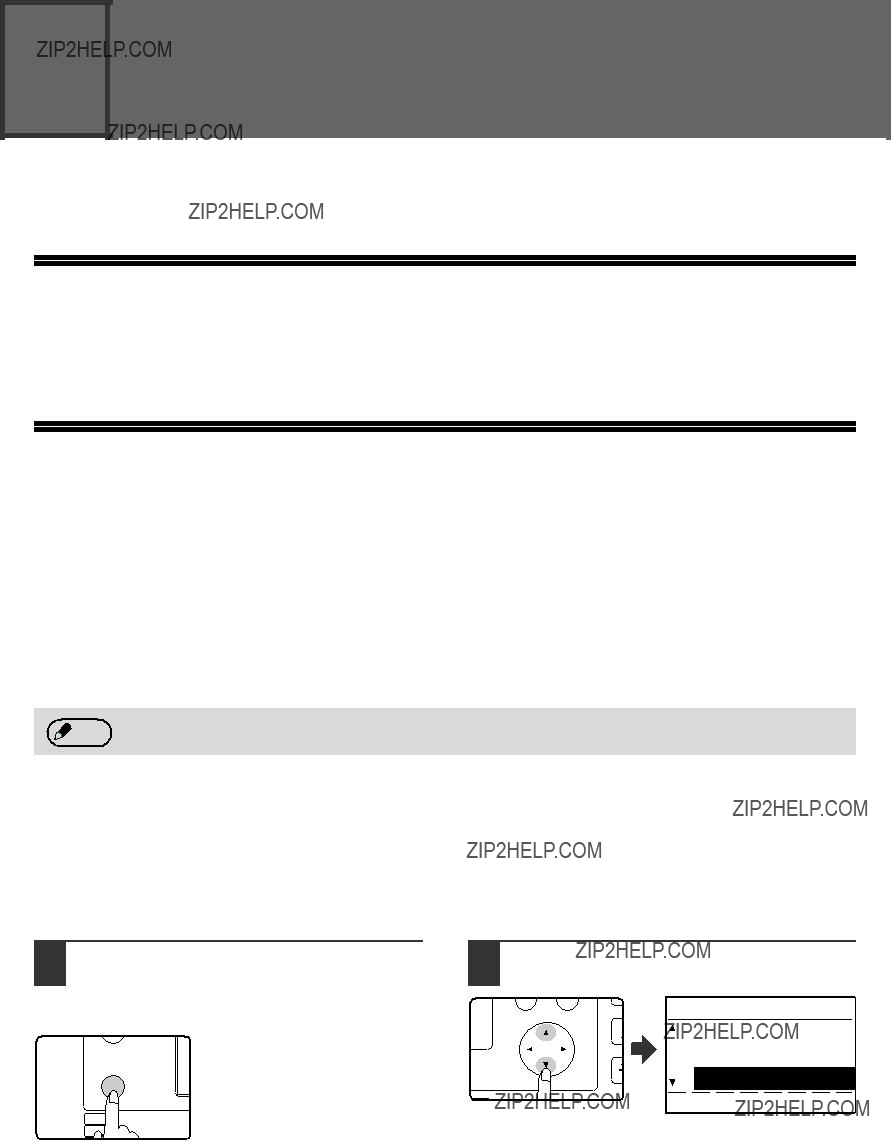
This chapter explains the procedures for programming auto dial keys (Rapid keys, Speed Dial numbers, and group keys), programs, and F-code operations, and how to print out lists of programmed information.
PROGRAMMING
Auto dial numbers (Rapid keys, Speed Dial numbers, and group keys), programs, and F-code operations are stored and edited at the operation panel of the machine. This chapter explains how to use the operation panel for these procedures.
STORING, EDITING, AND DELETING
AUTO DIAL NUMBERS AND PROGRAMS
This section explains the procedures for storing, editing, and deleting auto-dial numbers (Rapid keys, Speed Dial numbers, and group keys) and programs, which simplify the transmission procedure. To use Rapid keys, Speed Dial numbers, and group keys, see "TRANSMISSION BY AUTO-DIALLING (RAPID DIALLING AND GROUP DIALLING)" on page 19. To use a program, see "USING A PROGRAM" on page 44.
A combined total of 50 Rapid keys and group keys can be stored, 300 Speed Dial numbers, and 9 programs can be stored. If you attempt to store more than this, a warning message will appear. In this case, delete any auto-dial numbers or programs that are no longer needed (see page 73 to delete Rapid keys and Speed Dial numbers, page 75 to delete group keys, and page 77 to delete programs), and then store the new auto-dial number or program.
STORING, EDITING, AND DELETING AUTO-DIAL
NUMBERS (RAPID KEYS, SPEED DIAL NUMBERS, AND
GROUP KEYS)
Auto dial numbers are stored in the auto dial storing screen. Follow the steps below to display the auto dial storing screen, and then store an auto dial number.
1 In Fax mode, press the [SPECIAL FUNCTION] key.
Begin the following procedure from the base screen of Fax mode.
2 Select "ENTRY" with the [ ] or [
] or [ ] key.
] key.
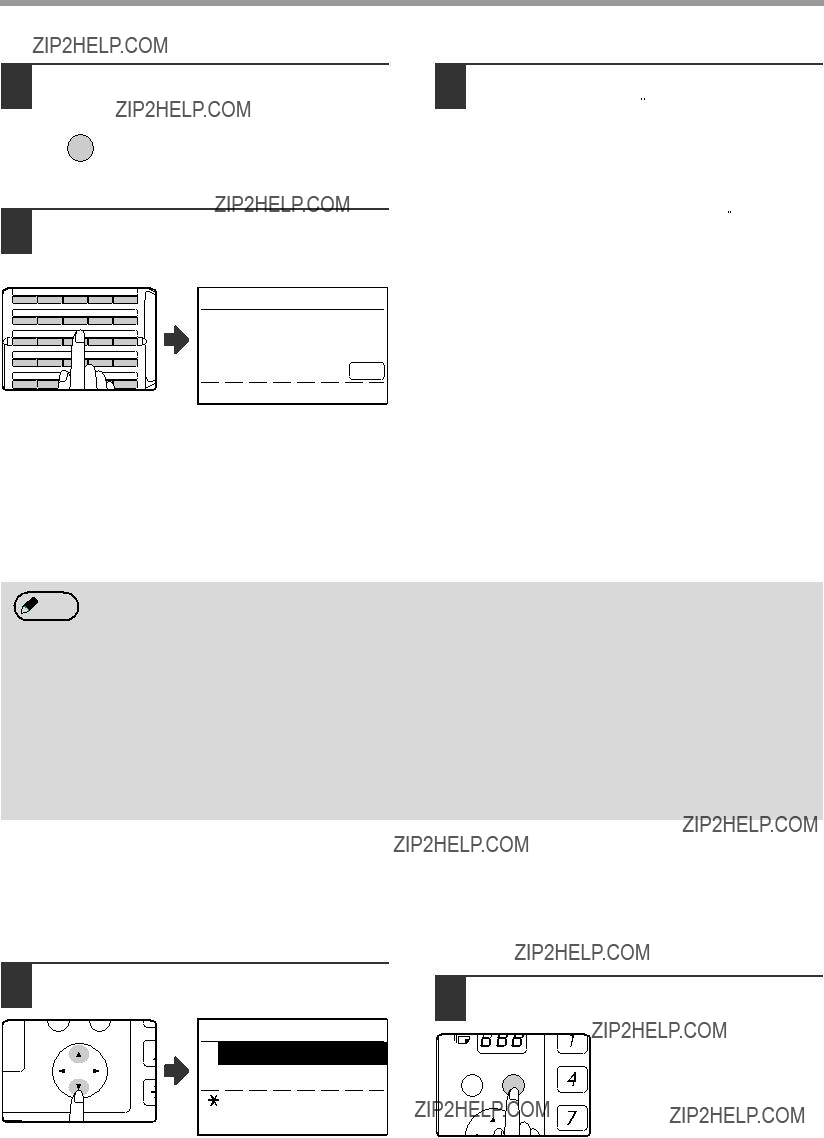
11 Press the [OK] key.
OK
12 Enter search characters (see "ENTERING CHARACTERS" on page 86).
Up to 10 search characters can be entered.
Only "Uppercase" characters should be used in "KEY WORD" to arrange the addresses in alphabetical order.
The search characters function as a keyword if you need to search for the destination when sending a fax. (Page 20)
13 To finish the storing procedure, press the [START] key ( ). If you wish to program an option such as an F-code, chain dialling, transmission speed, or international transmission mode, press the [OK] key.
). If you wish to program an option such as an F-code, chain dialling, transmission speed, or international transmission mode, press the [OK] key.
???If you pressed the [START] key (  ), you will return to step 7. If you wish to store another Rapid key or Speed Dial number, repeat steps 7 to 13. If you have finished storing auto-dial numbers, press the [BACK] key.
), you will return to step 7. If you wish to store another Rapid key or Speed Dial number, repeat steps 7 to 13. If you have finished storing auto-dial numbers, press the [BACK] key.
???If you pressed the [OK] key, go to the appropriate page for the option that you wish to program.
To program F-code settings, see "F-code settings" which follows.
To select "CHAIN DIAL", go to "Chain Dialling" on page 69.
To set the "TRANSMISSION SPEED", go to "Transmission speed setting" on page 70.
To set the "INTERNATIONAL TRANSMISSION MODE", go to "International transmission mode setting" on page 70.
About the setting options
[F-code settings]
To program F-code settings, complete steps 1 through 13 on pages 66 to 68 and then follow the steps below.
1 Select "SUB ADDRESS" with the [ ] or [
] or [ ] key.
] key.
2 Press the [OK] key.
GHI
BACK OK
PQRS
2
U V W XYZ SP
L M N O 42 43 44 45
Q R S T 47 48 49 50
K
41
P
46
G H I J 37 38 39 40
F
36
B C D E 32 33 34 35
A
31
26 27 28 29 30
Press the Rapid key ([01] to [50]) that you wish to program as a group key.
If you press a Rapid key that
has already been programmed, a warning message will appear.
Press a Rapid key ([01] to [50]).
1
[Storing a group key]
To store a group key, follow steps 1 through 6 on pages 66 to 67 and then follow the steps below.
Group key dialling is an automatic dialling Note function where by multiple destinations (Rapid
keys, Speed Dial numbers, and full fax numbers entered with the numeric keys) are programmed into a Rapid key. If you frequently send faxes to the same group of destinations using broadcast transmission, which is used to send the same document to multiple destinations in a single operation (page 31), it is convenient to program those destinations into a group key.
Enter a group name (see "ENTERING CHARACTERS" on page 86).
Up to 36 characters can be entered for the name. A group name must be entered.
3 Press the [OK] key.
GHI
BACK OK
PQRS
4 Enter search characters (see "ENTERING CHARACTERS" on page 86).
Up to 10 search characters can be entered.
The search characters function as a keyword if you need to search for the destination when sending a fax (page 20).
5 Store the destinations using Rapid keys, Speed Dial numbers, and the numeric keys.
??? To store a Rapid key, press the Rapid key that you wish to use ([01] to [50]).
If you press an incorrect key, press the [C] key and then press the correct key.
???To store a Speed Dial number, press the [SPEED] key and then enter the desired Speed Dial number
the duration of the pause, see "PAUSE TIME" (page 100). When you have finished entering the fax number, press the [OK] key.
6 Repeat step 5 for all of the destinations that you wish to store in the group key.
Up to 150 destinations can be stored in a group key. (However, note that when multiple group keys are programmed, the total number of destinations that can be stored in all group keys is 200.)
7 Press the [START] key ( ).
).
STORING, EDITING AND DELETING PROGRAMS
You can store a transmission method*, cover sheet/message, transmission settings, dual pages, and/or resolution/exposure settings in a program. This will allow you to use the settings for a transmission by means of a simple operation (see "USING A PROGRAM" on page 44).
*Transmission methods: normal transmission, broadcast transmission, polling, serial polling, F-code transmission, F-code polling
To store a program, follow steps 1 through 6 on pages 66 to 67 and then follow the steps below.
1 Select "ENTRY" with the [  ] or [
] or [  ] key.
] key.
???To edit a program, select "CHANGE" and press the [OK] key. Next, follow the steps in "EDITING PROGRAMS" on page 77.
???To delete a program, select "DELETE" and press the [OK] key. Next, follow the steps in "DELETING PROGRAMS" on page 77.
[STORING A PROGRAM]
6 Select the program that you wish to store with the [ ] or [
] or [ ] key.
] key.
2 Press the [OK] key.
GHI
BACK OK
PQRS
3 Select "PROGRAM" with the [ ] or [
] or [ ] key.
] key.
ENTRY
DIAL
PROGRAM
SUB ADD SETTING
4 Press the [OK] key.
5 Select "ENTER", "CHANGE", or "DELETE" with the [ ] or [
] or [ ] key.
] key.
PROGRAM
ENTER
CHANGE
DELETE
???To store a program, select "ENTER" and press the [OK] key. Continue from step 6 of "STORING A PROGRAM".
PROGRAM
XXXXXX
??? ??? ??? ??? ??? ???
??? ??? ??? ??? ??? ???
If you select a program that has already been stored, a message appears. Select a program that has not been stored, or clear the program (page 77) and then select it.
7 Press the [OK] key.
8 Enter a program name (see "ENTERING CHARACTERS" on page 86).
Up to 36 characters can be stored for the name of the program. A program name must be entered.
9 Press the [OK] key.
PROGRAMMING, EDITING, AND
DELETING F-CODE MEMORY BOXES
The procedure for programming a box for F-code transmission is explained here. There are three types of F-code boxes: F-code public boxes (page 81), F-code confidential boxes (page 79), and F-code relay group boxes (page 80). F-code boxes are programmed, edited, and deleted as explained below.
PROGRAMMING AN F-CODE MEMORY BOX
A box name, sub-address, passcode, and the appropriate functions are programmed in an F-code box.
???A passcode can be omitted.
???Up to 10 F-code boxes of each type can be programmed. If 10 F-code boxes of one type have already been programmed, a warning message will appear and you will not be able to program a new box. Delete any unused F-code boxes (page 81) and then program the new box.
1 In Fax mode, press the [SPECIAL FUNCTION] key.
Begin the following procedure from the base screen of Fax mode.
5 Press the [OK] key.
OK
6 Select "S.A. CONF. BOX", "S.A. RELAY GRP", "S.A. MEM POLLING", or "CHANGE/DELETE" with the [ ] or [
] or [ ] key.
] key.
2 Select "ENTRY" with the [ ] or [
] or [ ] key.
] key.
???To program an F-code confidential box, select "S.A. CONF. BOX" and press the [OK] key. Next, follow the steps in
"PROGRAMMING AN
F-CODE CONFIDENTIAL BOX" on page 79.
SUB ADD SETTING
S.A. CONF. BOX
S.A. RELAY GRP
S.A. MEM POLLING
CHANGE/DELETE
3 Press the [OK] key.
GHI
BACK OK
PQRS
4 Select "SUB ADD SETTING" with the [ ] or [
] or [ ] key.
] key.
???To program an F-code relay group (box), select "S.A. RELAY GRP" and press the [OK] key. Next, follow the steps in
"PROGRAMMING AN
F-CODE RELAY GROUP" on page 80.
???To program an F-code public (polling memory) box, select "S.A. MEM POLLING" and press the [OK] key. Next, follow the steps in "PROGRAMMING
F-CODE PUBLIC
(POLLING MEMORY) BOXES" on page 81.
SUB ADD SETTING
S.A. CONF. BOX
S.A. RELAY GRP
S.A. MEM POLLING
CHANGE/DELETE
SUB ADD SETTING
S.A. CONF. BOX
S.A. RELAY GRP
S.A. MEM POLLING
CHANGE/DELETE
ENTRY
DIAL
PROGRAM
SUB ADD SETTING
???To edit or delete an F-code confidential box, F-code relay group, or F-code public box, select "CHANGE/DELETE" and then press the [OK] key. Next, follow the steps in
"EDITING AND DELETING
F-CODE MEMORY BOXES" on page 81.
SUB ADD SETTING
S.A. CONF. BOX
S.A. RELAY GRP
S.A. MEM POLLING
CHANGE/DELETE
[PROGRAMMING AN F-CODE CONFIDENTIAL BOX]
Follow the steps below to program an F-code confidential reception box. An F-code (sub-address and passcode) for F-code confidential reception and a print passcode to print out received faxes are programmed in each box. Up to 10 boxes can be programmed. To check the contents of a programmed box, print the following list: "PRINT - REPORT - SUB ADD SET LIST". (Page 85)
To program an F-code confidential box, follow steps 1 through 6 on page 78 and then follow the steps below.
7 Select an unused box ("- - - - - -") with the [  ] or [
] or [  ] key.
] key.
8 Press the [OK] key.
GHI
BACK OK
PQRS
12 Enter a passcode (maximum 20 digits) with the numeric keys.
See steps 5 and 6 on page 69.
13 Enter the print passcode (4 digits) with the numeric keys.
The characters "  " and "#" cannot be used. The print passcode cannot be omitted. Take care not to forget the programmed print passcode. If you forget the passcode, consult your Sharp dealer.
" and "#" cannot be used. The print passcode cannot be omitted. Take care not to forget the programmed print passcode. If you forget the passcode, consult your Sharp dealer.
14 Press the [OK] key.
OK
9 Enter a name for the F-code confidential box (see "ENTERING CHARACTERS" on page 86).
Up to 36 characters can be entered for the name. A box name must be entered.
10 Press the [OK] key.
OK
11 Enter a sub-address (maximum 20 digits) with the numeric keys.
See steps 3 and 4 on page 69.
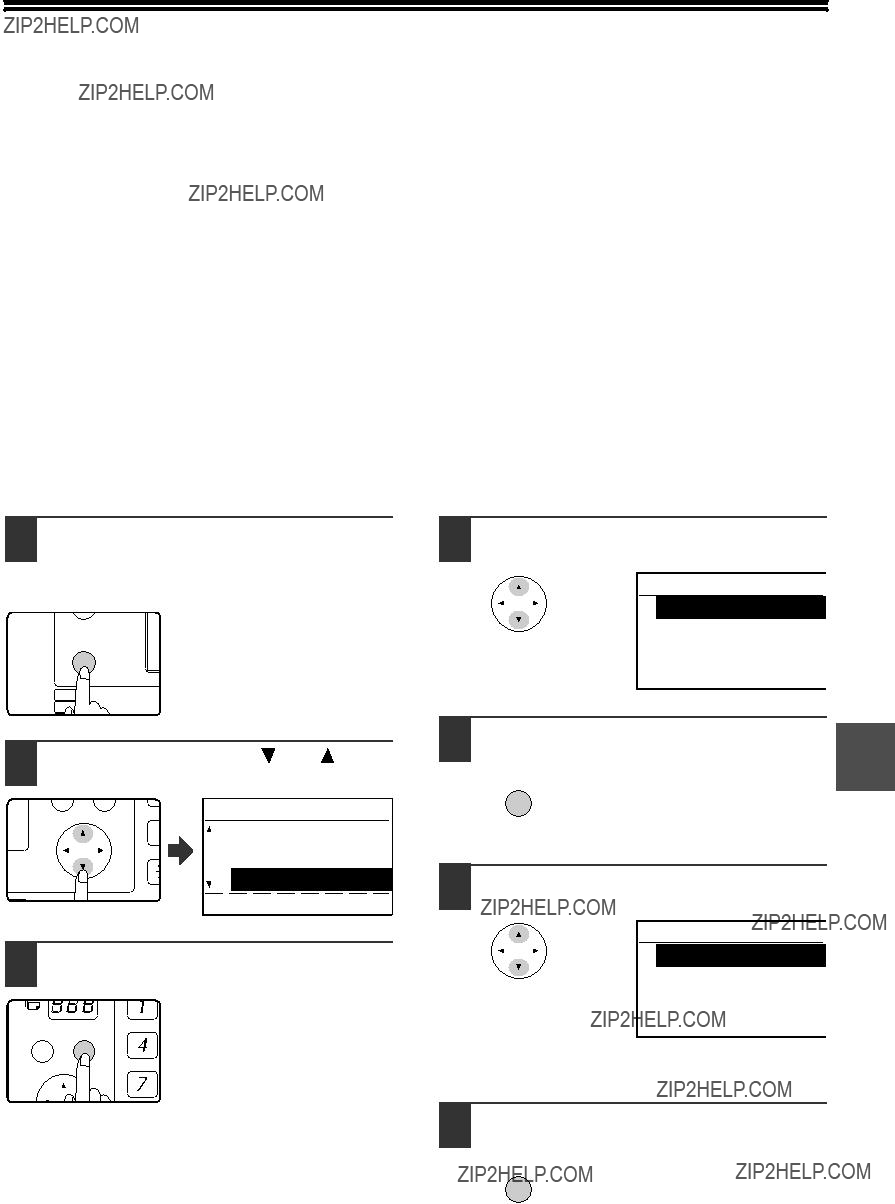
PRINTING LISTS OF PROGRAMMED
INFORMATION, SETTINGS, AND
COMMUNICATION ACTIVITY
You can print lists showing programmed information, settings, and communication activity. The following lists can be printed.
??? ACTIVITY REPORT: This report shows information on your most recent transmissions and receptions, including communication time and the other party.
???TIMER LIST: This list shows timer transmissions and recall mode jobs.
???MEM. POLLING LIST: This list shows information on the documents and settings stored for memory polling and
F-code memory polling.
???RAPID # LIST:This list shows the information stored in each Rapid key that has been programmed.
???SPEED # LIST:This list shows the information stored in each Speed Dial number that has been programmed.
???GROUP LIST: This list shows the information stored in each group key that has been programmed.
???TELEPHONE # LIST:This list shows the destinations that have been stored in auto dial numbers in the order of
their search characters.
???PROGRAM LIST: This list shows the contents of each program that has been stored.
???SUB ADD SET LIST: This list shows the sub-addresses and passcodes that have been programmed for F-code
communication. (Note that print passcodes are not shown in the list.)
??? CONF. RX LIST: This list shows the confidential box numbers that have received confidential faxes and the number of pages received.
??? INBOUND ROUTING LIST:This list shows various settings used at the time of inbound routing.
1 In Fax mode, press the [SPECIAL FUNCTION] key.
Begin the following procedure from the base screen of Fax mode.
4 Select "REPORT" with the [ ] or [
] or [ ] key.
] key.
PRINT
REPORT
CONF. RX DATA
ACC
3 Press the [OK] key.
GHI
BACK OK
PQRS
6 Select the list that you wish to print with the [ ] or [
] or [ ] key.
] key.
REPORT
ACTIVITY REPORT
TIMER LIST
MEM. POLLING LIST
RAPID # LIST
See the explanation of the lists that can be printed above.

ENTERING CHARACTERS
This section explains how to enter and edit characters for names of rapid dial numbers, Speed Dial numbers, and group keys, as well as account names, program names, and search characters for the address list.
CHARACTERS THAT CAN BE ENTERED
Characters that can be entered for names
The following characters can be entered:
???Up to 36 characters can be entered for a name.
However, up to 18 characters can be entered for a account name or sender's name.
???Upper case alphabet, lower case alphabet, numbers, special characters, symbols
Characters that can be used for search characters
The following characters can be used:
???Up to 10 characters can be entered for search characters.
???Upper case alphabet, lower case alphabet, numbers, special characters
???When a destination name includes a symbol, the symbol cannot be stored as a search character.
???Search characters can be edited.
CHANGING TO ENTRY MODE
Open the Rapid key overlay to enter alphabetical characters.
When the Rapid key overlay is open
When the Rapid key overlay is open, characters can be entered. To toggle between upper case and lower case letters, press the [SHIFT] key.
When the Rapid key overlay is closed
Closing the Rapid key overlay stores characters that have been entered to that point.
PROGRAMMING
CHARACTER ENTRY KEYS
To enter characters, use the character entry keys on the operation panel. The characters entered by each key and key functions are as follows.
Example: Entering XY
Press the [XYZ] key once, press the [ ] key once to move the cursor, and then press the [XYZ] key twice.
] key once to move the cursor, and then press the [XYZ] key twice.
INITIAL PROCEDURE FOR ENTERING CHARACTERS
Entering alphabetical characters (example: TPS)
1 Open the Rapid key overlay.
ENTER NAME
ABC
To switch between upper case letters and lower case letters, press the [SHIFT] key.
2 Enter "T", "P" and "S" with the letter keys.
The letters are stored and the cursor moves to the space after the letters.
To change a character, press the [C] key. Note The character directly to the left of the
cursor is cleared.
If the cursor is over a character, that character is cleared.
Entering numbers (example: 123)
1 Enter "1", "2", and "3" with the numeric keys.
??? To change a character, press the [C] Note key. The character directly to the left
of the cursor is cleared.
???If the cursor is over a character, that character is cleared.
Entering symbols
1 Press the [SYMBOL] key.
2 Select the symbol that you wish to enter with the [ ][
][ ][
][ ][
][ ] keys.
] keys.
1/ 2
To move to the next page, move the cursor to the bottom line and press the [  ] key. To move back to the previous page, move the cursor to the top line and press the [
] key. To move back to the previous page, move the cursor to the top line and press the [  ] key. You can also change pages by pressing the [
] key. You can also change pages by pressing the [ ] key when the cursor is at the right end of the bottom line, or the [
] key when the cursor is at the right end of the bottom line, or the [ ] key when the cursor is at the left end of the top line.
] key when the cursor is at the left end of the top line.
3 Press the [OK] key.
ENTER NAME
ABC
The symbol selected with the cursor is entered and you return to the character entry screen.
If the Rapid key overlay is opened or closed Note while a symbol is being selected, the symbol currently selected with the cursor is entered
and you return to entry mode.

This chapter contains information to help you make efficient use of the fax features of the machine, including solutions to common problems.
WHEN A TRANSACTION REPORT IS PRINTED
The machine has been set to automatically print a transaction report to notify you of the result when a transmission is not successful or when the Broadcast transmission function is used.
When transmission is not successful and a transaction report similar to the following is printed,
"FOLLOWING DATA CANNOT BE SENT. PLEASE HAND THIS REPORT TO XXX.", read the report and take appropriate action.
The transaction report is set at the factory to print at the times indicated in grey 
 below, however, the times at which the report is printed can be changed in the system settings. (See "LIST SETTING - PRINT SELECTION" on page 99.)
below, however, the times at which the report is printed can be changed in the system settings. (See "LIST SETTING - PRINT SELECTION" on page 99.)
???Normal transmission: ALWAYS PRINTS / ERROR ONLY /NEVER PRINTS
???Broadcast transmission: ALWAYS PRINTS /ERROR ONLY/NEVER PRINTS
???Original image print setting*: ALWAYS PRINTS / ERROR ONLY /NEVER PRINTS
???Reception: ALWAYS PRINTS /ERROR ONLY/ NEVER PRINTS
???Confidential reception: ALWAYS PRINTS /NEVER PRINTS
The Transaction Report shows the date of transmission, the time transmission began, the other party's name, the duration of the operation, the number of pages, the type of transmission, the result, the department, and other information.
*You can select whether or not part of the transmitted original is printed with transaction reports that are printed for normal transmissions and broadcast transmissions.
The list count appears in the "#" column of the Transaction Report and a serial number appears in the FILE
INFORMATION APPEARING IN THE TYPE/NOTE COLUMN
Information such as the type of transmission and type of error appears in the TYPE/NOTE column of the Transaction Report or Activity Report (page 92). The following notes may appear.
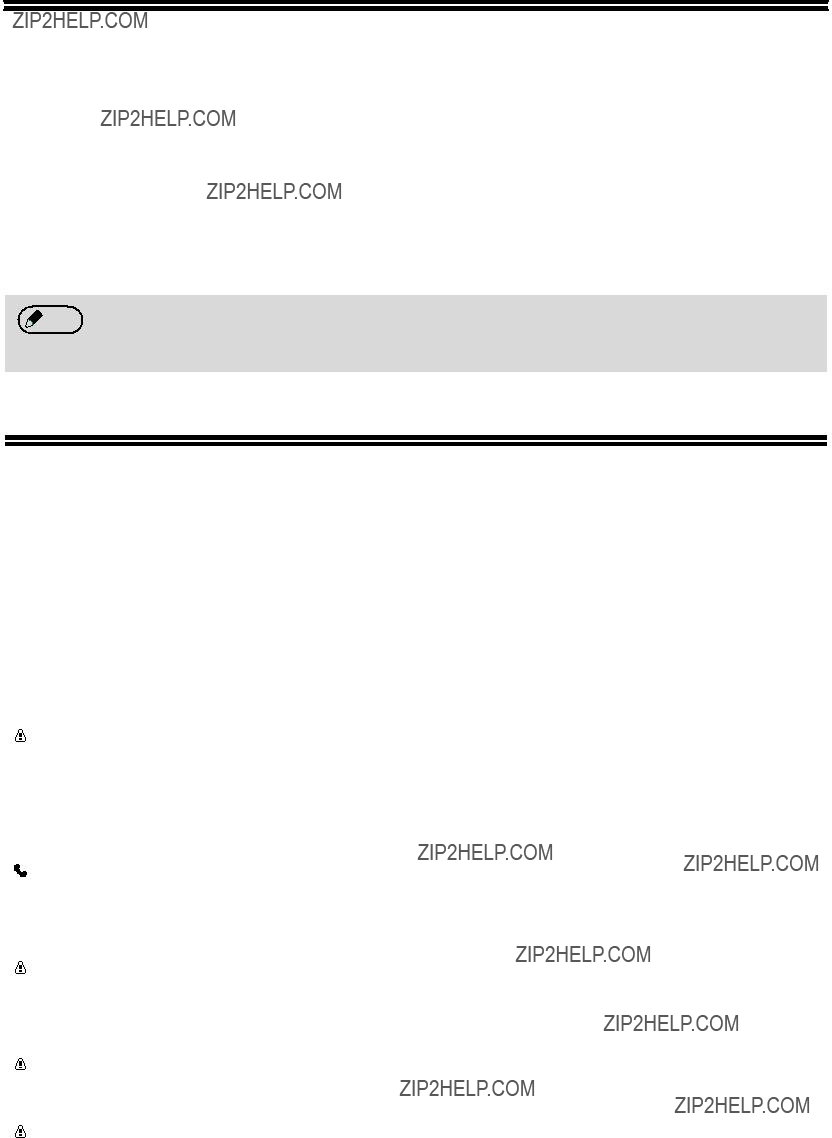
VIEWING THE COMMUNICATION ACTIVITY
REPORT AT REGULAR INTERVALS
(Communication activity report)
Your machine keeps a record of the most recent 50 transactions (both transmissions and receptions) that were performed. The record includes the date of the transaction, the other party's name, the duration, and result. You can have the report automatically printed when the number of transactions exceeds 50, or at a specified time. This allows you to check the machine's activity at regular intervals.
The machine is initially set (factory default setting) to not print the report. To have the report printed, change the setting in the system settings. (See "LIST SETTING - AUTO LISTING" on page 99.)
???The activity report can also be printed out on demand. (See "PRINTING LISTS OF PROGRAMMED INFORMATION, SETTINGS, AND COMMUNICATION ACTIVITY" on page 85.)
WHEN AN ALARM SOUNDS AND A
WARNING MESSAGE IS DISPLAYED
When an error occurs during a transaction, an alarm will sound and a message will appear in the display. If one of the following messages appears, follow the instructions in the table.
TROUBLESHOOTING
SELF-DIAGNOSTIC FUNCTION
The machine has a self-diagnostic function that automatically stops operation if a problem occurs in the machine. If a problem occurs in fax mode, the following display appears.
MESSAGES DURING NORMAL OPERATION
PROBLEMS AND SOLUTIONS
If you experience a problem with the fax function, first check the following table.
This section describes problems related to the fax function. For problems related to general operation of the machine, see "TROUBLESHOOTING" in the Operation Guide for the machine.
The system settings are used by the administrator (administrator of the machine) to customize certain features of the machine to better meet the needs of users.
This section explains system settings for the fax features of the machine. For system settings that are for the copy function, print function, and network scanner function, see the respective manuals for those functions. For system settings for general use of the machine, see the "SYSTEM SETTINGS GUIDE" in the Operation Guide for the machine.
To use the system settings, the administrator password must be entered.
For the initial administrator password set at the factory, see the Start Guide.
ADMINISTRATOR SETTINGS LIST
SYSTEM SETTINGS FOR THE FAX FUNCTION
SYSTEM SETTINGS
ADMINISTRATOR SETTINGS MENU
The system settings are accessed via the following menu structure.
Refer to this menu when enabling or disabling the settings that are explained beginning on page 99. Some settings contain an additional level of settings (a settings screen).
Level 1
 FAX SETTINGS
FAX SETTINGS
Administrator Password
PROCEDURE FOR USING THE SYSTEM
SETTINGS
The system settings can be accessed from any mode (copy, fax, print, and scan mode). When the setting is completed, you will return to the previous mode.
???Faxes cannot be sent or received while a system setting is being used.
???A system setting cannot be used while a fax is being sent or received, while a voice call is being made, or while a received fax is being printed.
INITIAL PROCEDURE
1 Press the [SPECIAL FUNCTION] key.
ON LINE
DATA SPECIAL
FUNCTION
2 Select "SYSTEM SETTINGS" with the [  ] or [
] or [  ] key.
] key.
ACC
3 Press the [OK] key.
GHI
BACK OK
PQRS
5 Select "FAX" with the [ ] or [
] or [ ] key.
] key.
MODE SELECT
COPIER
PRINTER
SCANNER
FAX
To use a system setting for copy mode, select "COPIER".
6 Press the [OK] key.
OK
7 Select a setting for the desired setting as explained on the following pages.
Settings for the following functions are available: LIST PRINT/SET (page 99)
INITIAL SETTING (page 100) SENDING FUNCTION (page 105) RCV. FUNCTION (page 108) POLLING SECURITY (page 111)
4 Enter the five-digit administrator password with the numeric keys.
???As you enter each digit, "-" changes to " ".
".
???If make a mistake, press the [C] key and re-enter the number.
???If this is the first time you are programming the administrator password, enter the factory default code. (See "ADMINISTRATOR PASSWORD NUMBER: FACTORY SETTING" in the Operation Guide for the machine.
8 Press the [CA] key to exit the settings.
???To cancel a setting before it is completed, press the [CA] key.
???See "ENTERING CHARACTERS" (page 86) for the procedure for entering letters.
SYSTEM SETTINGS FOR THE FAX FUNCTION
LIST PRINT/SET
This setting is used to print lists showing current system settings and other programmed information.
LIST PRINT
1 Follow steps 1 through 6 of "INITIAL PROCEDURE" (page 98).
???"SYSTEM SET LIST", "JUNK FAX # LIST" or "ACC. USAGE LIST" can be selected.
???Printing begins when you end the system setting.
"TRANSMISSION", "BROADCAST", "ORIGINAL IMAGE PRINT SETTING", "RECEPTION" or "CONF. RECEPTION" can be selected.
6 Select the desired print setting with the [  ] or [
] or [  ] key and then press the [OK] key.
] key and then press the [OK] key.
???If you selected "TRANSMISSION", select "ALWAYS PRINTS", "ERROR ONLY", or "NEVER PRINTS".
???If you selected "BROADCAST", select "ALWAYS PRINTS", "ERROR ONLY", or "NEVER PRINTS".
???If you selected "ORIGINAL IMAGE PRINT SETTING", select "ALWAYS PRINTS", "ERROR ONLY", or "NEVER PRINTS".
???If you selected "RECEPTION", select "ALWAYS PRINTS", "ERROR ONLY", or "NEVER PRINTS".
???If you selected "CONF. RECEPTION", select "ALWAYS PRINTS" or "NEVER PRINTS".
"ORIGINAL IMAGE PRINT SETTING" is Note used to have part of the first page of the
transmitted document printed on the transaction report. This setting is not effective when the transaction report is set to not print out.
LIST SETTING
PRINT SELECTION
This setting is used to select the conditions for printing out transaction reports for normal transmission, broadcast transmission, original print, reception, and confidential reception.
NEVER PRINTS
Normally the settings indicated by shading 
 above are selected.
above are selected.
AUTO LISTING
This setting is used to have the activity report that is stored in the machine's memory printed out at regular intervals. You can choose to have the report automatically printed each time the number of stored transactions exceeds 50, or have the report printed at a specified
time every day (only once per day). You can also 8 enable both print methods.
The report is normally set to not print out. To have the report automatically printed when the number of stored transactions (the combined total of transmissions and receptions) exceeds 50, select "AUTO PRINT REPT AT LIMIT (50)".
To have the report printed at a specified time, enable "PRINT DAILY AT DESIGNATED TIME" and enter the desired time.
1 Follow steps 1 through 6 of "INITIAL PROCEDURE" (page 98).
Select "INITIAL SETTING" with the [ ] or [ ] key and then press the [OK] key.
OWN PASSCODE SET
Use this setting to program the fax number of the machine and the name of the user. The programmed name and number are printed at the top of each fax page you send. The number is also used as a passcode when performing polling reception "USING THE POLLING FUNCTION" (page 36).
You can check your programmed name and number by printing out the "SYSTEM SET LIST". (Page 99)
???A maximum of 20 digits can be stored for the fax number.
???A maximum of 18 letters can be stored for the name.
???If you make a mistake, press the [C] key and re-enter the number.
???To enter "+", press the  key.
key.
6 Enter your name and then press the [START] key (  ).
).
See "ENTERING CHARACTERS" (page 86) for the procedure for entering letters.
(1)Select "DELETE" in step 4 and then press the [OK] key.
(2)Select "DELETE" with the [  ] or [
] or [  ] key and then press the [OK] key.
] key and then press the [OK] key.
SPEAKER VOLUME
This setting is used to adjust the on-hook volume, the ringing volume, the line monitor volume, the TX/RX end sound volume, the original scanning end sound volume, and the tone output volume. All volume settings are initially set to "MIDDLE".
1 Follow steps 1 through 6 of "INITIAL PROCEDURE" (page 98).
2 Select "INITIAL SETTING" with the [  ] or [
] or [  ] key and then press the [OK] key.
] key and then press the [OK] key.
3 Select "SPEAKER VOLUME" with the [  ] or [
] or [  ] key and then press the [OK] key.
] key and then press the [OK] key.
???"HIGH", "MIDDLE" or "LOW" can be selected for the on hook volume.
???"HIGH", "MIDDLE", "LOW" or "OFF" can be selected for volumes other than the on hook volume.
TX/RX END SOUND
This setting is used to select the beep pattern that signals the end of transmission or reception. "PATTERN 1", "PATTERN 2" or "PATTERN 3" can be selected.
1 Follow steps 1 through 6 of "INITIAL PROCEDURE" (page 98).
2 Select "INITIAL SETTING" with the [  ] or [
] or [  ] key and then press the [OK] key.
] key and then press the [OK] key.
3 Select "TX/RX END SOUND" with the [  ] or [
] or [  ] key and then press the [OK] key.
] key and then press the [OK] key.
4 Select "SEND" or "RECEIVE" with the [  ] or [
] or [  ] key and then press the [OK] key.
] key and then press the [OK] key.
5 Select "PATTERN 1", "PATTERN 2", or "PATTERN 3" with the [  ] or [
] or [  ] key and then press the [OK] key.
] key and then press the [OK] key.
Before pressing the [OK] key to store your selection, you can press the  key to listen to the selected pattern.
key to listen to the selected pattern.
TX/RX END SOUND LENGTH
This setting is used to select the length of the end sound in seconds. Selections are "2.0 sec", "2.5 sec", "3.0 sec", "3.5 sec", and "4.0 sec". "3.0 sec" is normally selected.
1
2 
 8
8
3 Select "TX/RX END SOUND LENGTH" with the [  ] or [
] or [  ] key and then press the [OK] key.
] key and then press the [OK] key.
4 Select the number of seconds with the [  ] or [
] or [  ] key and then press the [OK] key.
] key and then press the [OK] key.
???The recall interval can be set from 1 to 15* minutes.
???After finishing step 5, if you do not wish to change the number of recall attempts, press the [BACK] key to exit.
*Varies depending on country and region.
???If you do not wish to have recalling take place, set the number of attempts to "0".
???If the recall interval is set to "0", the machine will immediately call again after the connection is broken due to the line error.
???If you do not wish to have recalling take place, set the number of attempts to "0".
??? If you made a mistake in step 5 or step 7, Note move the cursor to the mistake with the [ ]
]
or [ ] key and enter the correct number.
] key and enter the correct number.
???Even if this setting is enabled, the machine will not re-attempt the call when a fax is sent by manual transmission.
RECALL SET (ERR)
When sending a fax, this setting is used to select whether or not the machine will automatically re-attempt the call if the transmission fails due to a line error. Normally the machine is set to make 1* recall attempt at intervals of 1* minute.
If you do not wish to have recalling take place, set the number of attempts to "0" (steps 6 and 7).
* Varies depending on country and region.
1 Follow steps 1 through 6 of "INITIAL PROCEDURE" (page 98).
2 Select "SENDING FUNCTION" with the [  ] or [
] or [  ] key and then press the [OK] key.
] key and then press the [OK] key.
3 Select "RECALL SET(ERR)" with the [  ] or [
] or [  ] key and then press the [OK] key.
] key and then press the [OK] key.
If you do not wish to change the recall interval setting, go to step 6.
??? If you made a mistake in step 5, move the Note cursor to the mistake with the [ ] or [
] or [ ]
]
keys and enter the correct number.
???Even if this setting is enabled, the machine will not re-attempt the call when a fax is sent by manual transmission.
RING TIMEOUT IN AUTO TX
When sending a fax by automatic transmission (see "Storing transmission jobs (memory transmission)" on page 23), this setting lets you select the amount of time that the machine waits before breaking the connection when the other machine does not answer your machine's call. If the other machine does not respond within this set time, your machine will automatically break the connection.
Time selections are "30 SEC.", "45 SEC." and "60 SEC.". Normally "45 SEC." is selected.*
* Varies depending on country and region.
1 Follow steps 1 through 6 of "INITIAL PROCEDURE" (page 98).
2 Select "SENDING FUNCTION" with the [  ] or [
] or [  ] key and then press the [OK] key.
] key and then press the [OK] key.
3 Select "RING TIMEOUT IN AUTO TX" with the [  ] or [
] or [  ] key and then press the [OK] key.
] key and then press the [OK] key.
4 Select the time with the [  ] or [
] or [  ] key and then press the [OK] key.
] key and then press the [OK] key.
Selections for the call time are "30 SEC.", "45 SEC.", "60 SEC.".*
* Varies depending on country and region.
numeric keys and then press the [OK] key.
???The recall interval can be set from 0 to 15 minutes.
???After finishing step 5, if you do not wish to change the number of recall attempts, press the [BACK] key to exit.
6 Select "RECALL TIMES" with the [  ] or [
] or [  ] key and then press the [OK] key.
] key and then press the [OK] key.
This chapter contains the specifications of the fax function and the index.
SPECIFICATIONS
For information on power requirements, power consumption, dimensions, weight, and other specifications that are common to all features of the machine, see "SPECIFICATIONS" in the "Start Guide".
*1 Transmission speed is for an A4 or 8-1/2" x 11" document with approximately 700 characters at standard resolution (8 x 3.85 lines/mm) sent in high speed mode (33.6 kbps (JBIG) or 14.4 kbps (JBIG)). This is only the time required to transmit the image information; the time required to send protocol signals is not included. Actual transmission times will vary depending on the contents of the document, the receiving machine type, and telephone line conditions.
Some discrepancies may exist in the illustrations and content due to improvements to the machine.
WARNING:
This is a Class A product. In a domestic environment this product may cause radio interference in which case the user may be required to take adequate measures.
SHARP ELECTRONICS (Europe) GmbH
Sonninstra??e 3, D-20097 Hamburg





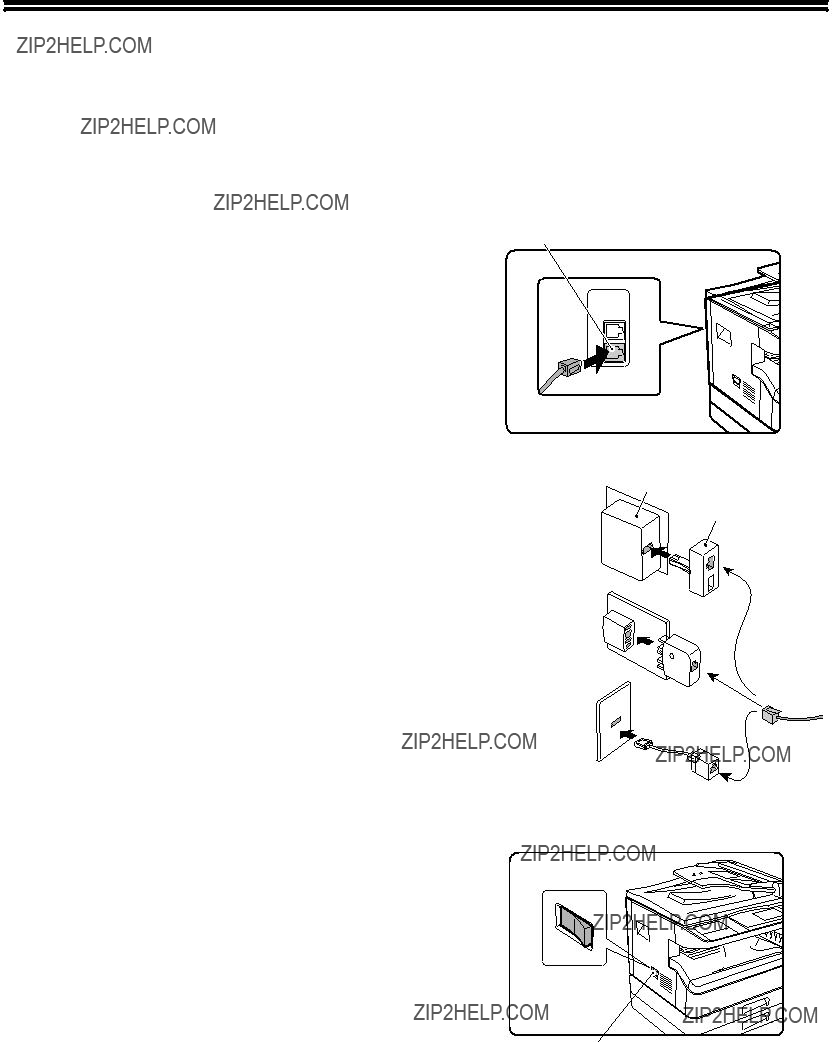






 ).
).



 )
) )
)

 ". If you enter an incorrect digit, press the [C] key and
". If you enter an incorrect digit, press the [C] key and  ).
).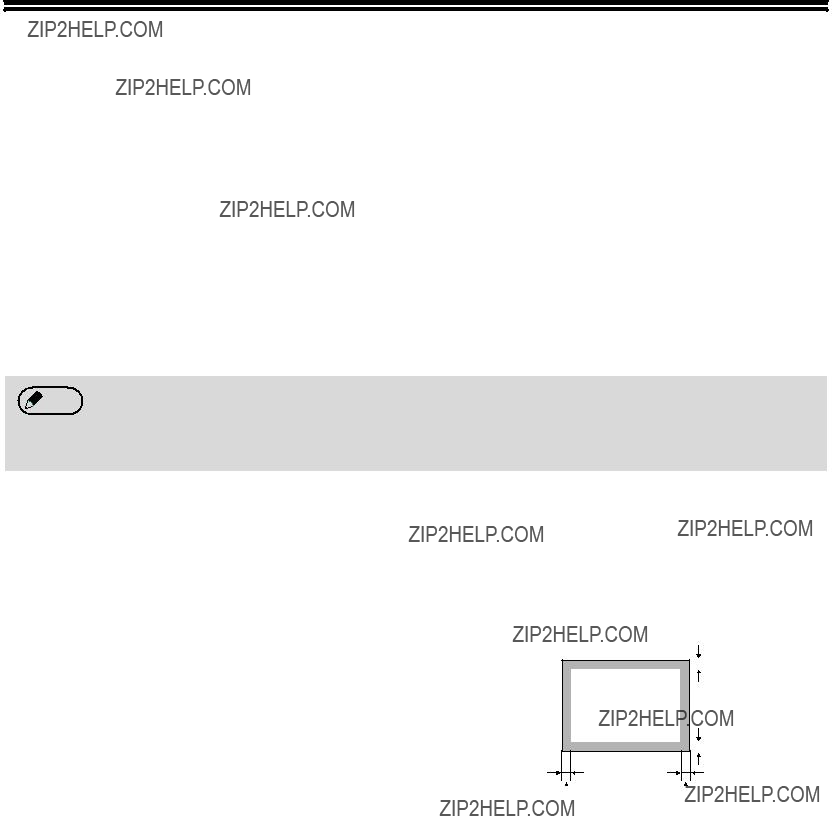
 5 mm
5 mm 5 mm
5 mm Total of 6 mm or
Total of 6 mm or  less
less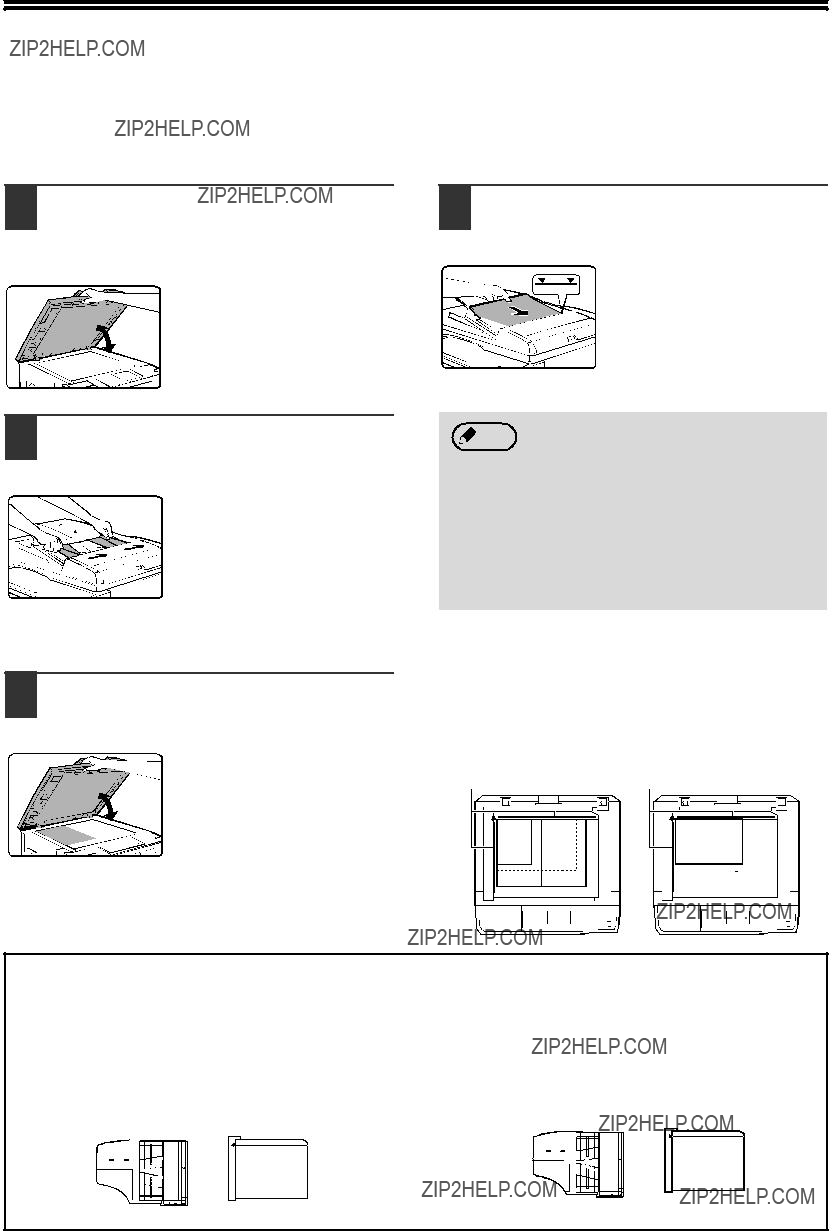
 mark.) Place the original in the appropriate position for its size as shown below.
mark.) Place the original in the appropriate position for its size as shown below.
 size will appear in the original
size will appear in the original ] or [
] or [ ] key.
] key. ] key and go to step 4.
] key and go to step 4. ] or [
] or [  ] key.
] key. ] key and return to step 2.
] key and return to step 2. ] key is pressed, the original size selection screen for INCH sizes appears.
] key is pressed, the original size selection screen for INCH sizes appears.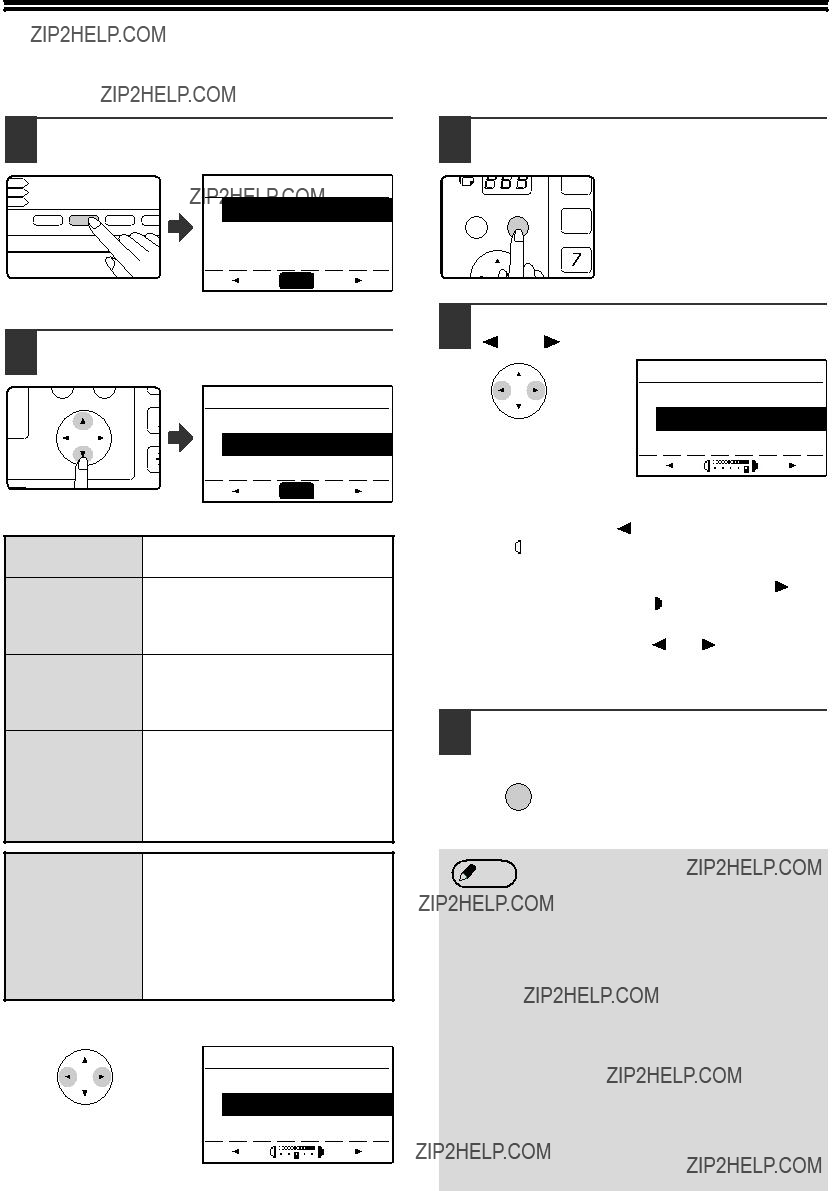
 You will return to the base
You will return to the base  resolution will appear in the
resolution will appear in the  ] or [
] or [ ] key.
] key. ] or [
] or [ ] key and go to step 4.
] key and go to step 4. ] or [
] or [ ] key is pressed, the exposure display changes from "AUTO" to a
] key is pressed, the exposure display changes from "AUTO" to a 



 ).
). ).
). ).
). ) is not pressed), scanning automatically ends and the transmission job is stored. (This function can be disabled in the system settings.)
) is not pressed), scanning automatically ends and the transmission job is stored. (This function can be disabled in the system settings.) ).
).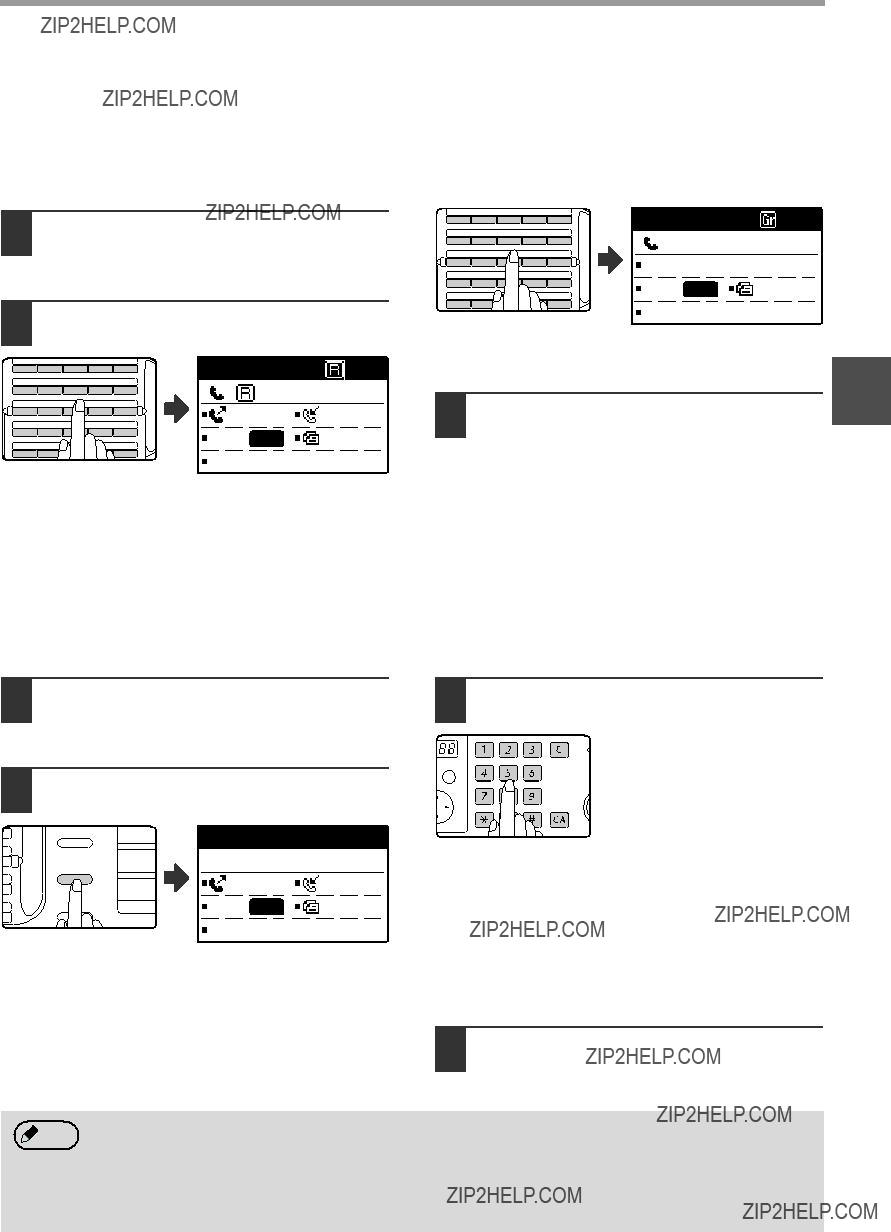
 key is pressed, press the [C] or [CA] key. To cancel a transmission job that is already stored, press the [FAX STATUS] key and cancel the job as explained on (page
key is pressed, press the [C] or [CA] key. To cancel a transmission job that is already stored, press the [FAX STATUS] key and cancel the job as explained on (page 
 ] or [
] or [ ] key.
] key. key to display the full name. Press the
key to display the full name. Press the  key once again to return to the original screen.
key once again to return to the original screen.
 ] or [
] or [ ] key.
] key. ] or [
] or [ ] key.
] key.
 ] or [
] or [  ] key, and press the [OK] key.
] key, and press the [OK] key. ] or [
] or [ ] key.
] key. ] or [
] or [ ] key.
] key.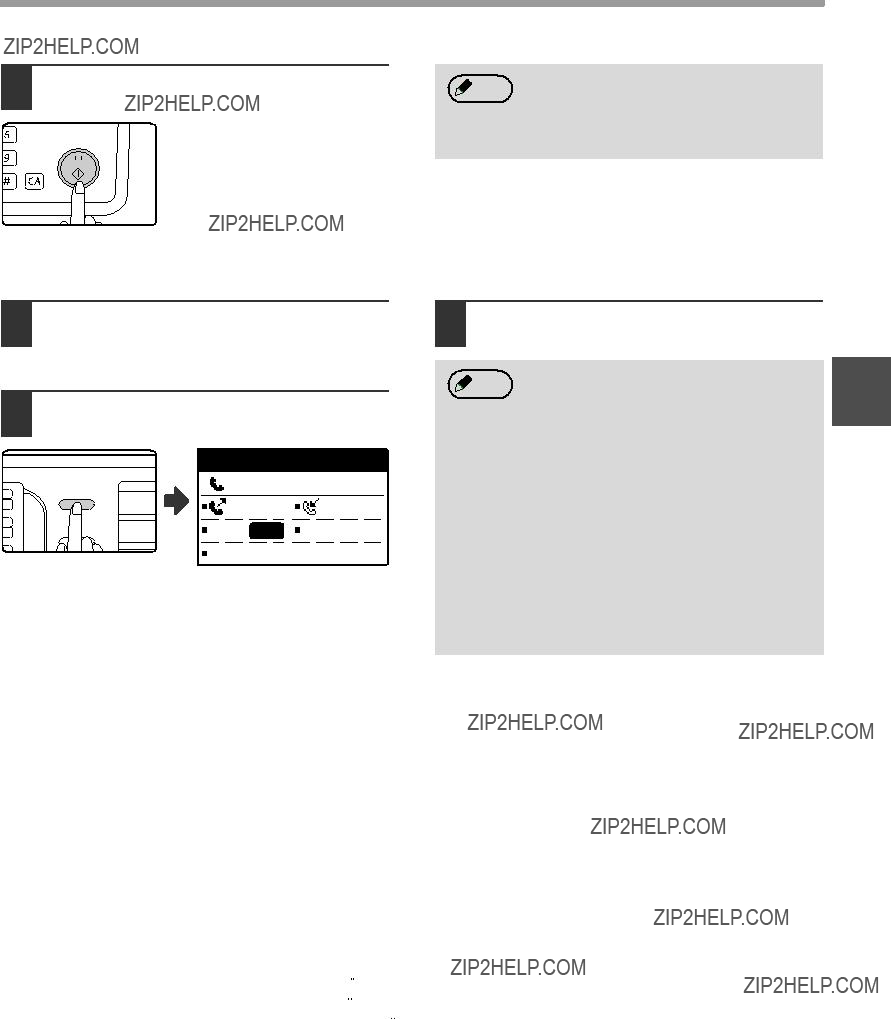
 ] or [
] or [  ] key. Note that this will not change the volume setting in the system settings. Ringing will be heard from the speaker on the left side of the machine (toward the back) when the [SPEAKER] key is used for dialling.
] key. Note that this will not change the volume setting in the system settings. Ringing will be heard from the speaker on the left side of the machine (toward the back) when the [SPEAKER] key is used for dialling. ), you can cancel a transmission job by pressing the [C] key.
), you can cancel a transmission job by pressing the [C] key. ), see
), see  ) is pressed, you can press the [C] key to cancel the transmission.
) is pressed, you can press the [C] key to cancel the transmission.
 ) document 90
) document 90 ) before transmission (A4
) before transmission (A4  ). If oriented horizontally, (
). If oriented horizontally, ( A5R orientation), press
A5R orientation), press 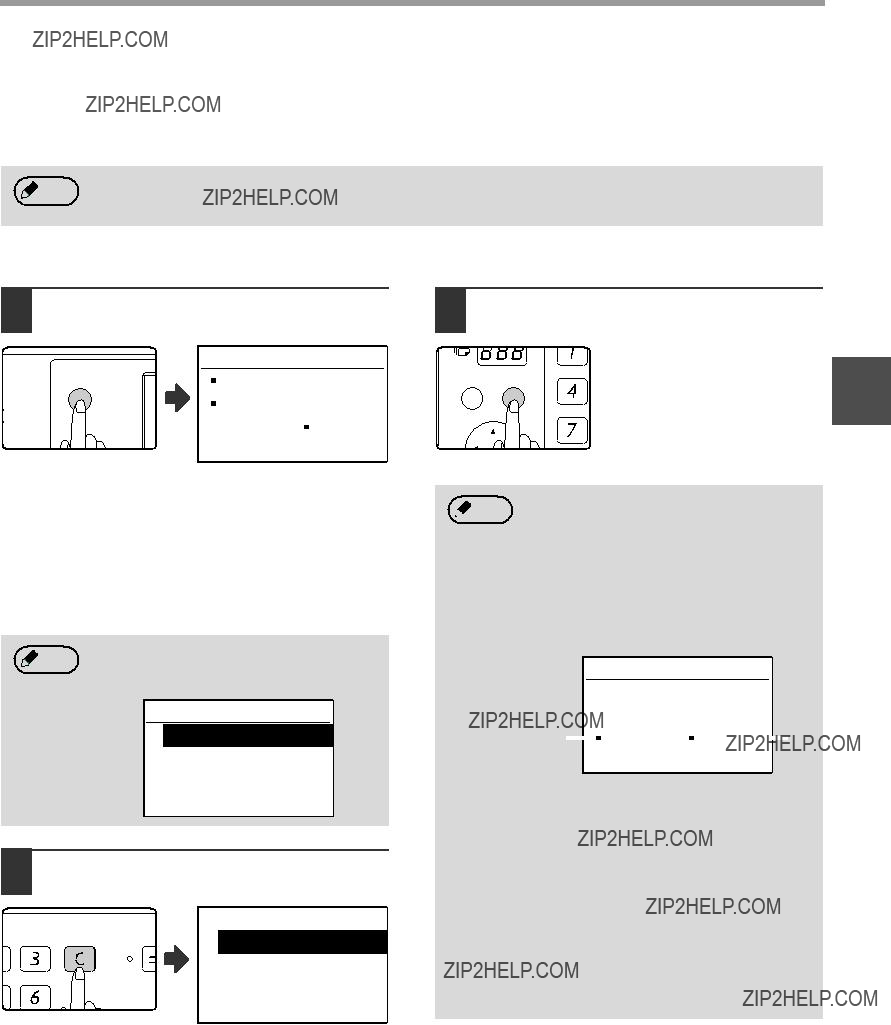
 key is pressed
key is pressed  ) when scanning the original from the document glass), the
) when scanning the original from the document glass), the Note
Note ] key in the screen of step 2, select "NO", and press the [OK] key.
] key in the screen of step 2, select "NO", and press the [OK] key.
 0123456789
0123456789
 MEMORY TX
MEMORY TX " appears at the beginning of the transmission method name.
" appears at the beginning of the transmission method name.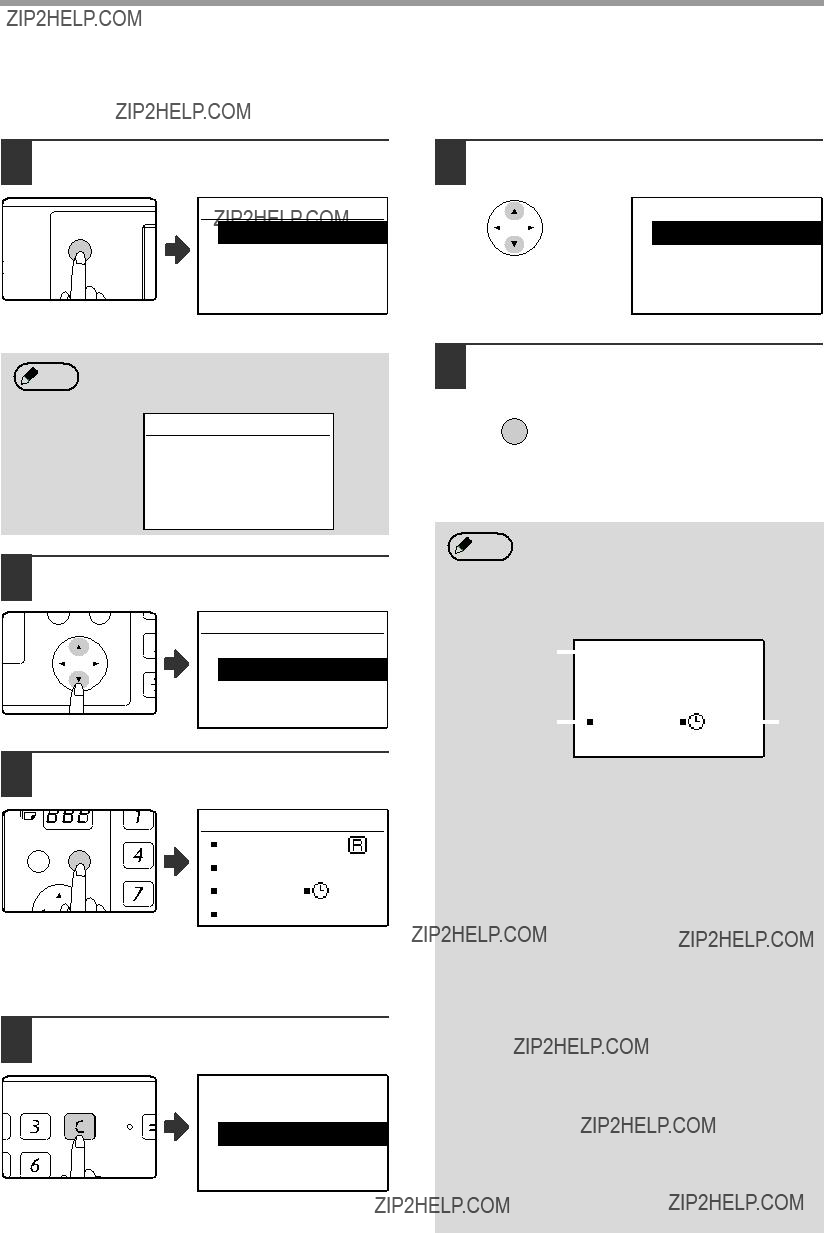
 0123456789
0123456789 SERIAL POLL MODE
SERIAL POLL MODE /XXX
/XXX ] or [
] or [ ] key.
] key. ] or [
] or [  ] key until the transmission job that you wish to cancel appears.
] key until the transmission job that you wish to cancel appears. ] or [
] or [ ] key.
] key.
 01234
01234
 TX
TX
 XX:XX
XX:XX " appears at the beginning of the transmission method name.
" appears at the beginning of the transmission method name.
 ) and vertically (
) and vertically ( ) oriented paper. However, when a fax smaller than A4
) oriented paper. However, when a fax smaller than A4 
 ) will appear in the base screen of fax mode (message display (1) on page 9). The icon also appears in front of the box in the
) will appear in the base screen of fax mode (message display (1) on page 9). The icon also appears in front of the box in the 
 ] or [
] or [ ] key.
] key. ] or [
] or [ ] key.
] key.
 ] or [
] or [ ] key.
] key. ] or [
] or [ ] key.
] key. ] or [
] or [ ] key.
] key.

 :
:
 After entering a full number with
After entering a full number with  [OK] key to complete the entry.
[OK] key to complete the entry.  in step 3, it is not necessary to
in step 3, it is not necessary to

 ] or [
] or [ ] key to scroll through and check the destinations.
] key to scroll through and check the destinations.
 ] or [
] or [ ] key.
] key. ] key in the above display with "TIMER MODE" highlighted.
] key in the above display with "TIMER MODE" highlighted. ] or [
] or [ ] key.
] key.


 ] or [
] or [ ] key.
] key. ] or [
] or [ ] key.
] key.
 ] or [
] or [  ] key.
] key.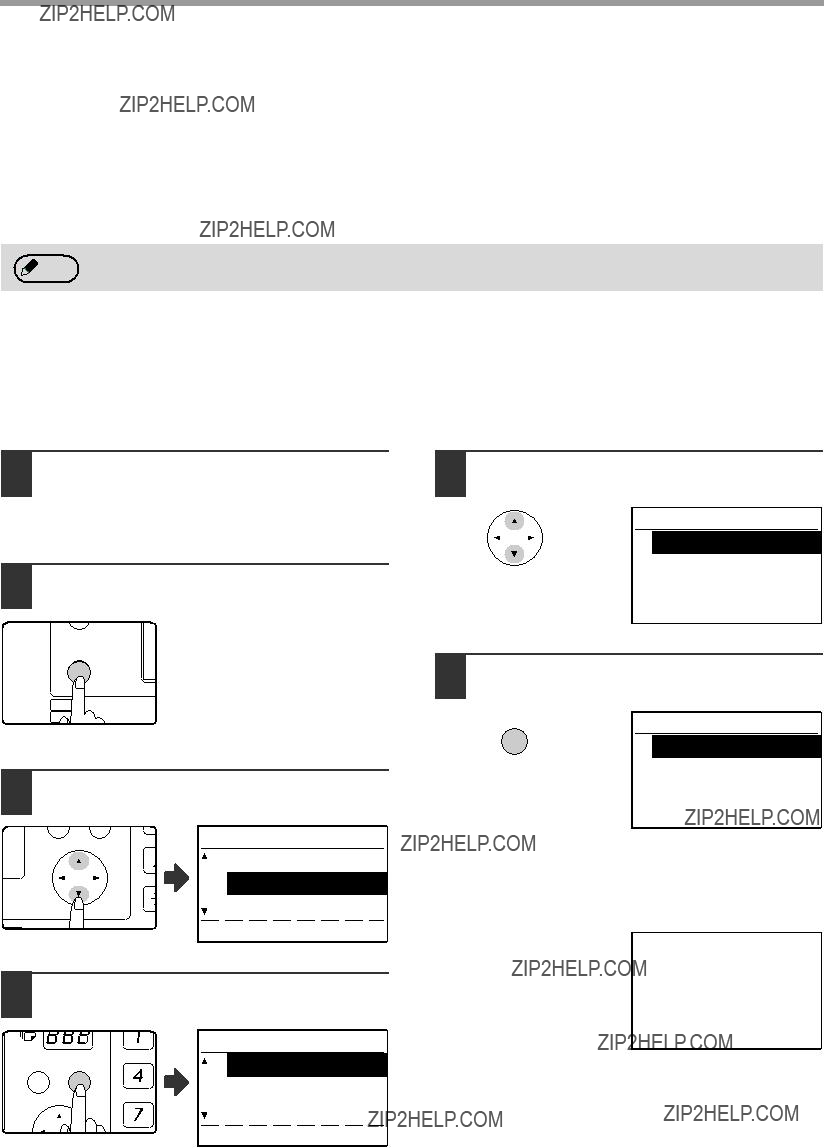
 ] or [
] or [ ] key.
] key. ] or [
] or [ ] key.
] key. ] or [
] or [  ] key, press the [OK] key, and then go to step 7.
] key, press the [OK] key, and then go to step 7. ] or [
] or [  ] key, press the [OK] key, and then go to step 7.
] key, press the [OK] key, and then go to step 7.
 ] or [
] or [  ] key.
] key. ).
). ] or [
] or [ ] key.
] key.
 ] or [
] or [  ] key.
] key. ] or [
] or [ ] key.
] key.

 ] or [
] or [  ] key.
] key. ) and scanning the first original, change originals and press the [START] key (
) and scanning the first original, change originals and press the [START] key (  ). Repeat until all originals have been scanned. Press the
). Repeat until all originals have been scanned. Press the  key. (See steps 6 to 8 of
key. (See steps 6 to 8 of 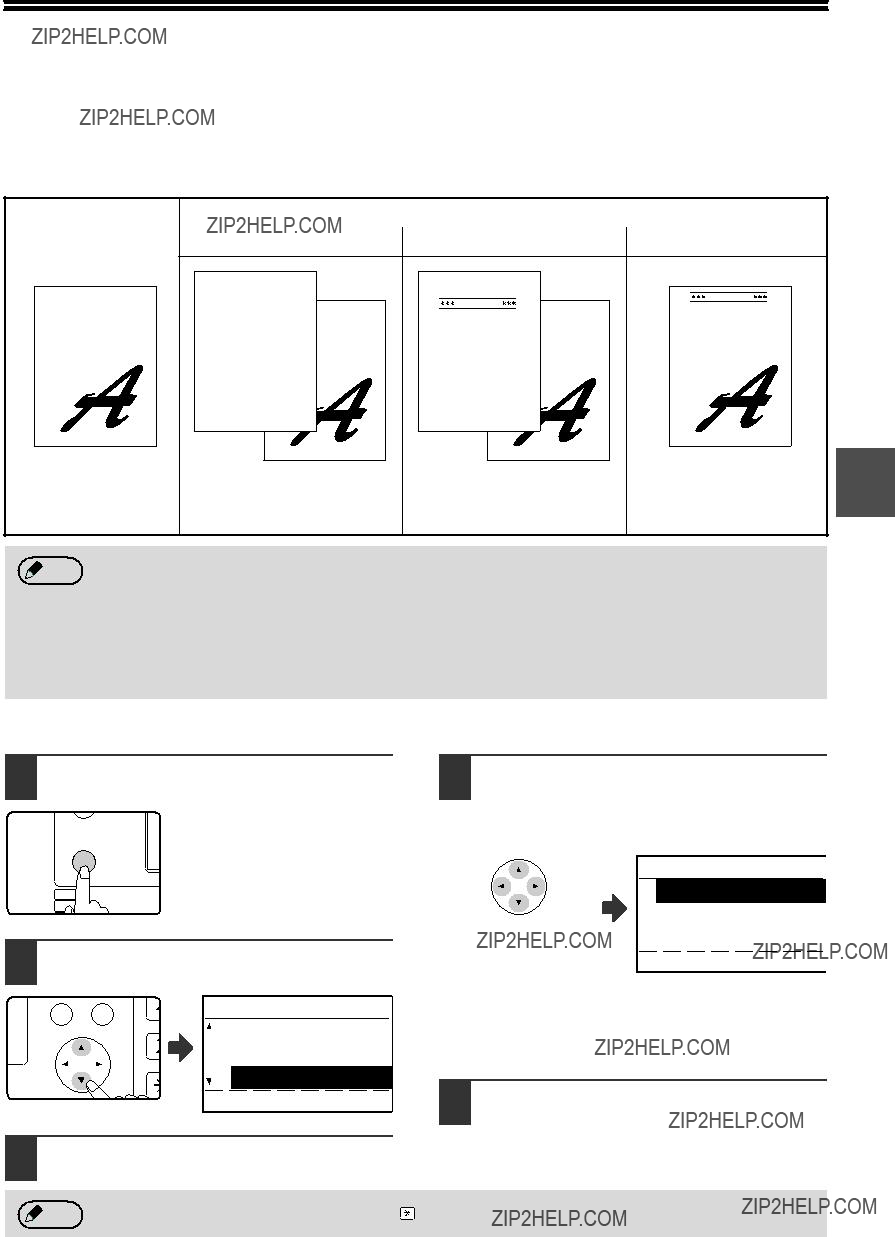
 ] or [
] or [ ] key.
] key. ] or [
] or [ ] key. To add a message, select the desired message with the [
] key. To add a message, select the desired message with the [ ] or [
] or [ ] key.
] key. COVER SHEET
COVER SHEET 

 ).
). ) in step 5. These settings include the
) in step 5. These settings include the ] or [
] or [ ] key.
] key. key to display all letters. Press the
key to display all letters. Press the  key once
key once

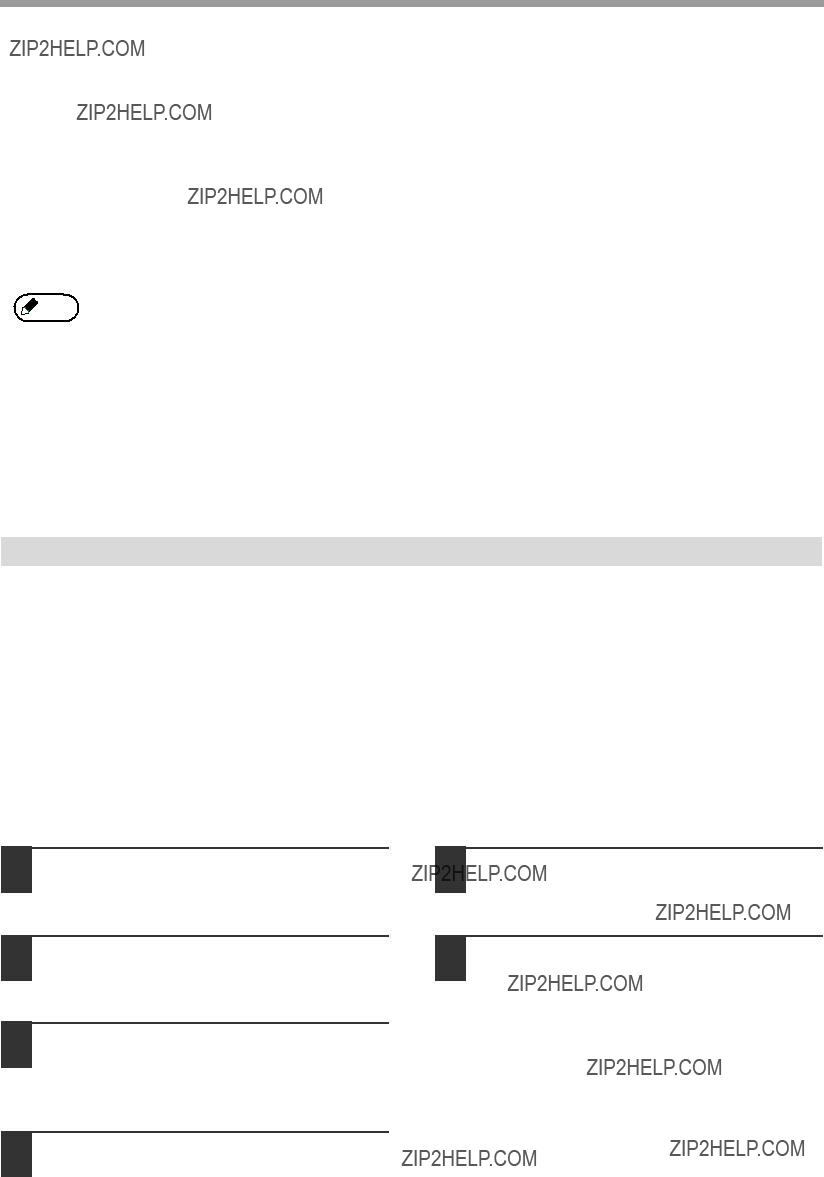

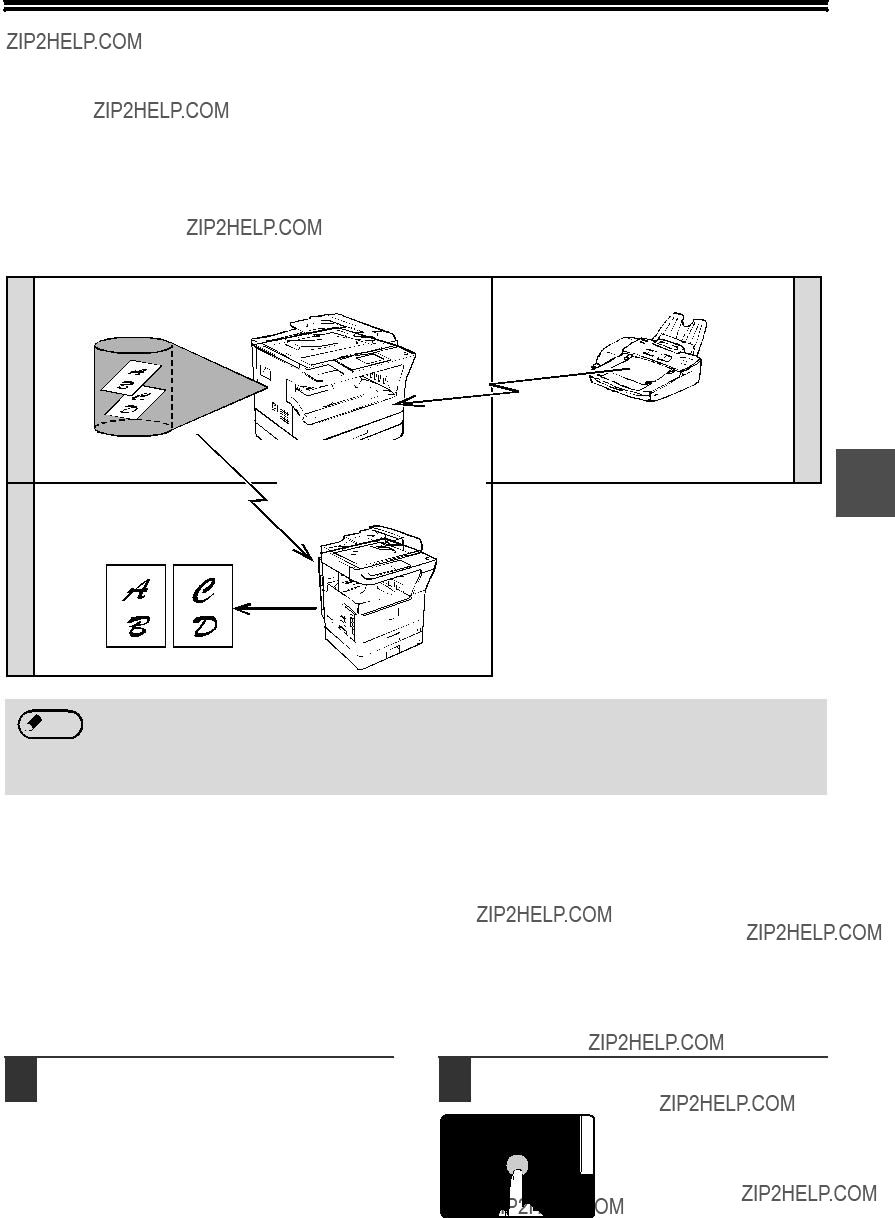
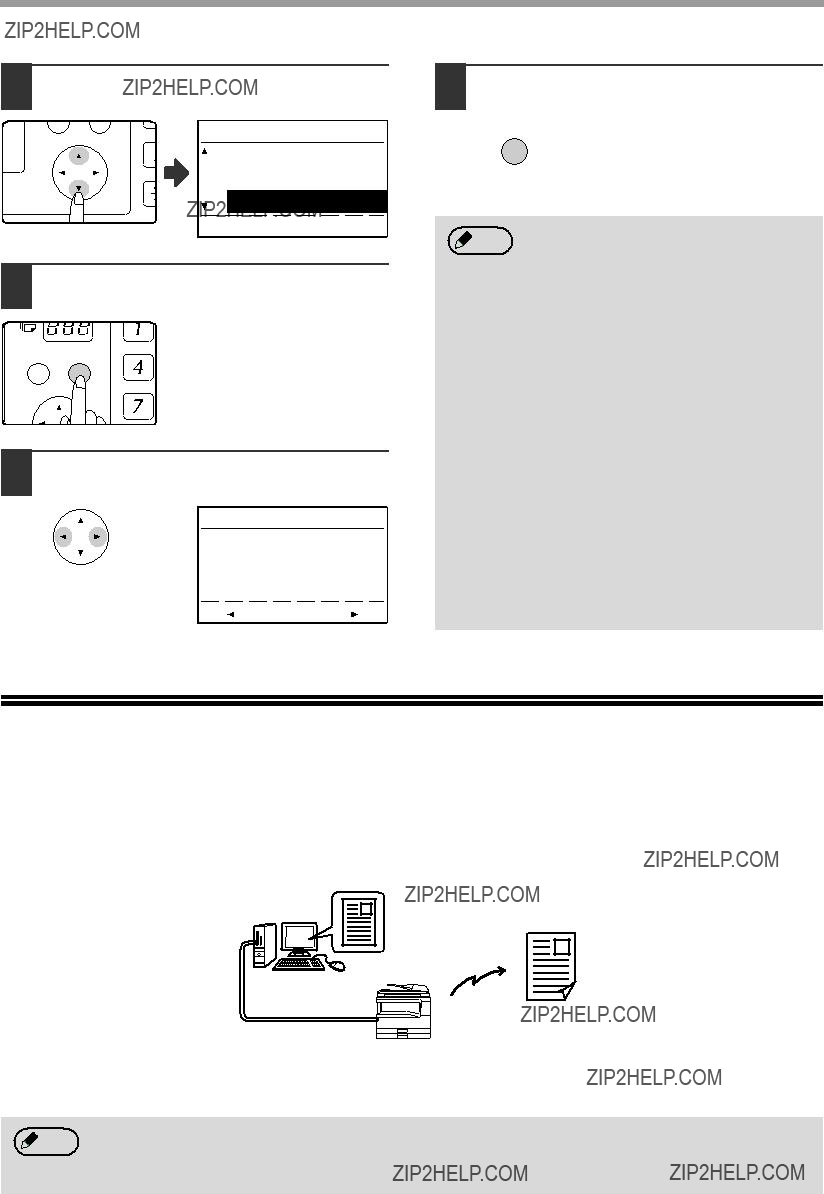
 ] or [
] or [  ] key.
] key. ] or [
] or [ ] key.
] key. :12345678901234 12345678901234 123456789012
:12345678901234 12345678901234 123456789012
 ).
). ).
).





 1115
1115



 ] or [
] or [ ] key.
] key. ] or [
] or [ ] key.
] key.
 Document Plan
Document Plan key to display all letters. Press the
key to display all letters. Press the  key again to return to the previous display.
key again to return to the previous display.
 ] or [
] or [  ] key.
] key. ] or [
] or [ ] key.
] key. ] or [
] or [ ] key.
] key.
 Document Plan
Document Plan key to display all letters. Press the
key to display all letters. Press the  key again to return to the previous display.
key again to return to the previous display. ] or [
] or [ ] key.
] key.
 ] or [
] or [ ] key.
] key. ] or [
] or [ ] key.
] key.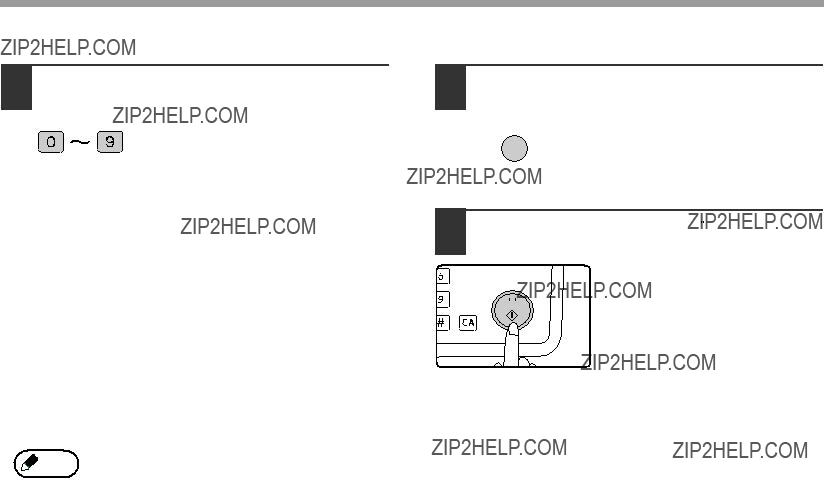
 ).
).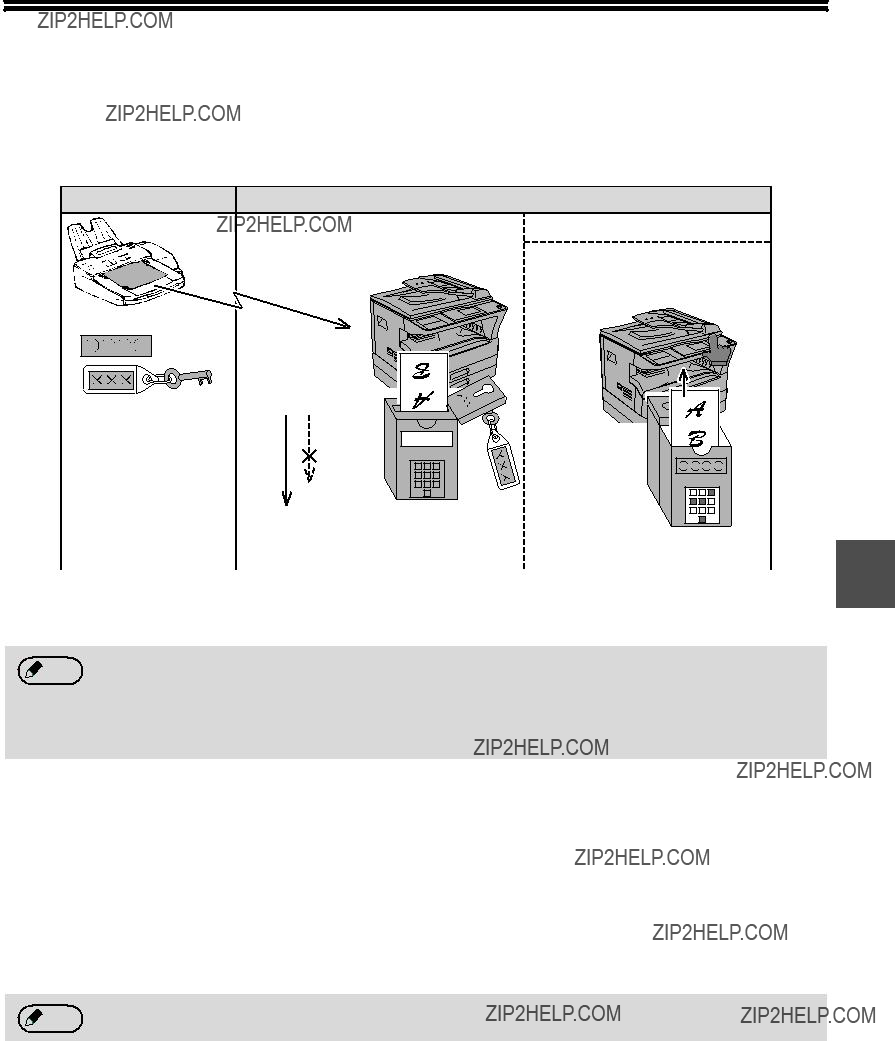

 ] or [
] or [  ] key.
] key. ).
). ). Repeat until all pages have been scanned and then press the
). Repeat until all pages have been scanned and then press the  key.
key.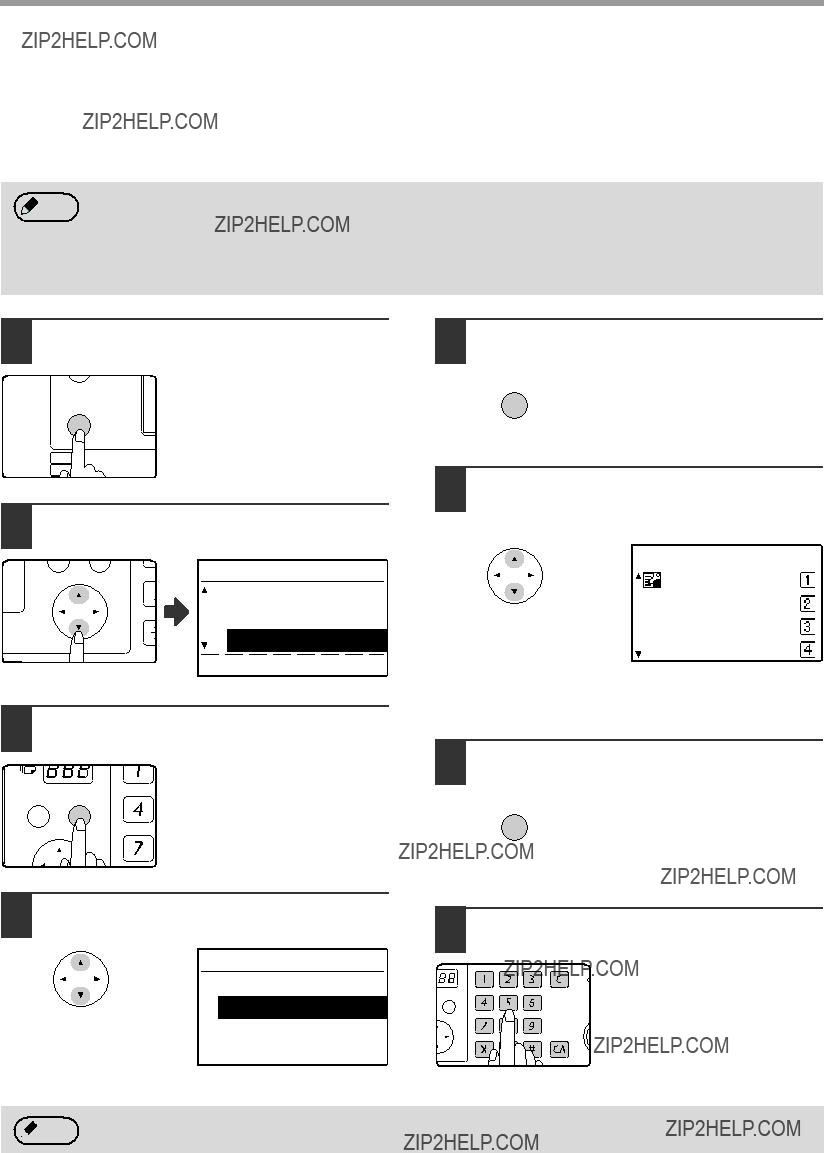
 ] or [
] or [ ] key.
] key. ] or [
] or [ ] key.
] key. ] or [
] or [ ] key.
] key. ) appears next to each box that is holding a received fax.
) appears next to each box that is holding a received fax.



 ).
).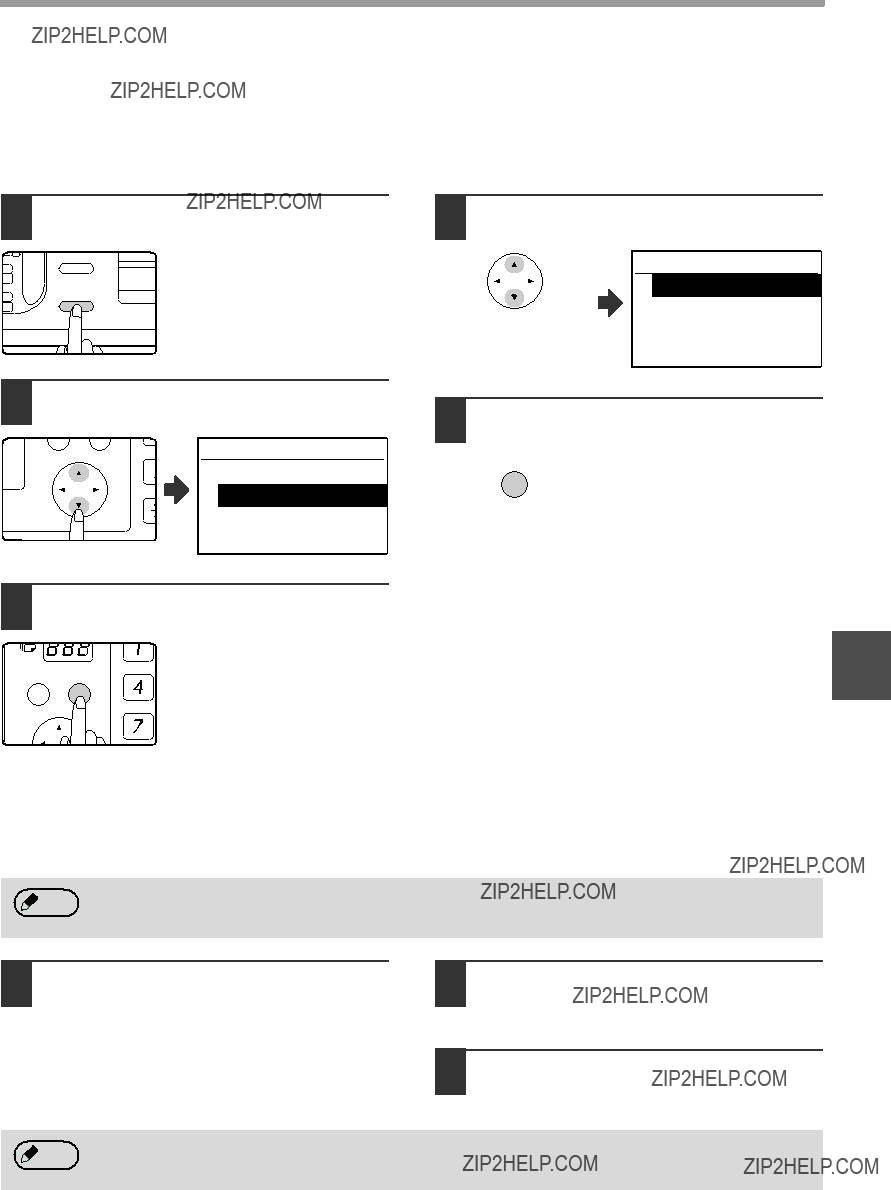
 ] or [
] or [  ] key.
] key. ] or [
] or [ ] key.
] key. key once and the
key once and the  key twice on the extension phone.
key twice on the extension phone.
 ] or [
] or [ ] key.
] key.
 ] or [
] or [  ] key.
] key. ] or
] or ] key.
] key.
 ). If you wish to program an option such as an
). If you wish to program an option such as an  ), you will return to step 7. If you wish to store another Rapid key or Speed Dial number, repeat steps 7 to 13. If you have finished storing
), you will return to step 7. If you wish to store another Rapid key or Speed Dial number, repeat steps 7 to 13. If you have finished storing  ] or [
] or [ ] key.
] key.
 ", "#", and spaces. If you make a mistake, press [C] key and then
", "#", and spaces. If you make a mistake, press [C] key and then  ", "#", and spaces cannot be entered.
", "#", and spaces cannot be entered. :
:
 ", "#", and spaces. If you make a mistake, press [C] key and then
", "#", and spaces. If you make a mistake, press [C] key and then  key to remove the checkmark.
key to remove the checkmark. ] or [
] or [  ] key.
] key. ).
). ] or [
] or [ ] key.
] key. key, the checkmark will be removed and chain dialling cancelled.
key, the checkmark will be removed and chain dialling cancelled.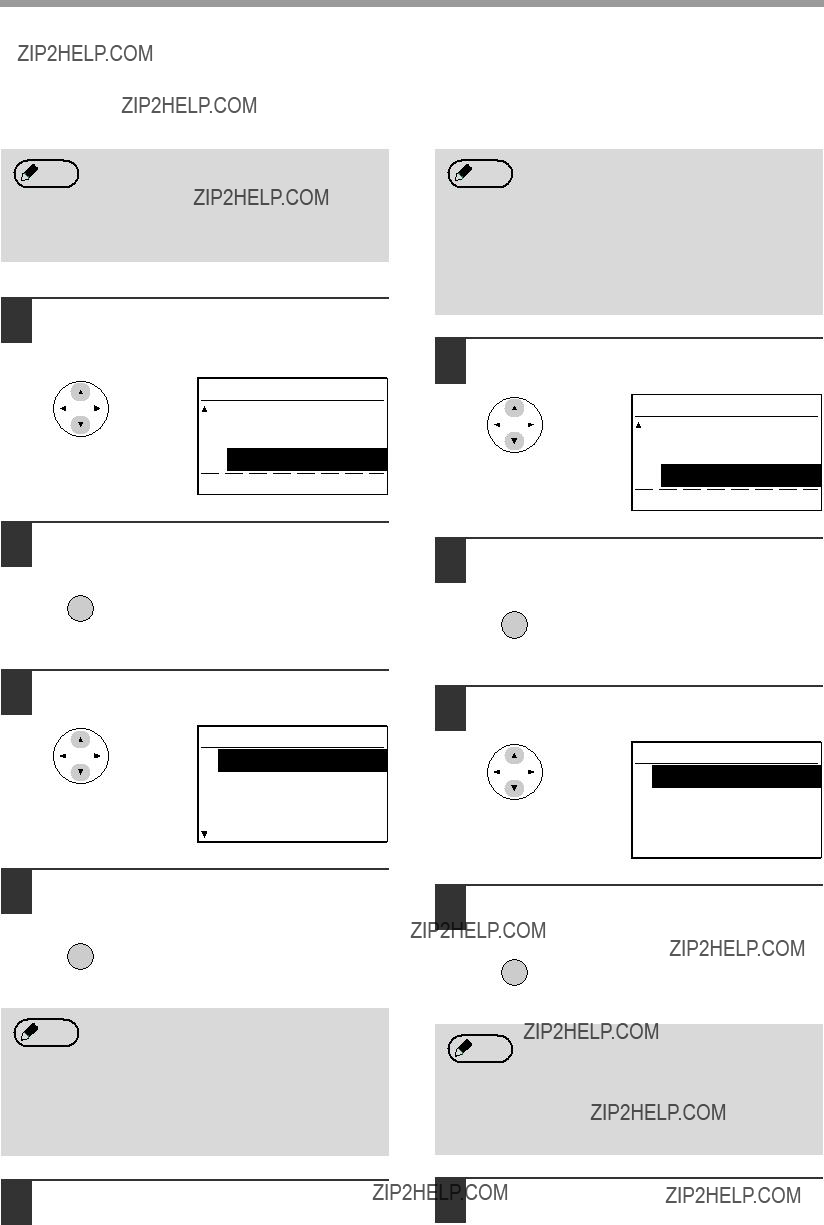
 ] or [
] or [ ] key.
] key. TX SPEED
TX SPEED  ] or [
] or [ ] key.
] key. key.
key. ] or [
] or [ ] key.
] key. INTERNATIONAL TX
INTERNATIONAL TX  ] or [
] or [ ] key.
] key. key.
key.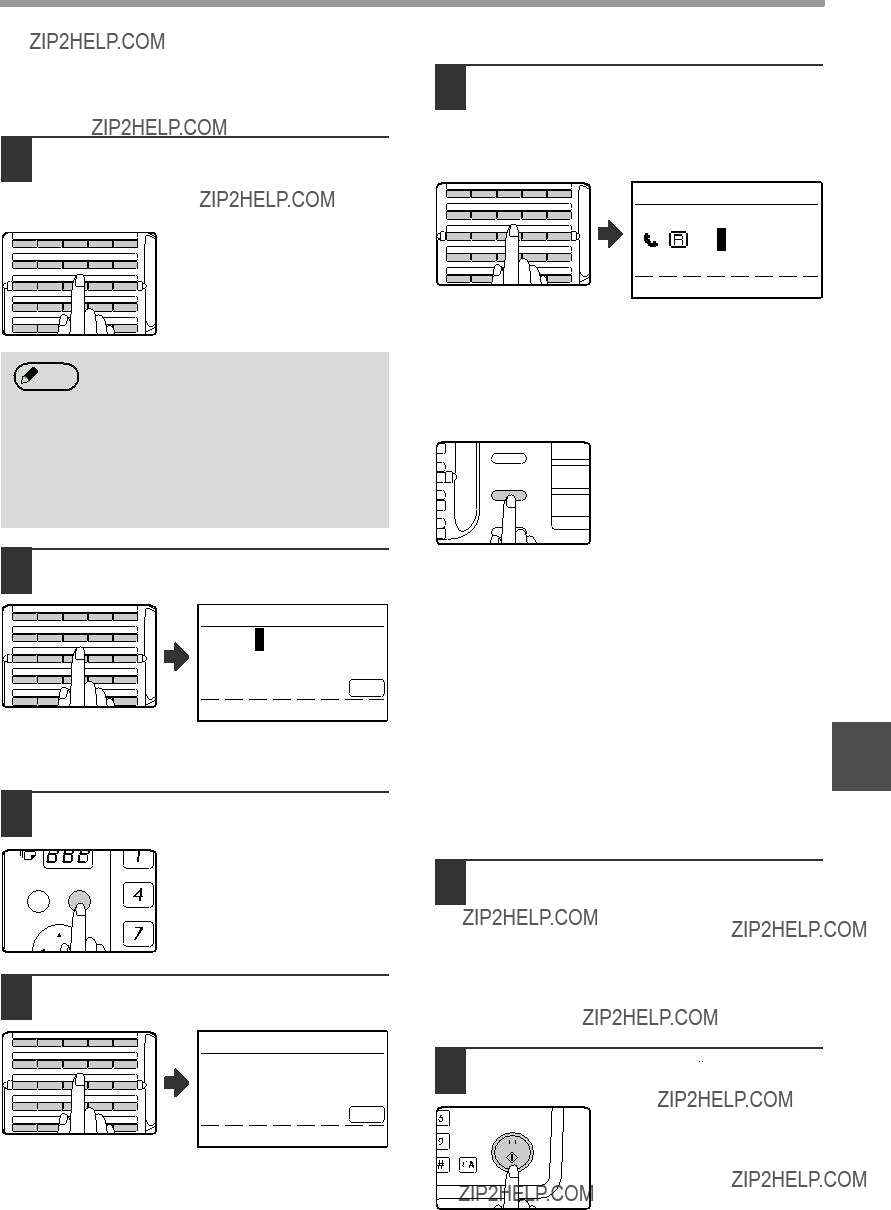
 ).
).
 ] or [
] or [ ] key.
] key. ] or [
] or [ ] key.
] key. ] or [
] or [ ] key, and then enter the correct digit(s) with the numeric keys. To delete a digit, move the cursor to the digit that you wish to delete with the [
] key, and then enter the correct digit(s) with the numeric keys. To delete a digit, move the cursor to the digit that you wish to delete with the [ ] or [
] or [ ] key and then press the [C] key.
] key and then press the [C] key.
 ). If you wish to program an option such as
). If you wish to program an option such as  ), go to step 5. If you wish to program another Rapid key or Speed Dial number, repeat steps 5 to 11. To exit, press the [BACK] key. Editing to that point will be completed.
), go to step 5. If you wish to program another Rapid key or Speed Dial number, repeat steps 5 to 11. To exit, press the [BACK] key. Editing to that point will be completed. ] or [
] or [  ] key.
] key. ] or [
] or [ ] key.
] key. ] or [
] or [ ] key.
] key.
 ] or [
] or [  ] key.
] key. ] or [
] or [ ] key and press the [C] key.
] key and press the [C] key. :
:
 ] or [
] or [ ] key and press the [C] key. The entire number including the selected digit will be deleted. To add a number, select the place where you wish to add the number with the [
] key and press the [C] key. The entire number including the selected digit will be deleted. To add a number, select the place where you wish to add the number with the [ ] or [
] or [ ] key, and then enter the number. When you have finished adding or deleting the number, press the [OK] key.
] key, and then enter the number. When you have finished adding or deleting the number, press the [OK] key. :
: 50,
50, ).
).
 ] or [
] or [  ] key.
] key. ] or [
] or [ ] key.
] key. key to check the destination name. If
key to check the destination name. If
 ] or [
] or [  ] key.
] key. ] or [
] or [ ] key.
] key. ] or [
] or [ ] key.
] key. ] or [
] or [ ] key.
] key.
 ] or [
] or [  ] key.
] key. ]:CANCEL [START]:ENTER
]:CANCEL [START]:ENTER key.
key. ). You will return to step 8. If you wish to store another program, repeat steps 8 to 11. To exit, press the [BACK] key in step 8.
). You will return to step 8. If you wish to store another program, repeat steps 8 to 11. To exit, press the [BACK] key in step 8. ] or [
] or [  ] key.
] key. ) and then press the [BACK] key to exit.
) and then press the [BACK] key to exit. ] or [
] or [  ] key.
] key. ] or [
] or [ ] key.
] key. key to display all letters. Press the
key to display all letters. Press the  key once
key once ] or [
] or [  ] key.
] key.
 ] or [
] or [ ] key.
] key. ] or [
] or [ ] key.
] key. ] or [
] or [ ] key.
] key.
 ] or [
] or [  ] key.
] key. " and "#" cannot be used. The print passcode cannot be omitted. Take care not to forget the programmed print passcode. If you forget the passcode, consult your Sharp dealer.
" and "#" cannot be used. The print passcode cannot be omitted. Take care not to forget the programmed print passcode. If you forget the passcode, consult your Sharp dealer.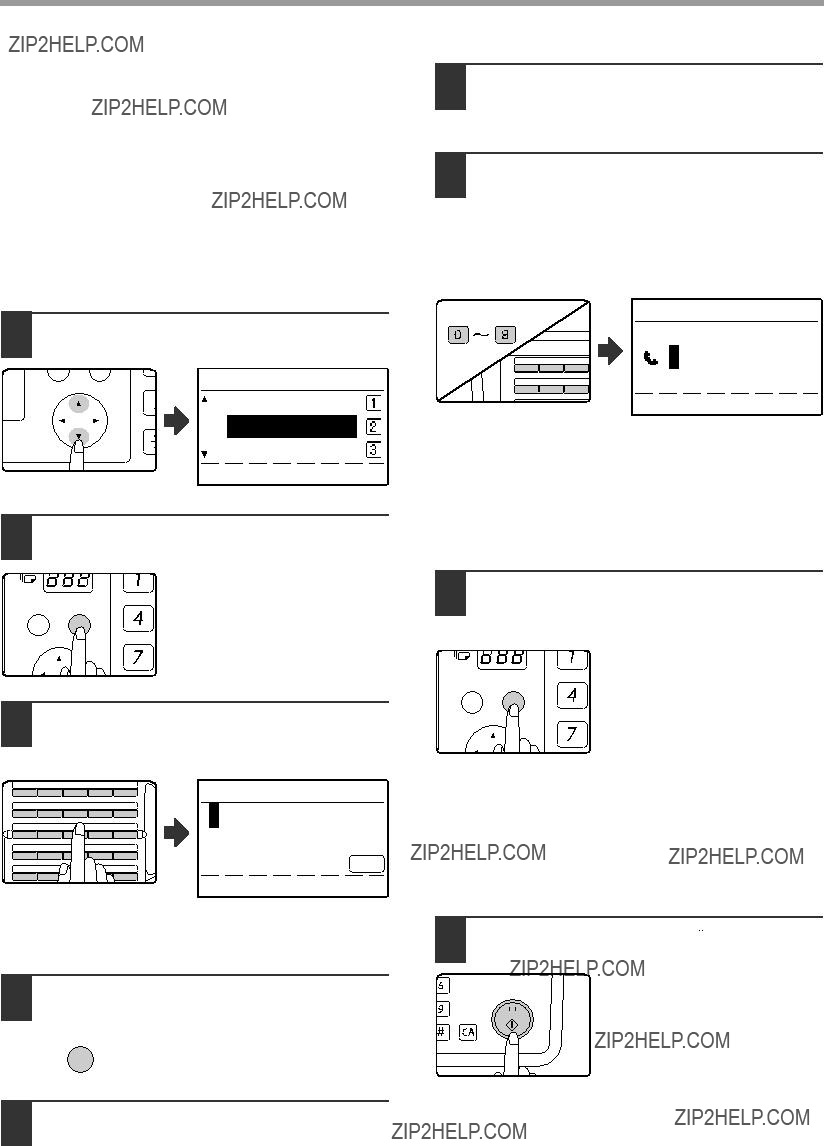
 ] or [
] or [  ] key.
] key. ) to end the procedure.
) to end the procedure.
 ] or [
] or [  ] key.
] key. ] or [
] or [ ] key.
] key.
 ] or [
] or [  ] key.
] key. key to display all letters. Press the
key to display all letters. Press the  key once again to return to the original screen.
key once again to return to the original screen. ] or [
] or [ ] key.
] key. key to display all letters. Press the
key to display all letters. Press the  key once again to return to the original screen.
key once again to return to the original screen. ] or [
] or [ ] key.
] key.
 ] or [
] or [  ] key.
] key. ] or [
] or [ ] key.
] key. key to display all letters. Press the
key to display all letters. Press the  key once again to return to the original screen.
key once again to return to the original screen. ] or [
] or [ ] key.
] key.
 key once again
key once again  ] or [
] or [  ] key.
] key.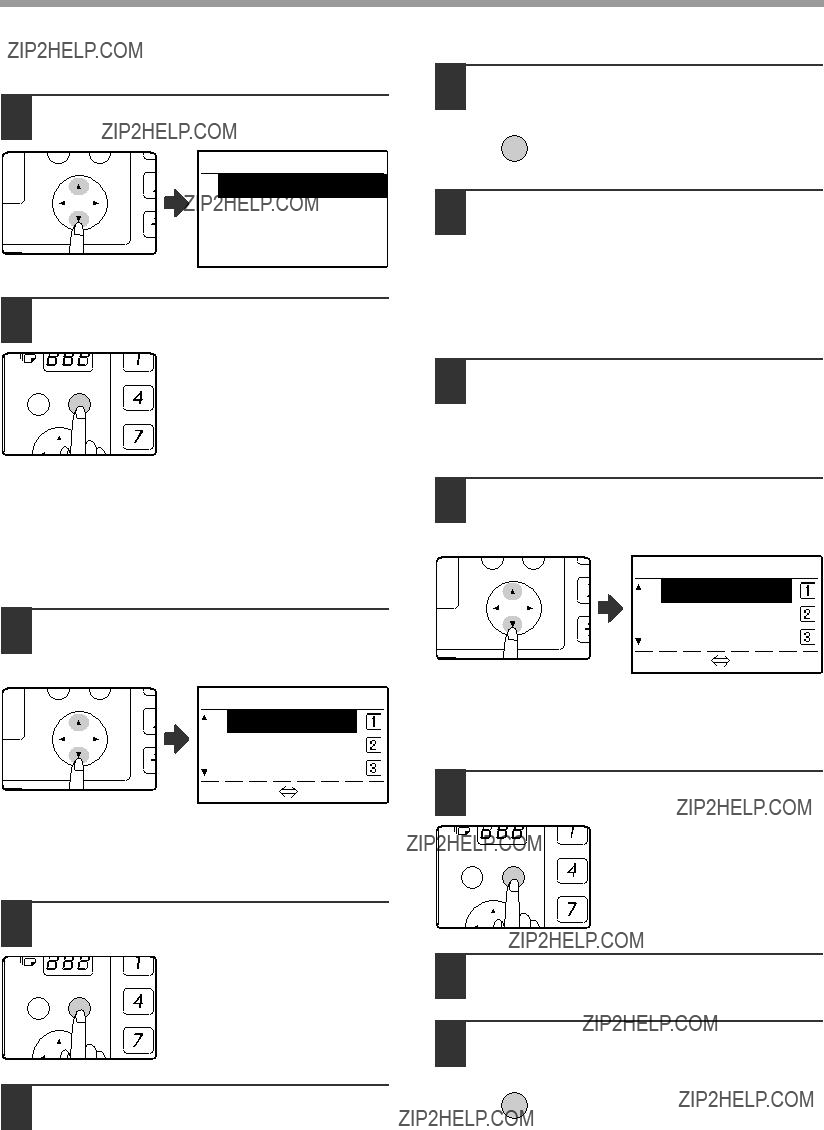
 ] or [
] or [  ] key.
] key. ] or [
] or [ ] key.
] key. key to display all letters. Press the
key to display all letters. Press the  key once again to return to the original screen.
key once again to return to the original screen. ] or [
] or [ ] keys.
] keys. key to display all letters. Press the
key to display all letters. Press the  key once again to return to the original screen.
key once again to return to the original screen. ] or [
] or [  ] key.
] key.
 ] or [
] or [ ] key.
] key. ] or [
] or [ ] key.
] key.



 ][
][ ][
][ ][
][ ] keys.
] keys. ] key. To move back to the previous page, move the cursor to the top line and press the [
] key. To move back to the previous page, move the cursor to the top line and press the [  ] key. You can also change pages by pressing the [
] key. You can also change pages by pressing the [ ] key when the cursor is at the right end of the bottom line, or the [
] key when the cursor is at the right end of the bottom line, or the [ ] key when the cursor is at the left end of the top line.
] key when the cursor is at the left end of the top line.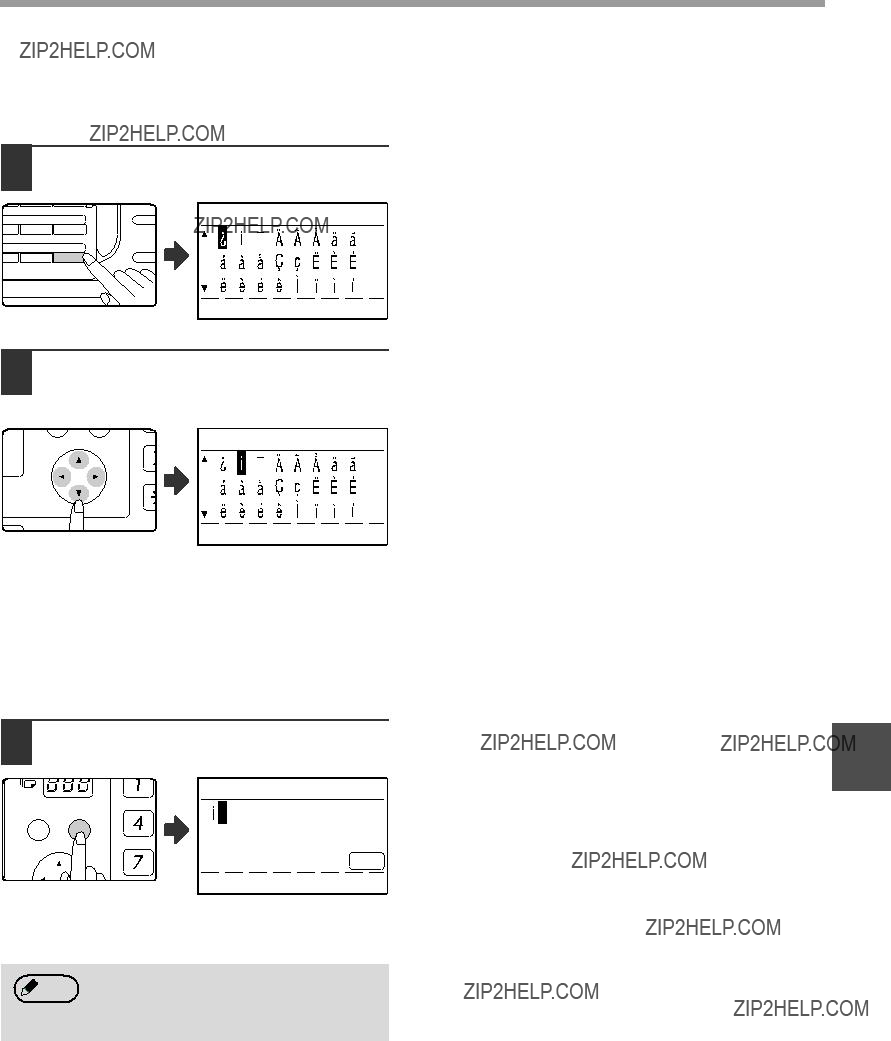
 ][
][ ][
][ ][
][ ] keys.
] keys. ] key. To move back to the previous page, move the cursor to the top line and press the [
] key. To move back to the previous page, move the cursor to the top line and press the [  ] key. You can also change pages by pressing the [
] key. You can also change pages by pressing the [ ] key when the cursor is at the right end of the bottom line, or the [
] key when the cursor is at the right end of the bottom line, or the [ ] key when the cursor is at the left end of the top line.
] key when the cursor is at the left end of the top line.

 below, however, the times at which the report is printed can be changed in the system settings. (See
below, however, the times at which the report is printed can be changed in the system settings. (See 


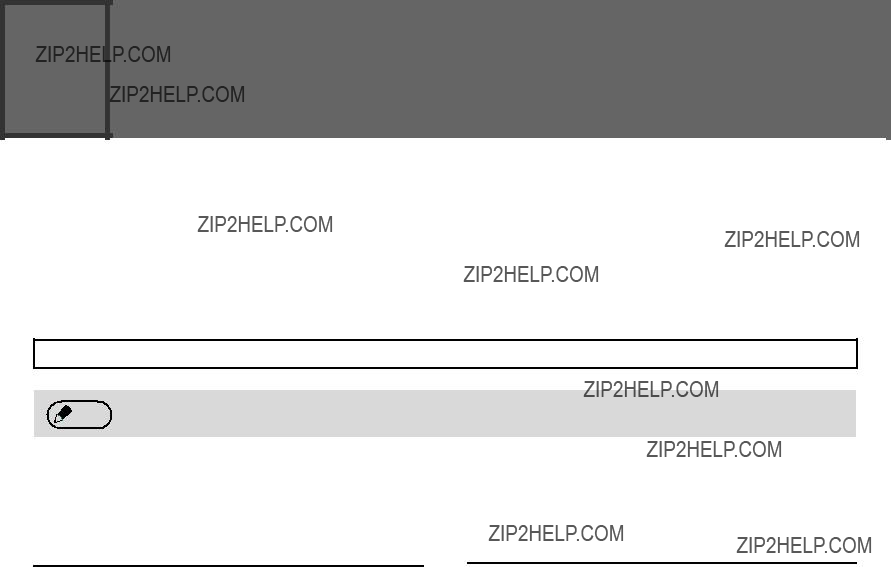

 FAX SETTINGS
FAX SETTINGS
 ] or [
] or [  ] key.
] key. ] or [
] or [ ] key.
] key. ".
".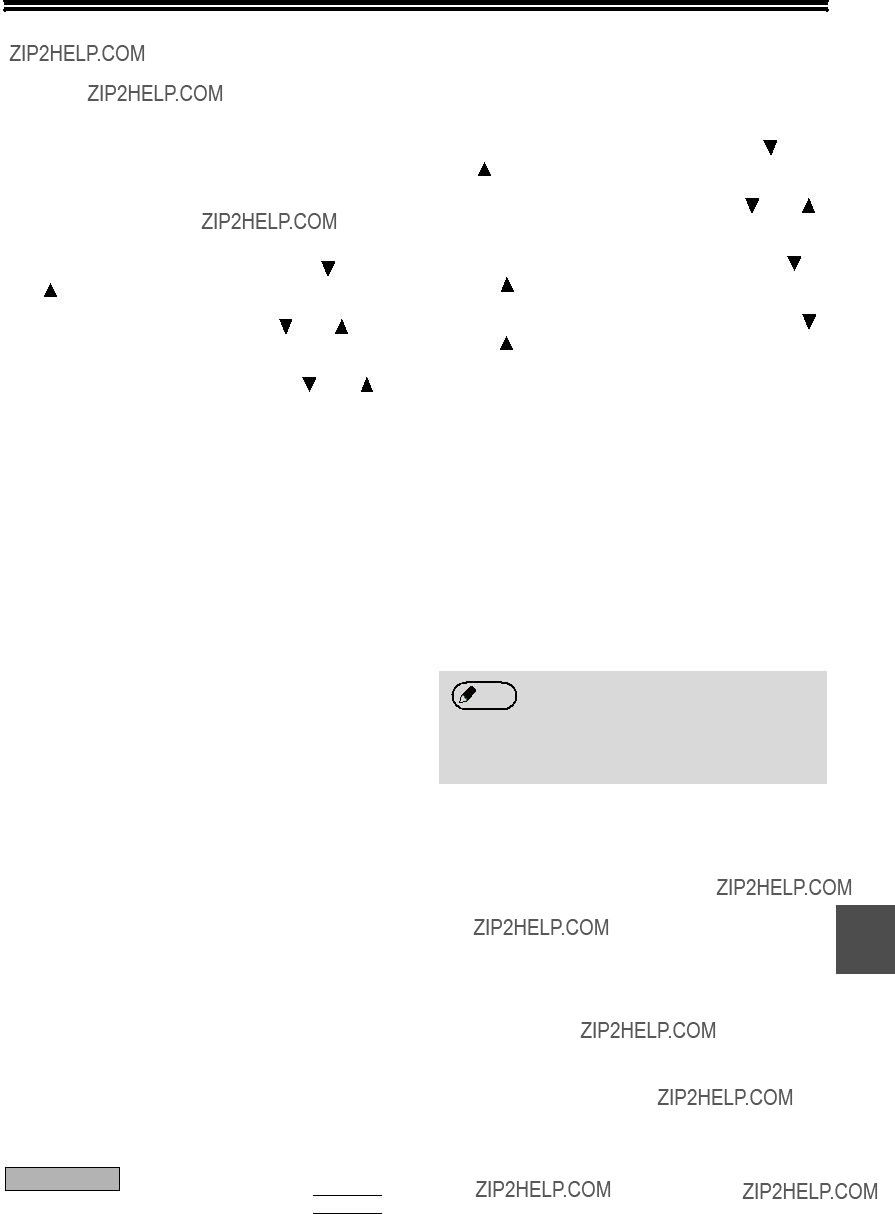
 ] or [
] or [  ] key and then press the [OK] key.
] key and then press the [OK] key.
 above are selected.
above are selected.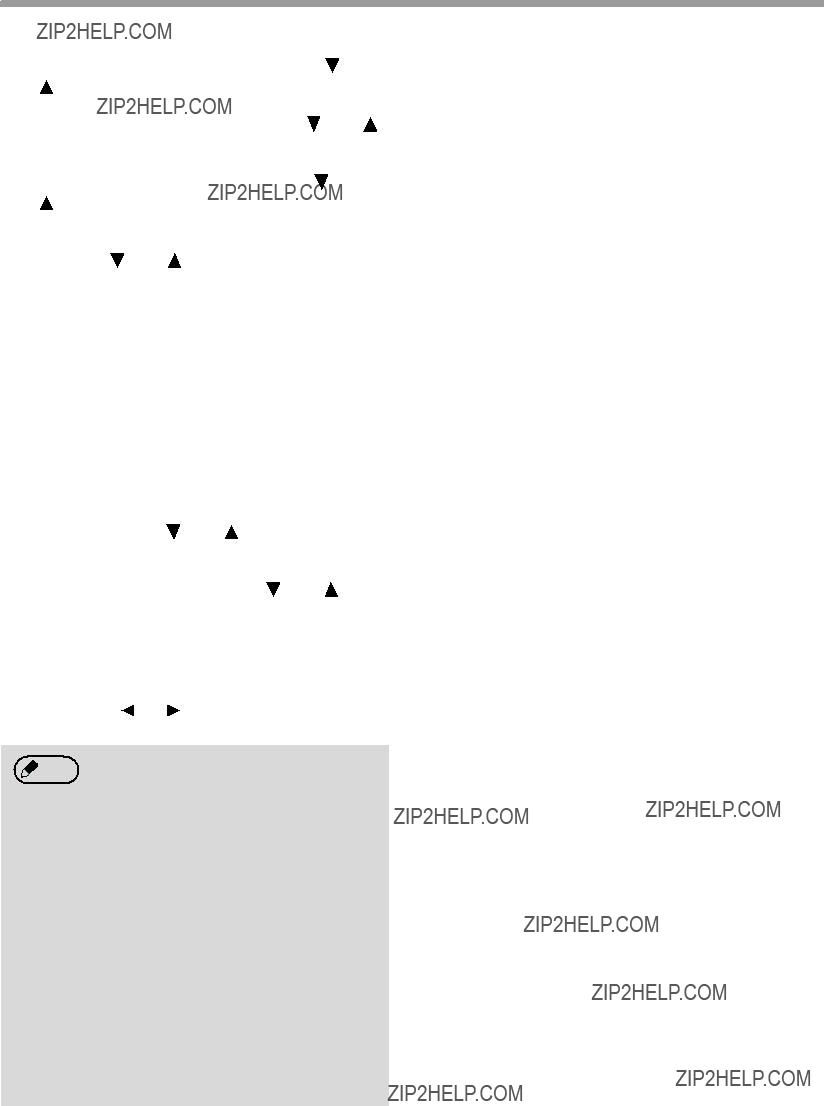
 ] or [
] or [  ] key and then press the [OK] key.
] key and then press the [OK] key. ] or [
] or [  ] key and then press the [OK] key.
] key and then press the [OK] key. ] or [
] or [  ] key and then press the [OK] key.
] key and then press the [OK] key. ] or [
] or [  ] key and then press the [OK] key.
] key and then press the [OK] key. ] or [
] or [  ] key and then press the [OK] key.
] key and then press the [OK] key. ] or [
] or [  ] key and then press the [OK] key.
] key and then press the [OK] key. ] or [
] or [ ] key (the cursor should be over the digit), and then enter the correct digit.
] key (the cursor should be over the digit), and then enter the correct digit.
 key.
key. ).
). ] or [
] or [  ] key and then press the [OK] key.
] key and then press the [OK] key. ] or [
] or [  ] key and then press the [OK] key.
] key and then press the [OK] key. ] or [
] or [  ] key and then press the [OK] key.
] key and then press the [OK] key. ] or [
] or [  ] key and then press the [OK] key.
] key and then press the [OK] key. ] or [
] or [  ] key and then press the [OK] key.
] key and then press the [OK] key. ] or [
] or [  ] key and then press the [OK] key.
] key and then press the [OK] key. ] or [
] or [  ] key and then press the [OK] key.
] key and then press the [OK] key. key to listen to the selected pattern.
key to listen to the selected pattern.

 ] or [
] or [  ] key and then press the [OK] key.
] key and then press the [OK] key. ] or [
] or [  ] key and then press the [OK] key.
] key and then press the [OK] key.
 ,
,  ] keys to enter the appropriate digit in each box. Be sure to enter the number from the box on the left. Any digit from 0 to 9 can be entered in the left box, and digits 0 to 9 and
] keys to enter the appropriate digit in each box. Be sure to enter the number from the box on the left. Any digit from 0 to 9 can be entered in the left box, and digits 0 to 9 and  twice on the phone's keypad. This
twice on the phone's keypad. This 
 ] or [
] or [  ] key and then press the [OK] key.
] key and then press the [OK] key.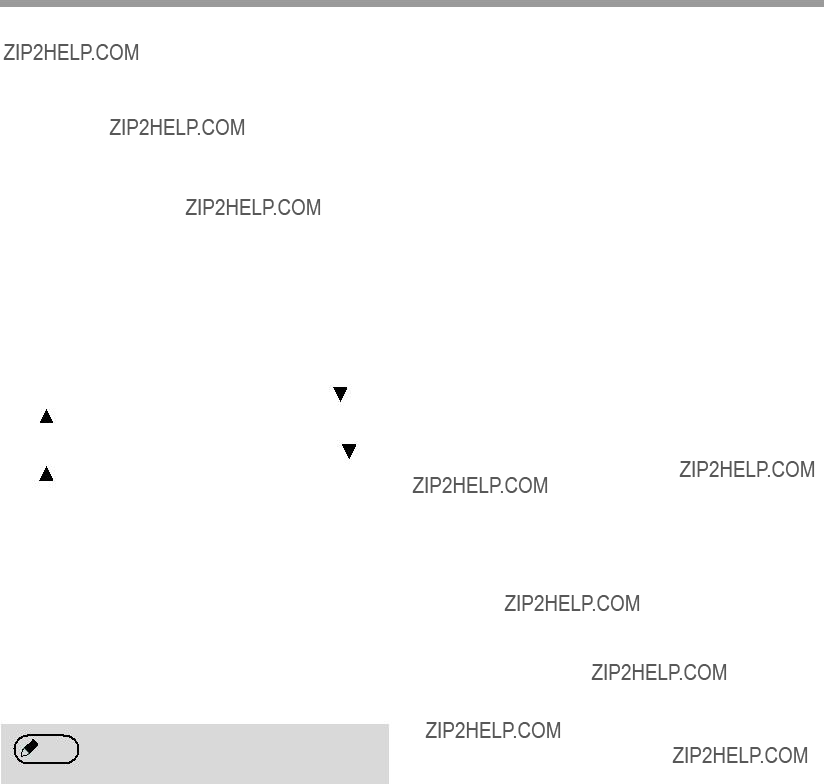
 ] or
] or ] key and then enter the correct digit.
] key and then enter the correct digit. 2:00 A.M.*
2:00 A.M.* 0:00 A.M.* * Varies depending on country and region.
0:00 A.M.* * Varies depending on country and region. ] or [
] or [  ] key and then press the [OK] key.
] key and then press the [OK] key. ] or [
] or [  ] key and then press the [OK] key.
] key and then press the [OK] key. ] or [
] or [  ] key and press the [OK] key.
] key and press the [OK] key. ] or [
] or [  ] key and press the [OK] key.
] key and press the [OK] key.
 will be rotated to a horizontal orientation
will be rotated to a horizontal orientation  before transmission. Rotation is normally enabled, and vertically oriented originals are rotated counterclockwise. (A4, A5R and
before transmission. Rotation is normally enabled, and vertically oriented originals are rotated counterclockwise. (A4, A5R and  are not rotated.)
are not rotated.) ] or [
] or [ ] key and then press the [OK] key.
] key and then press the [OK] key. ] or [
] or [ ] key and then press the [OK] key.
] key and then press the [OK] key.

 ]
] ] key and enter the correct number.
] key and enter the correct number. ] or [
] or [  ] key and then press the [OK] key.
] key and then press the [OK] key. ] or [
] or [  ] key and then press the [OK] key.
] key and then press the [OK] key. ] or [
] or [ ]
] ] or [
] or [  ] key and then press the [OK] key.
] key and then press the [OK] key. ] or [
] or [  ] key and then press the [OK] key.
] key and then press the [OK] key. ] or [
] or [  ] key and then press the [OK] key.
] key and then press the [OK] key. ] or [
] or [  ] key and then press the [OK] key.
] key and then press the [OK] key.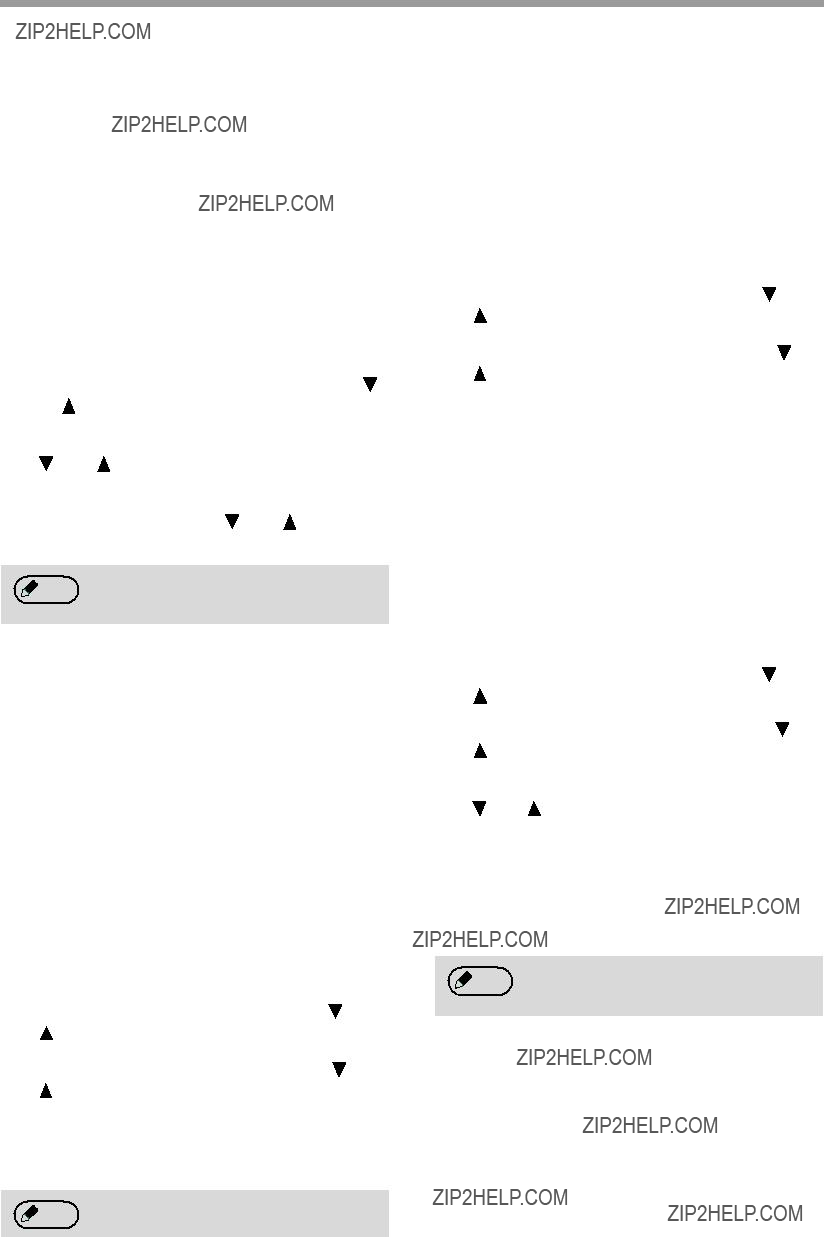

 ] or [
] or [  ] key and then press the [OK] key.
] key and then press the [OK] key. ] or [
] or [  ] key and then press the [OK] key.
] key and then press the [OK] key. ] or [
] or [  ] key and then press the [OK] key.
] key and then press the [OK] key. ] or [
] or [  ] key and then press the [OK] key.
] key and then press the [OK] key. ] or [
] or [  ] key and then press the [OK] key.
] key and then press the [OK] key. ] or [
] or [  ] key and then press the [OK] key.
] key and then press the [OK] key. ] or [
] or [  ] key and then press the [OK] key.
] key and then press the [OK] key.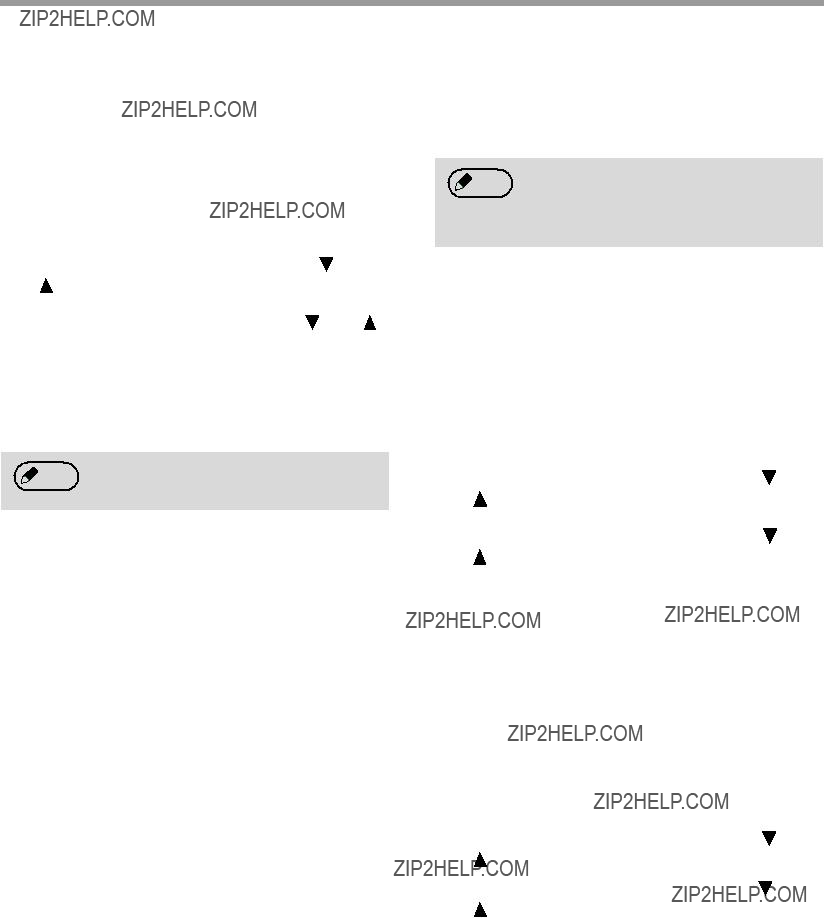
 ] or [
] or [  ] key and then press the [OK] key.
] key and then press the [OK] key. ] or [
] or [  ] key and then press the [OK] key.
] key and then press the [OK] key. ] or [
] or [  ] key and then press the [OK] key.
] key and then press the [OK] key. ] or [
] or [  ] key and then press the [OK] key.
] key and then press the [OK] key.
 ] or [
] or [  ] key and then press the [OK] key.
] key and then press the [OK] key. ] or [
] or [  ] key and then press the [OK] key.
] key and then press the [OK] key. ] or [
] or [  ] key and then press the [OK] key.
] key and then press the [OK] key. ] or [
] or [  ] key and then press the [OK] key.
] key and then press the [OK] key. ] or [
] or [  ] key and then press the [OK] key.
] key and then press the [OK] key. ] or [
] or [  ] key and then press the [OK] key.
] key and then press the [OK] key. ] or [
] or [ ] keys and enter the correct number.
] keys and enter the correct number. ] or [
] or [  ] key and then press the [OK] key.
] key and then press the [OK] key.




